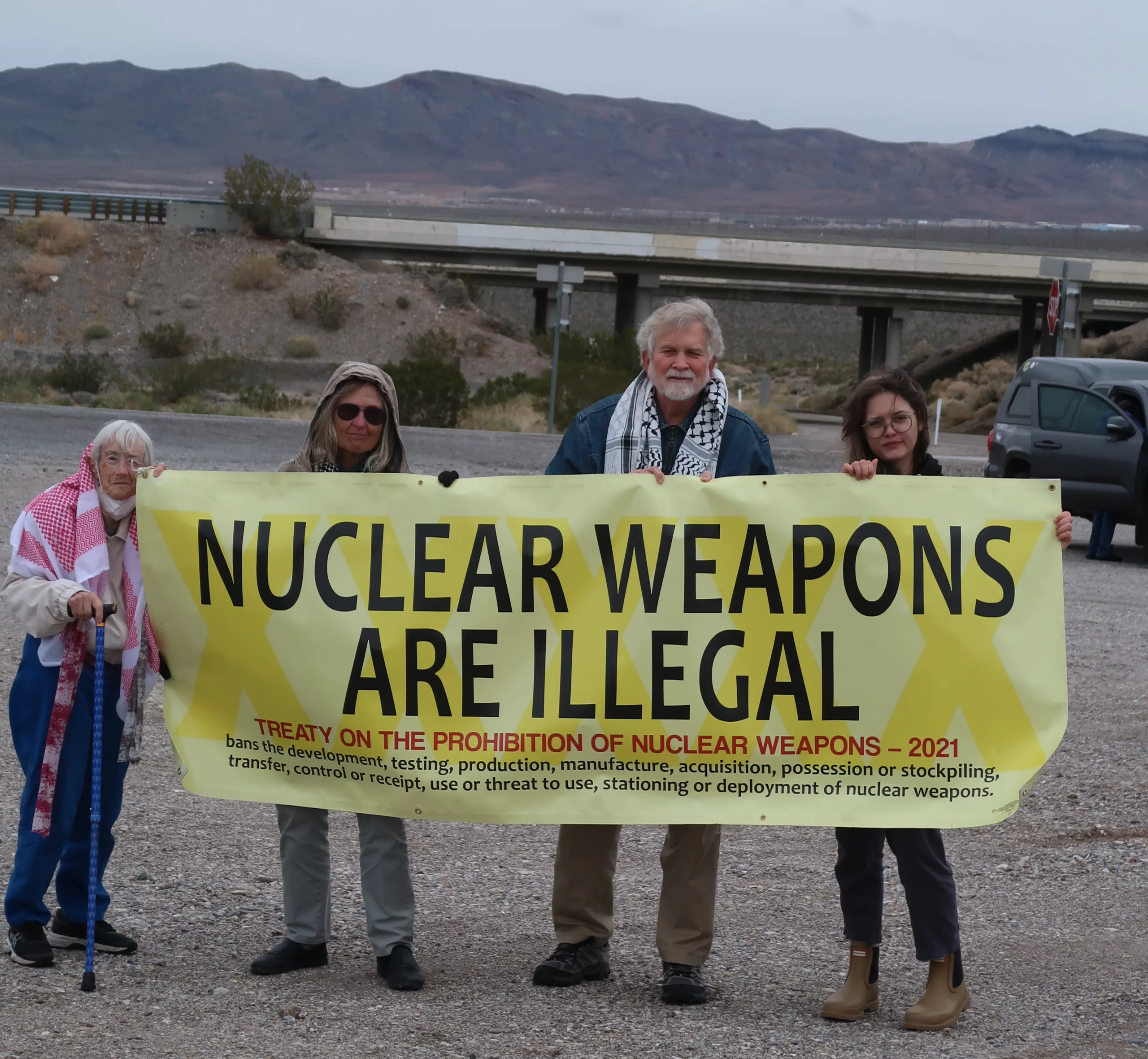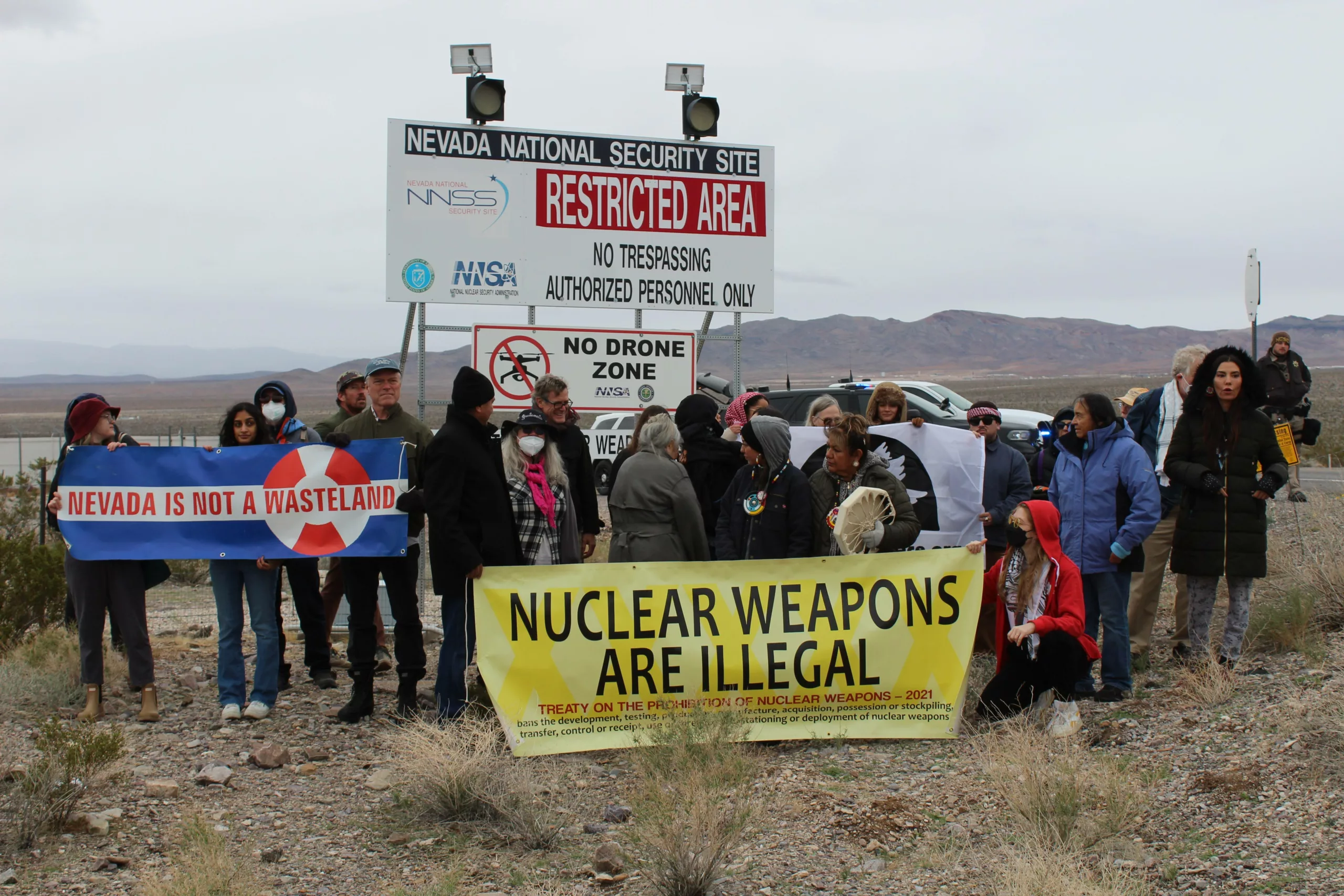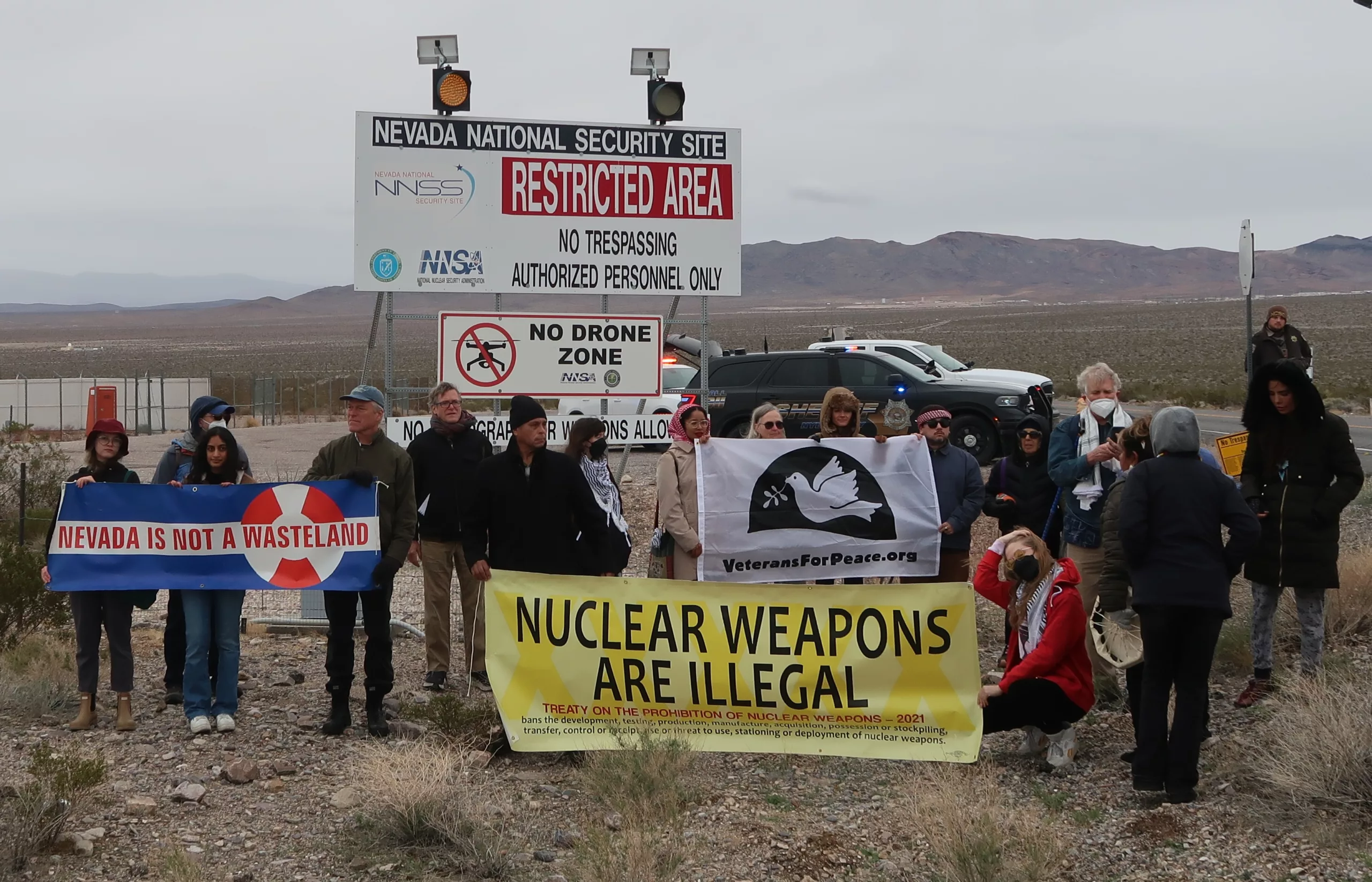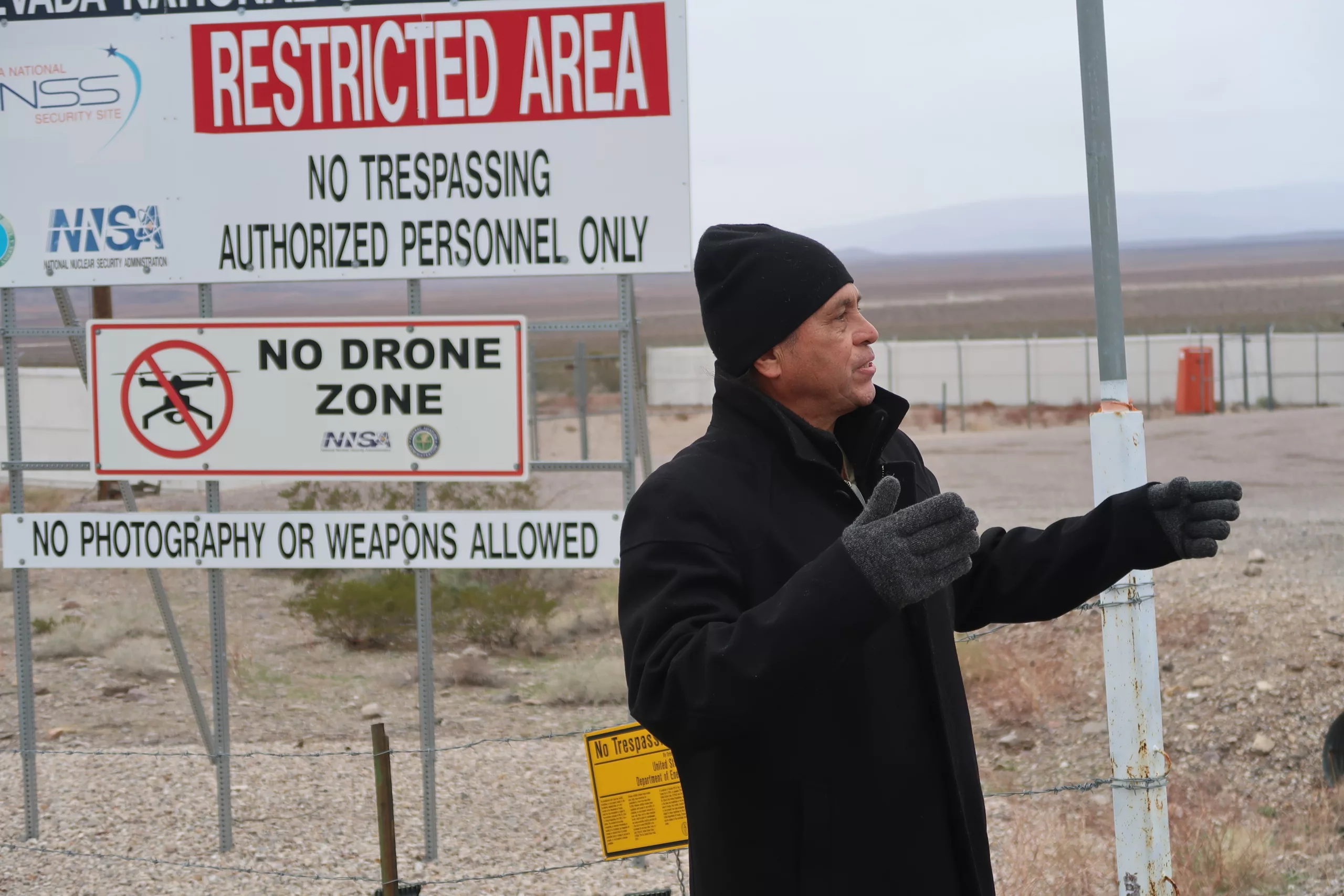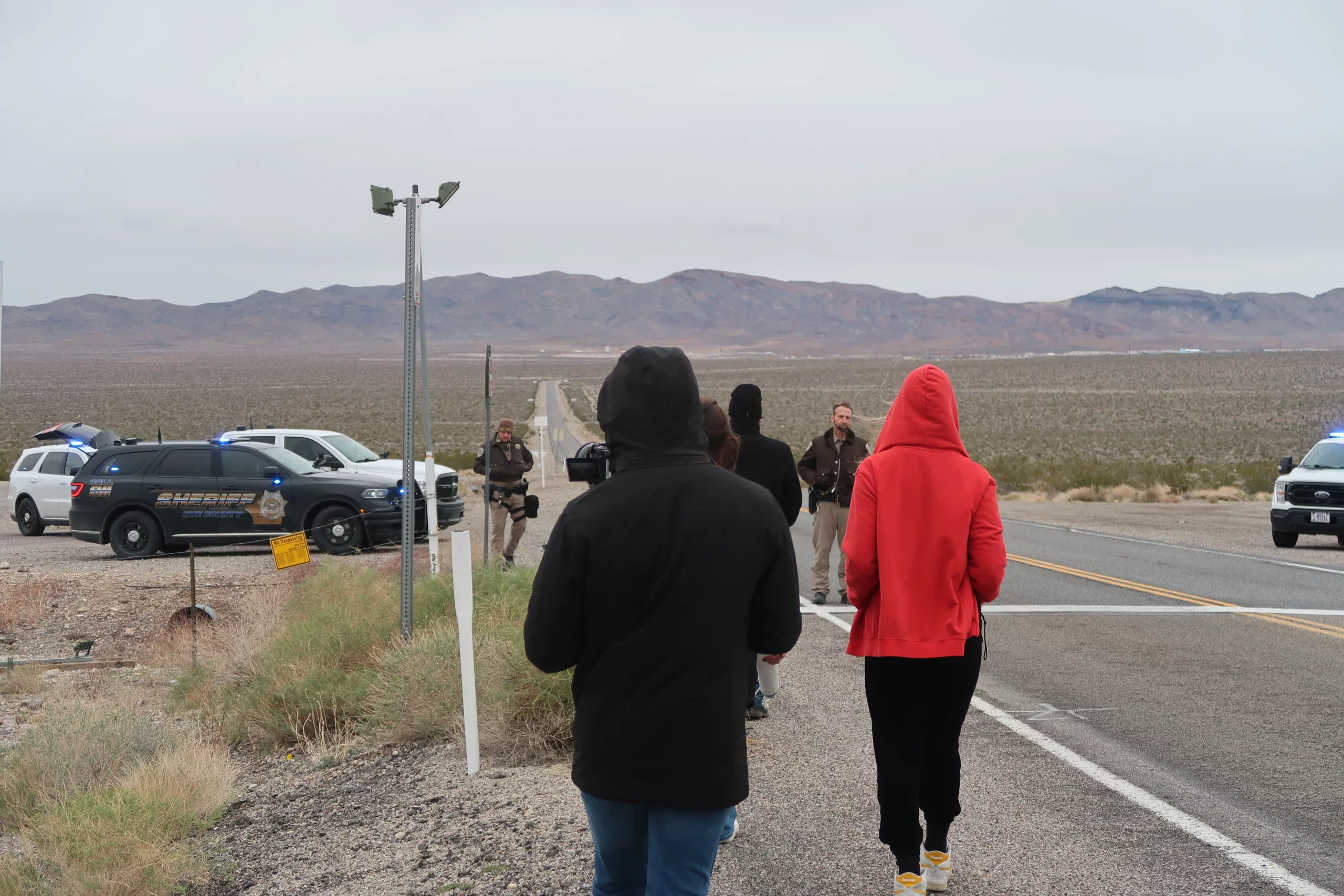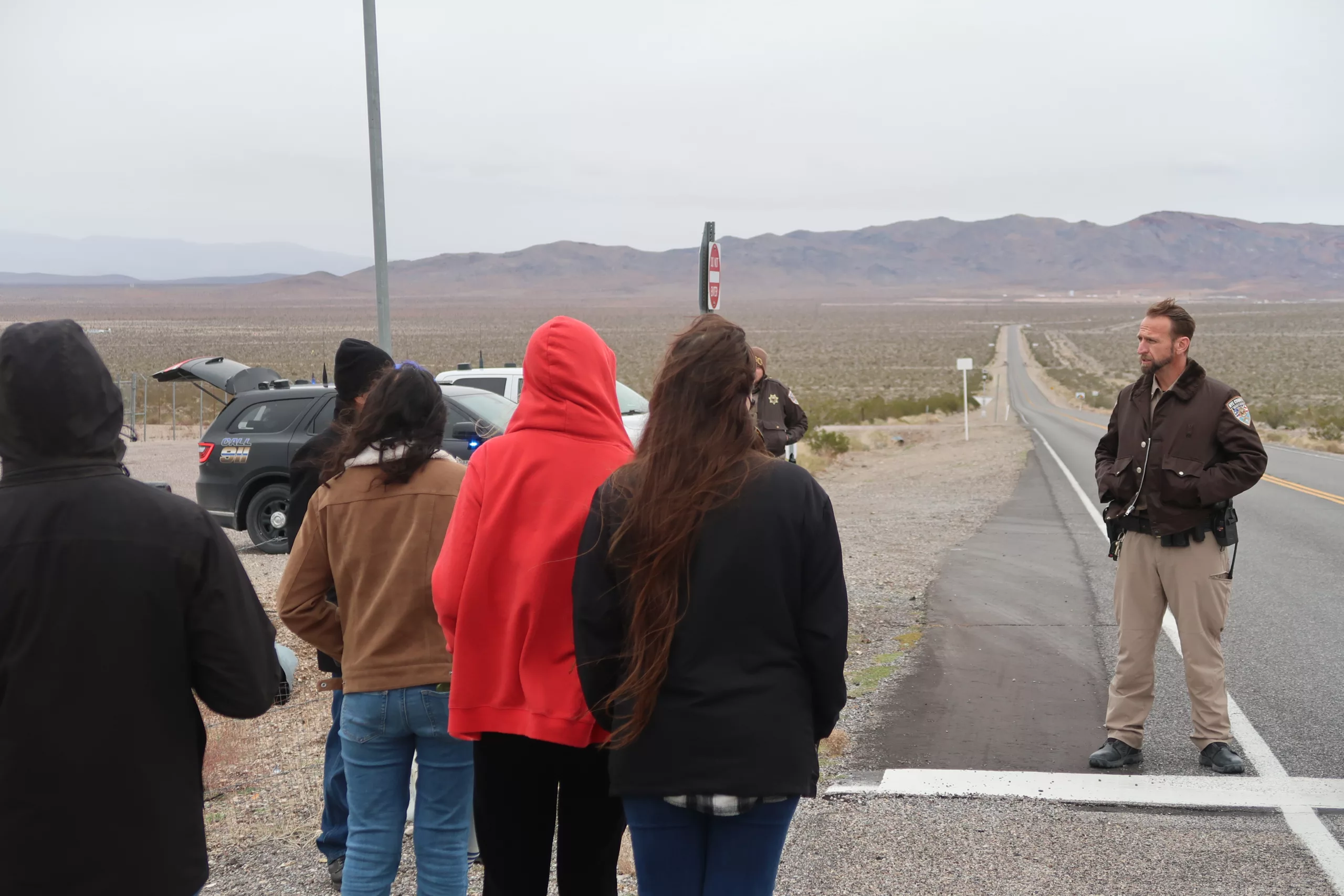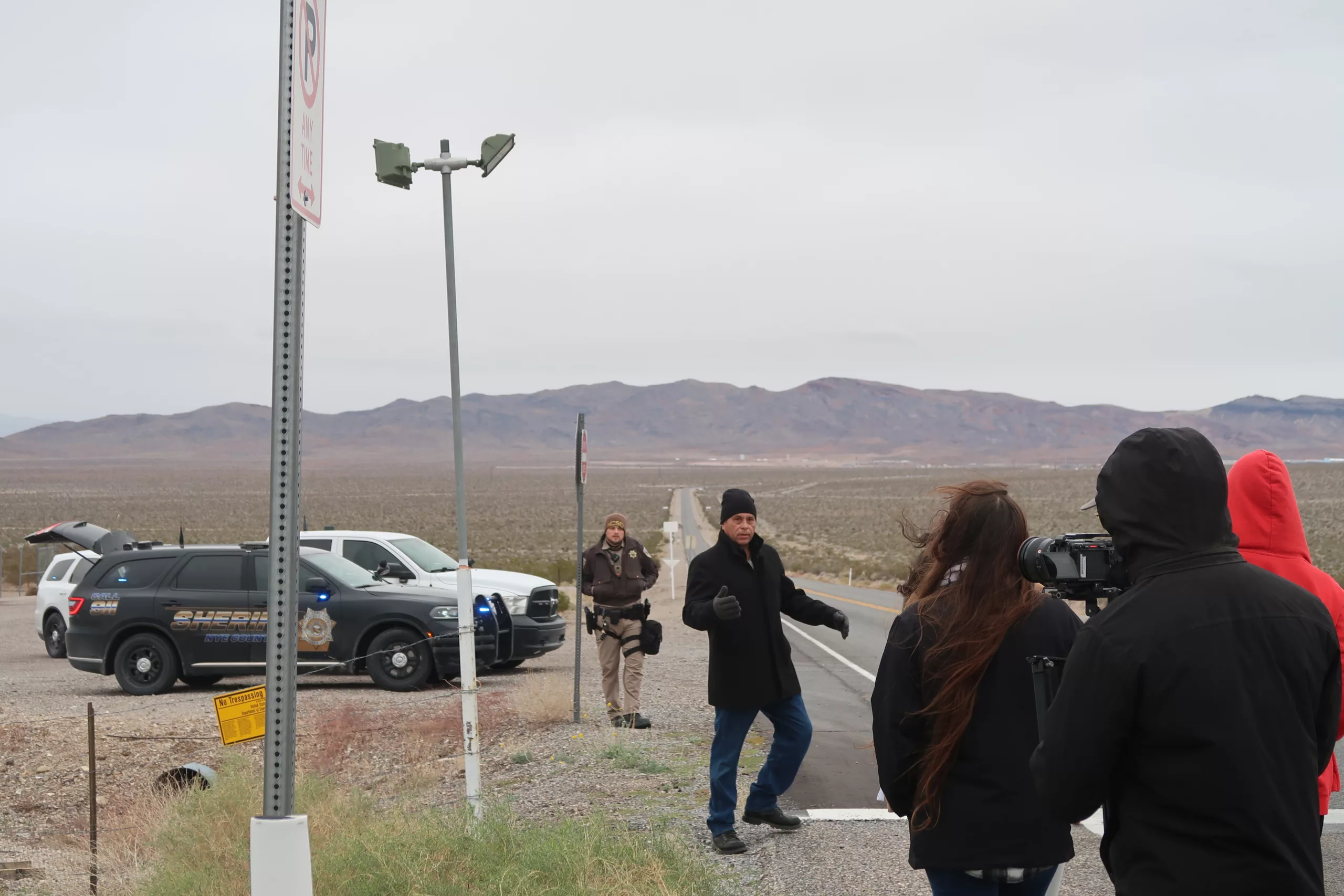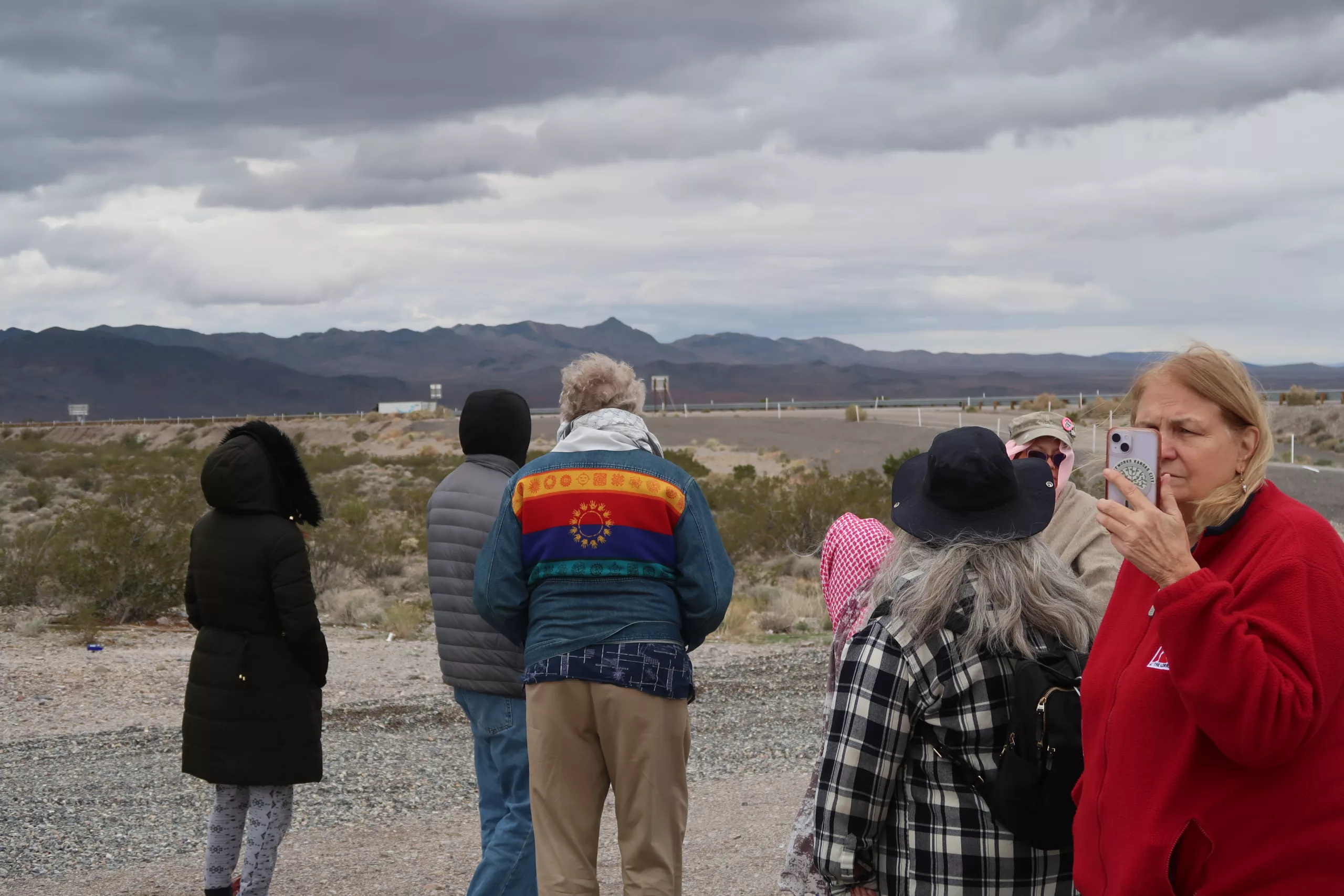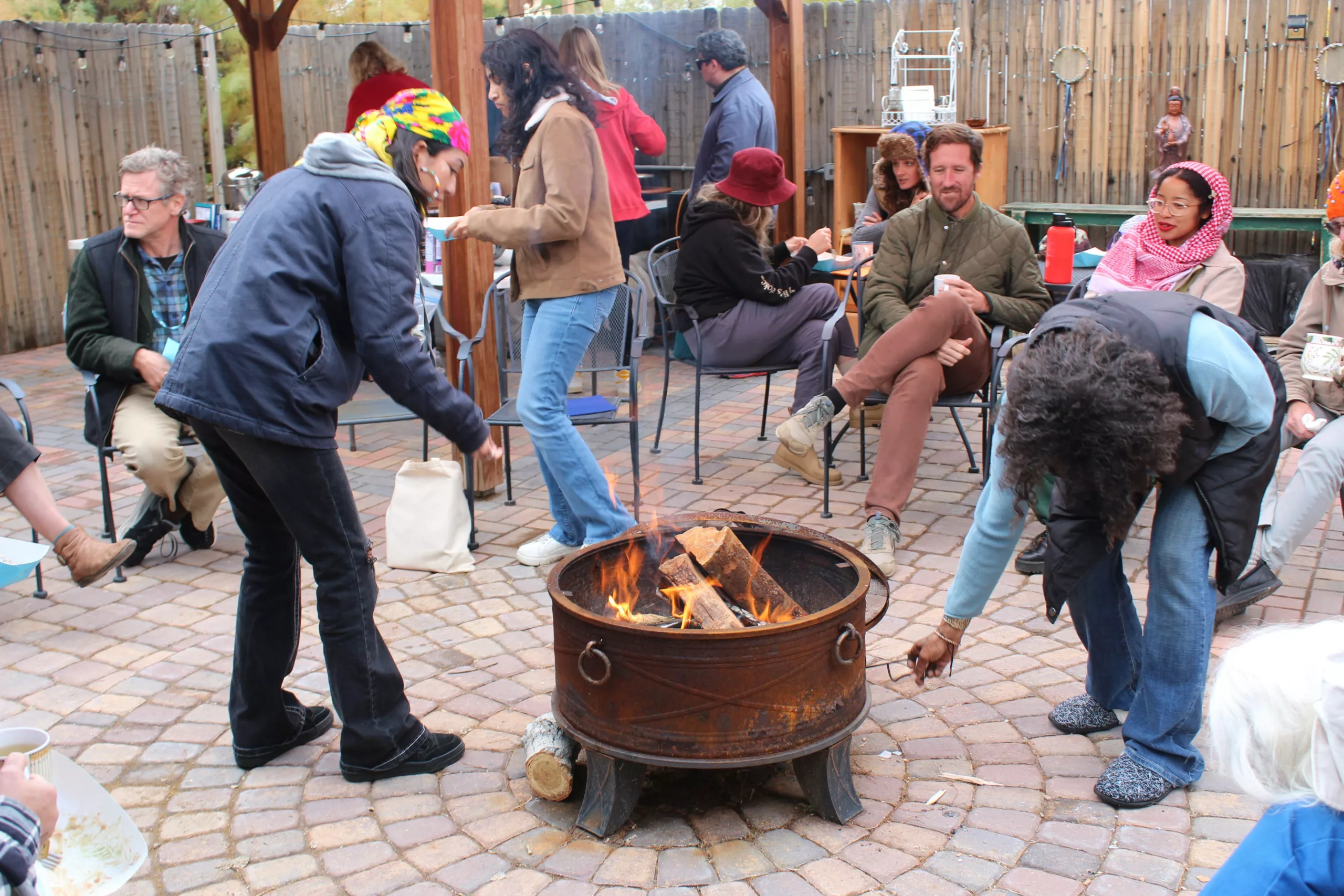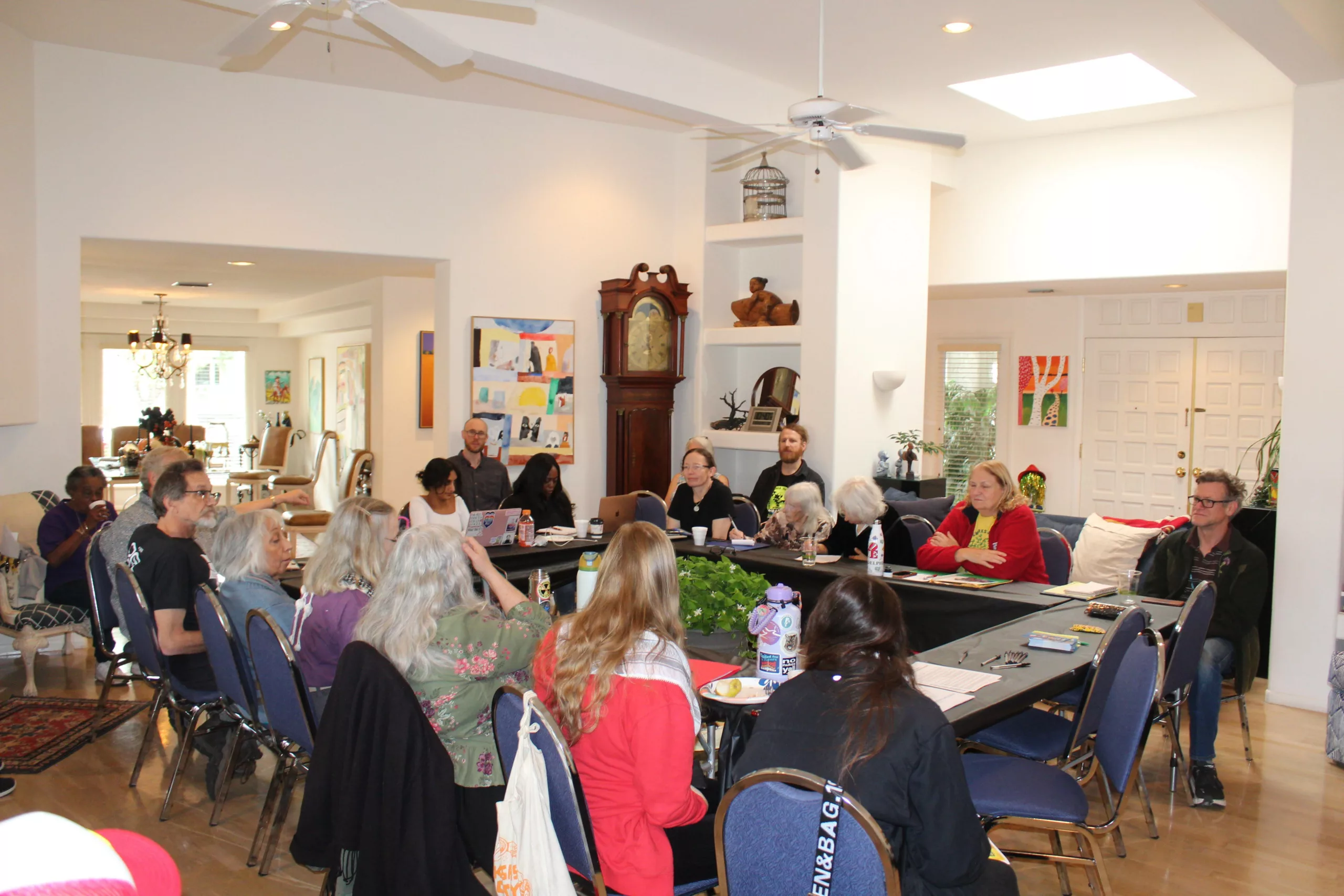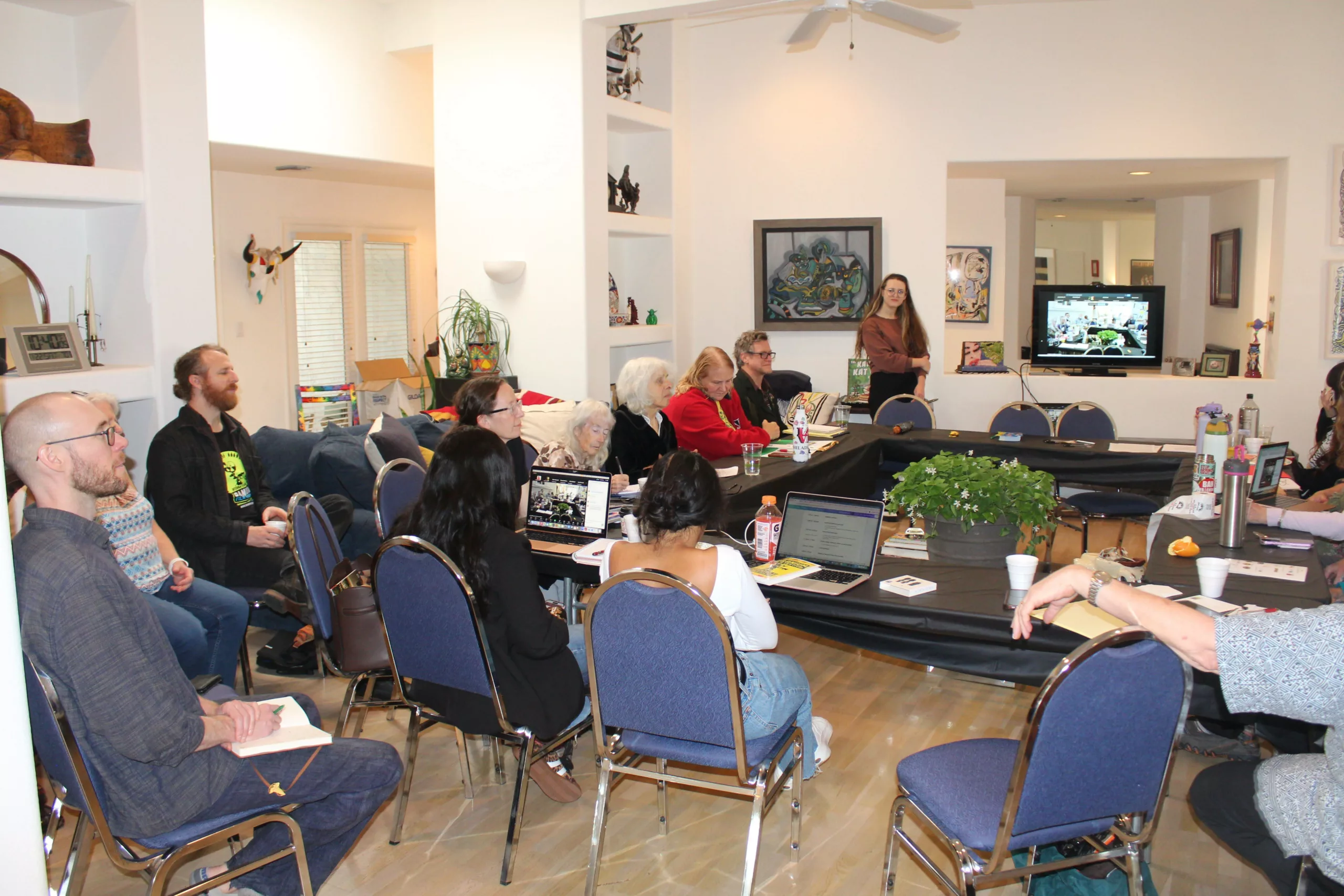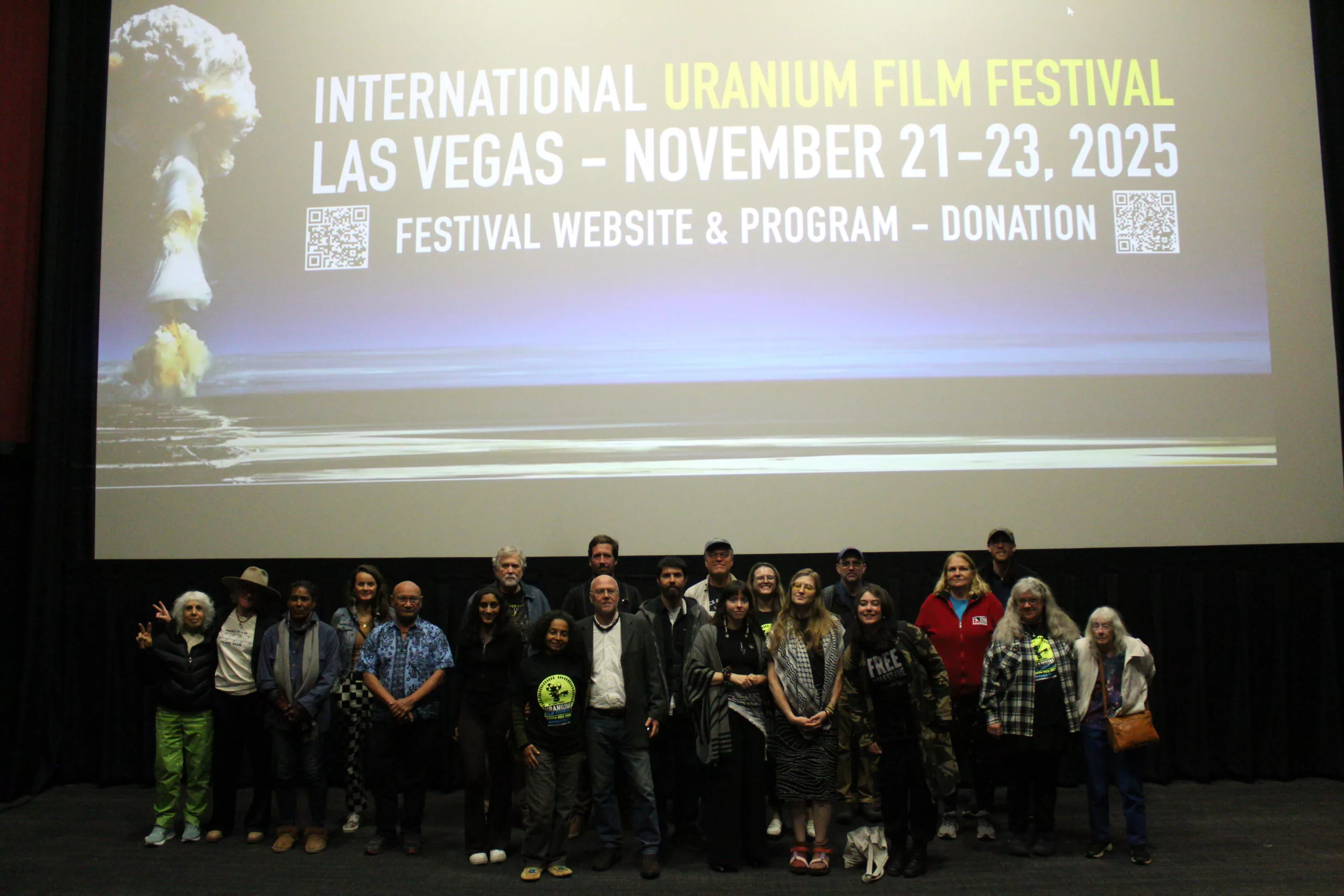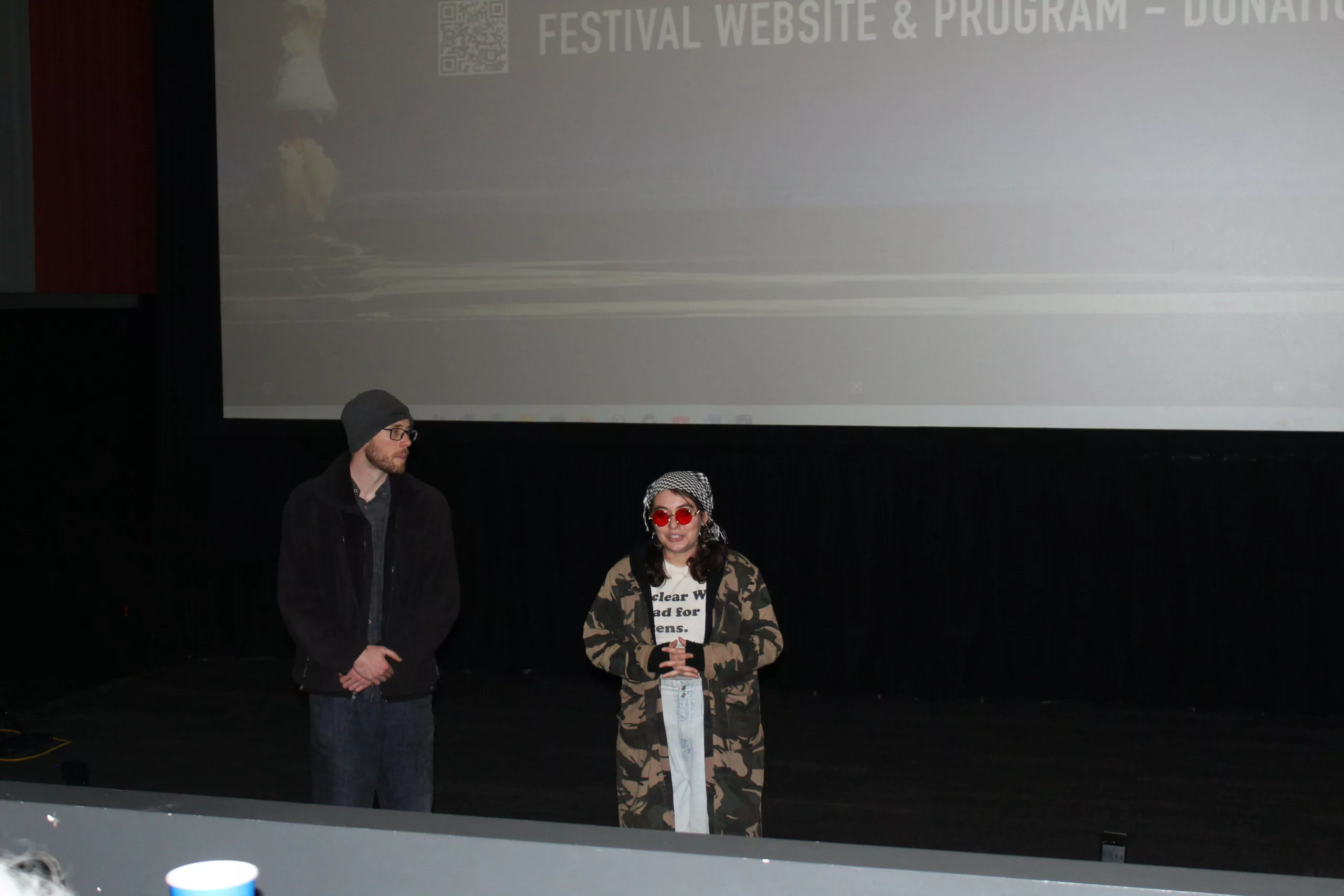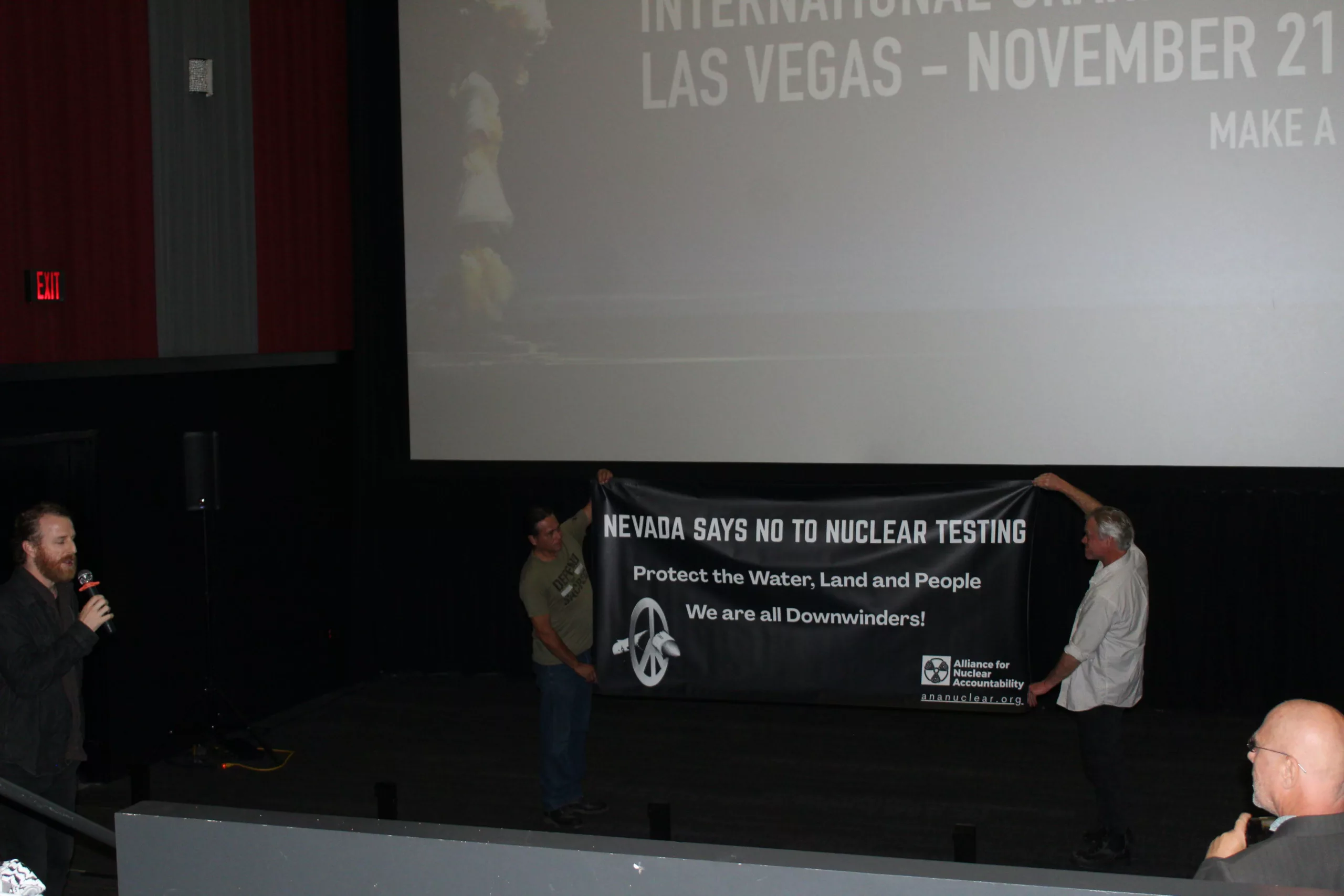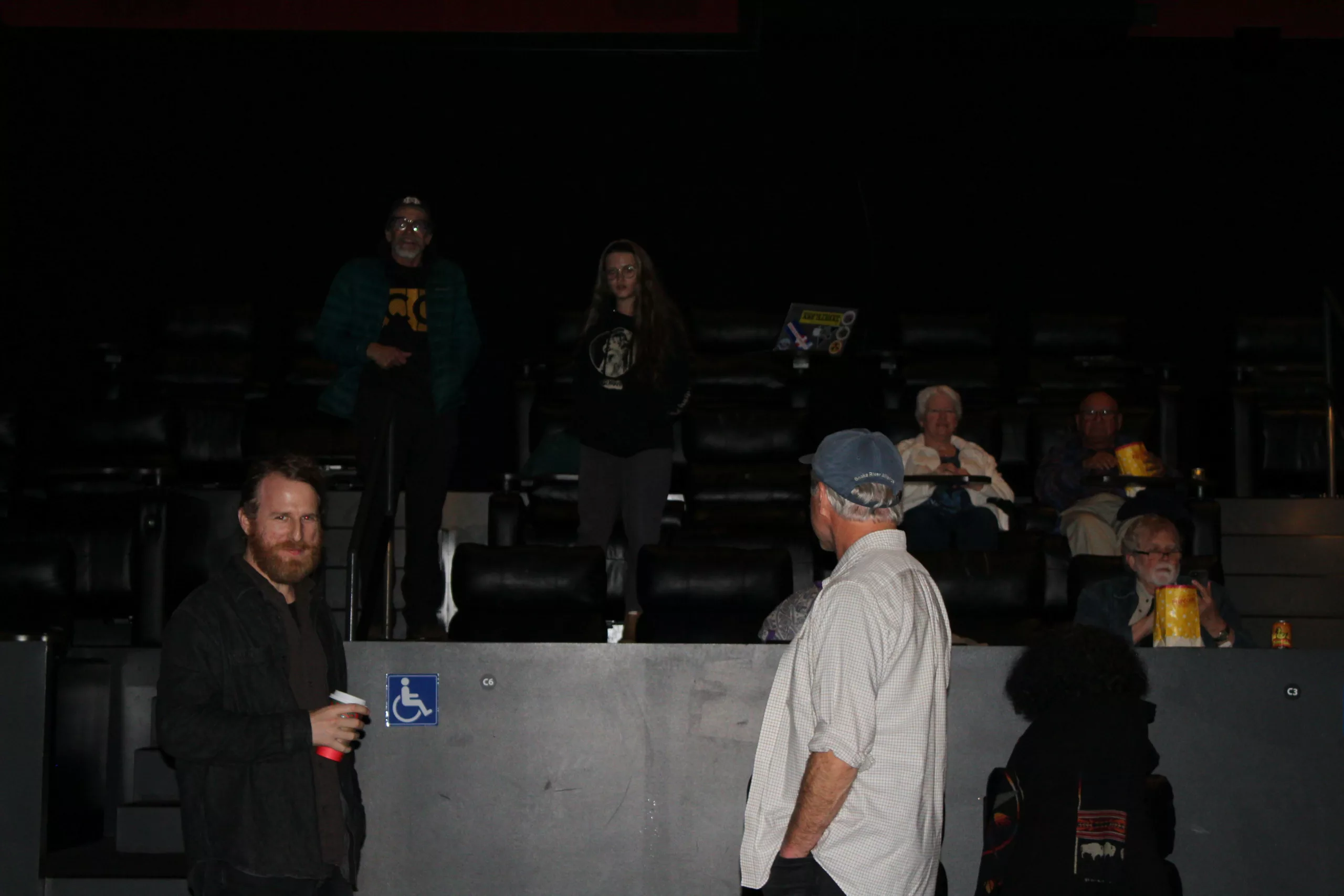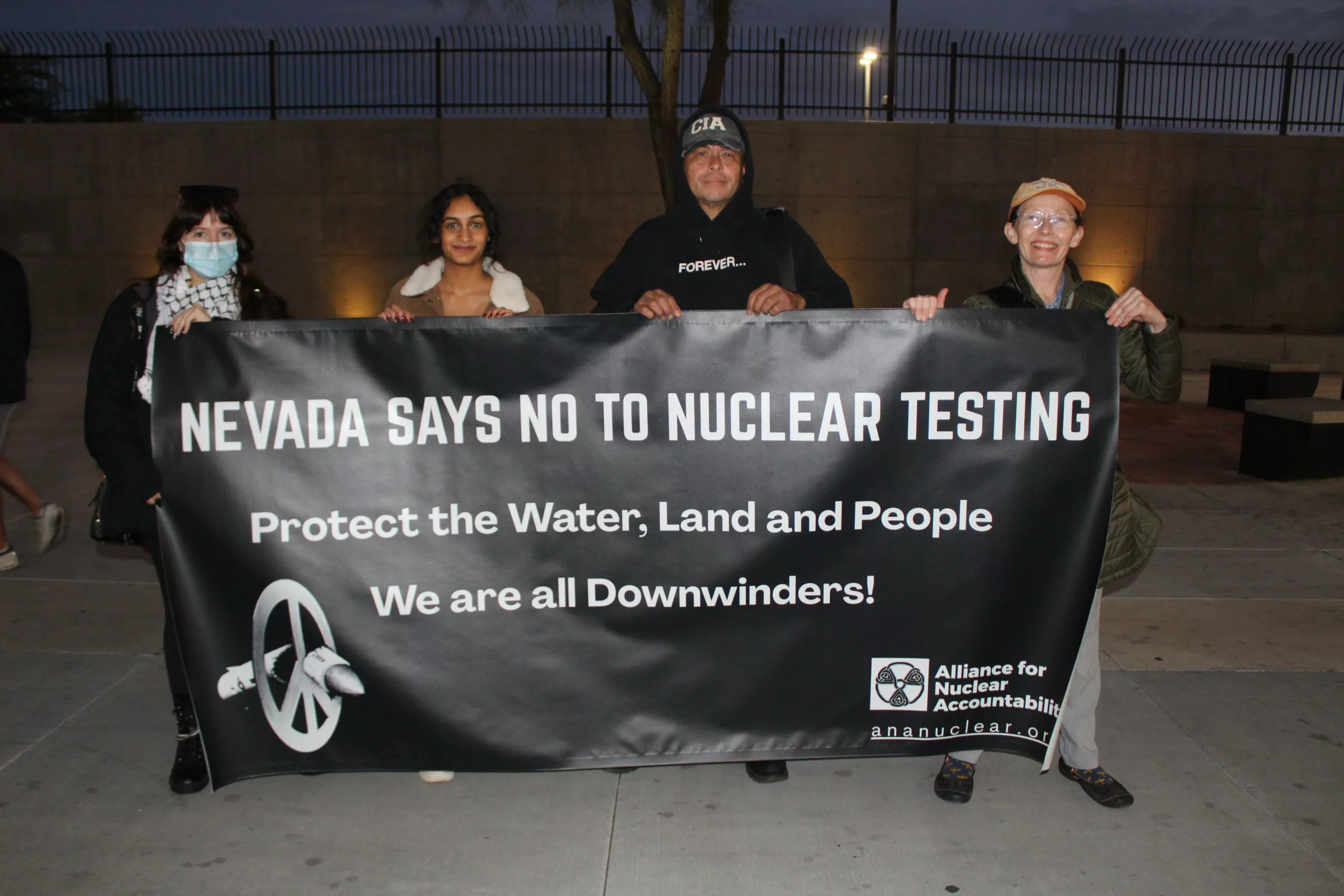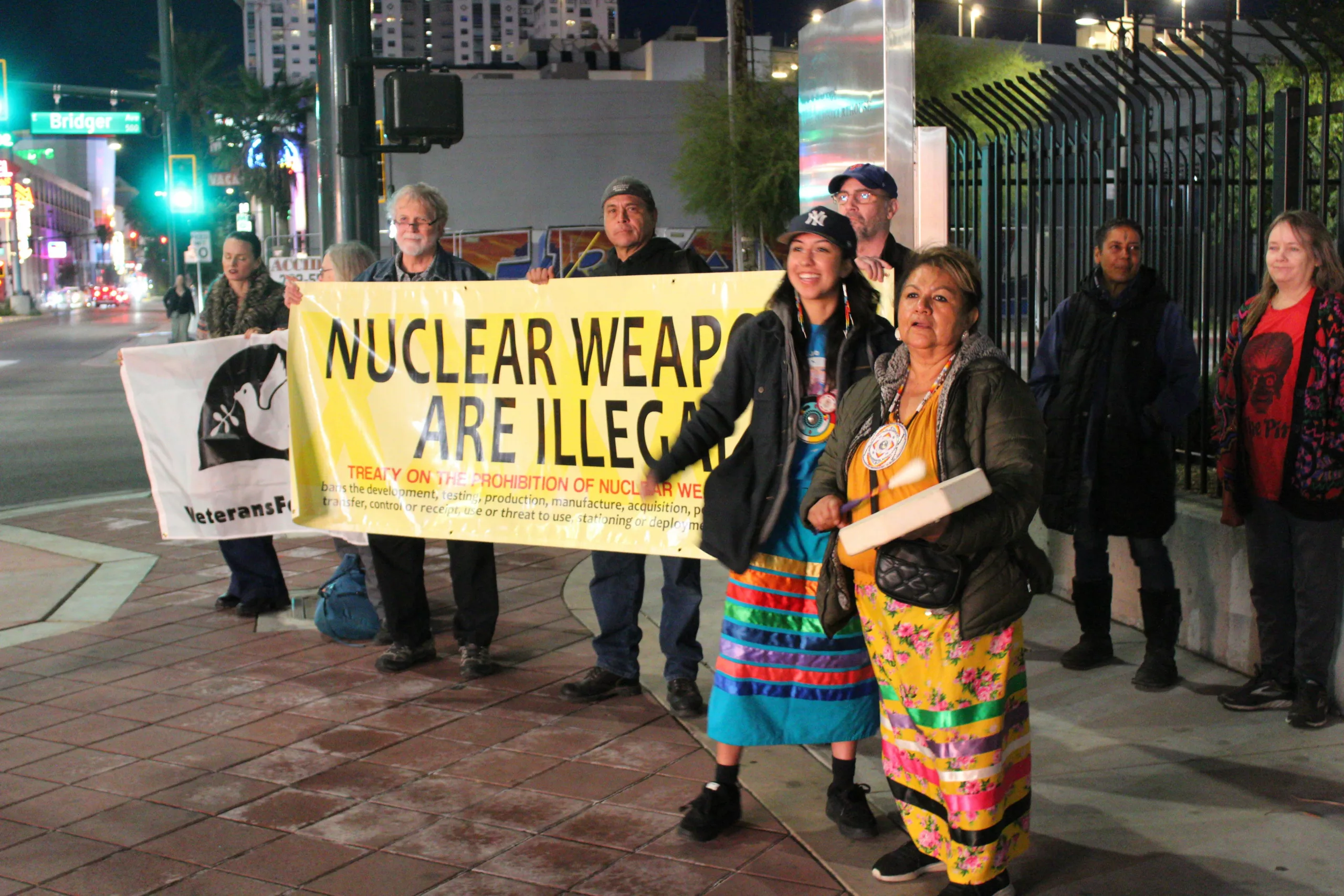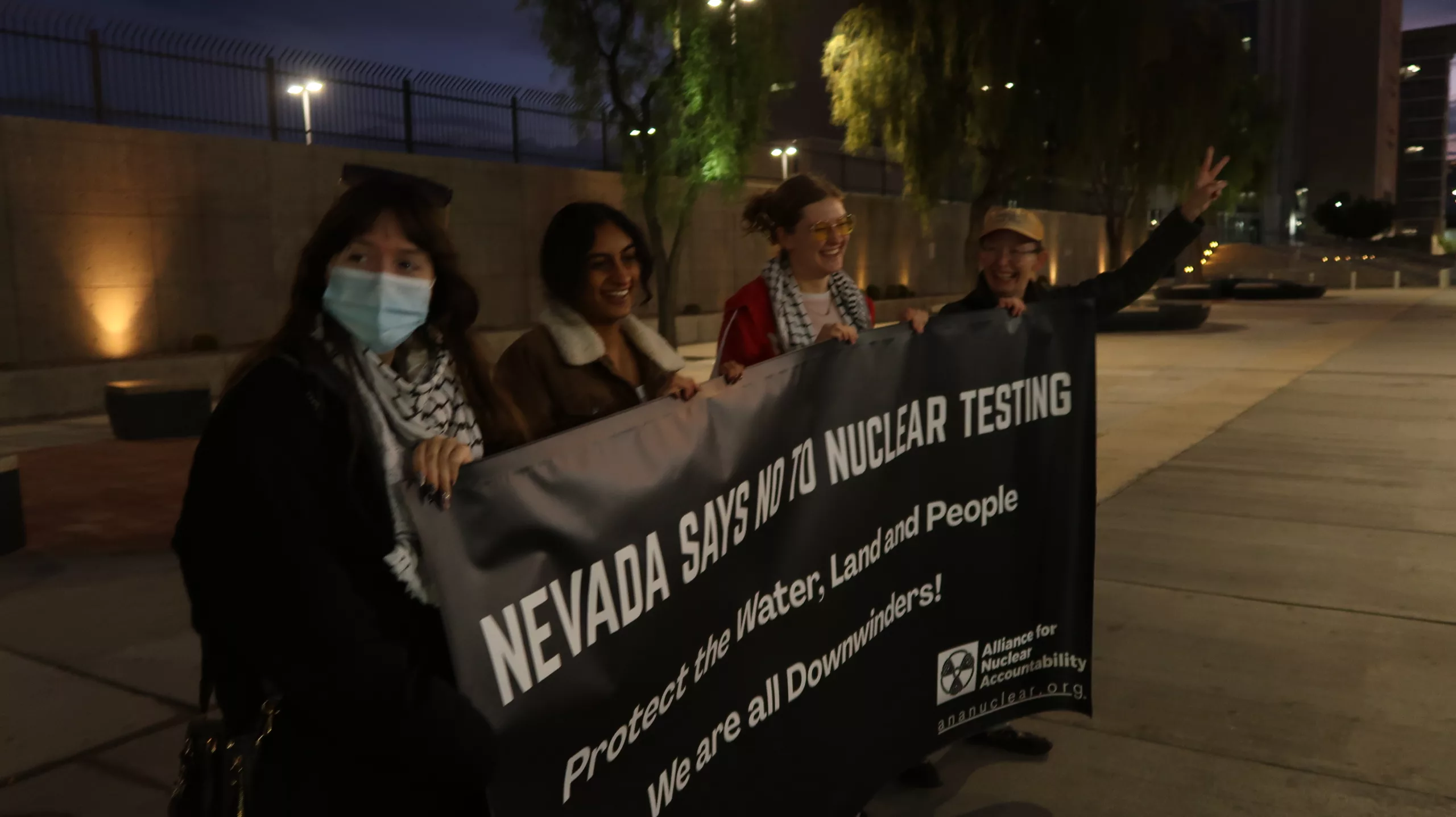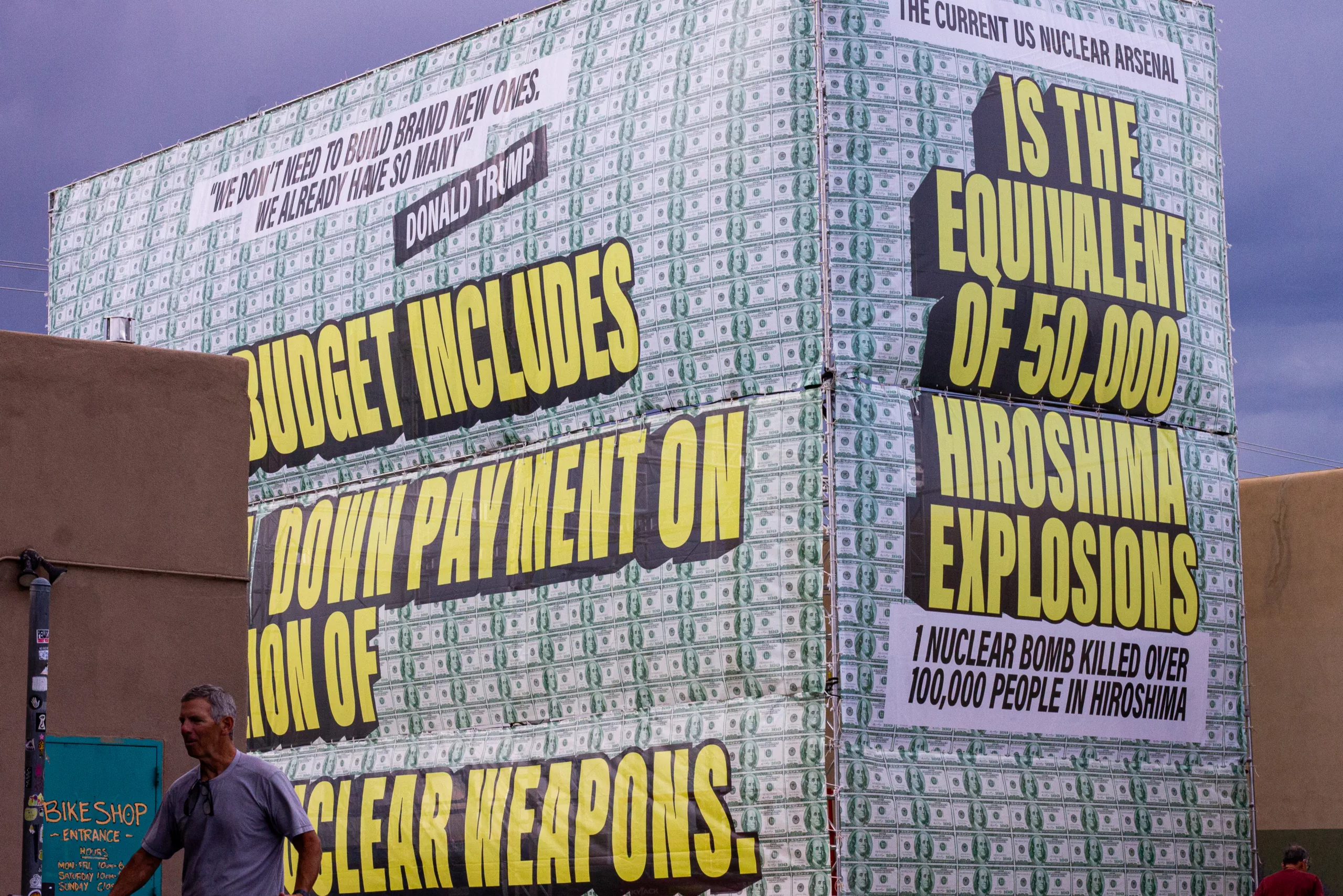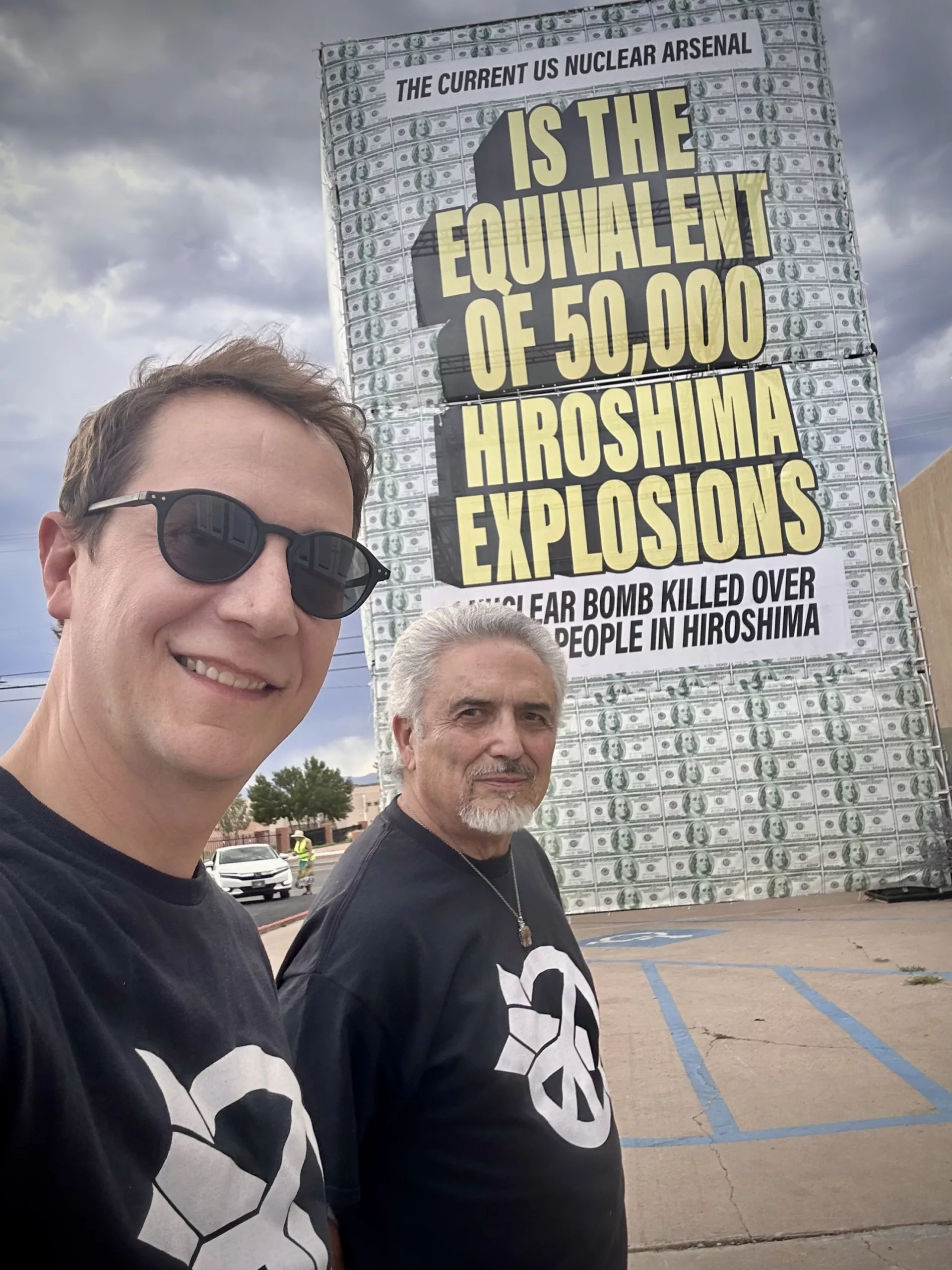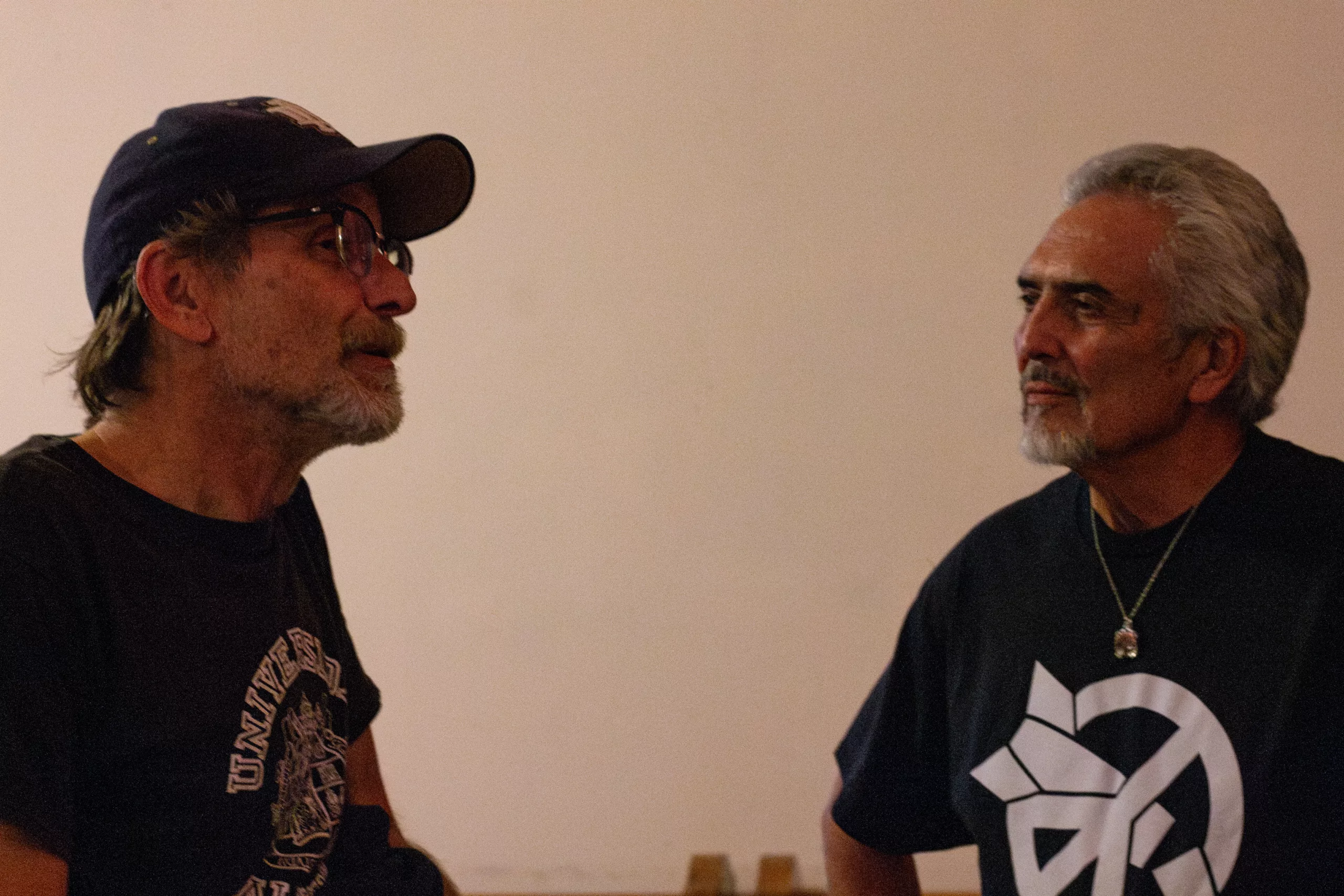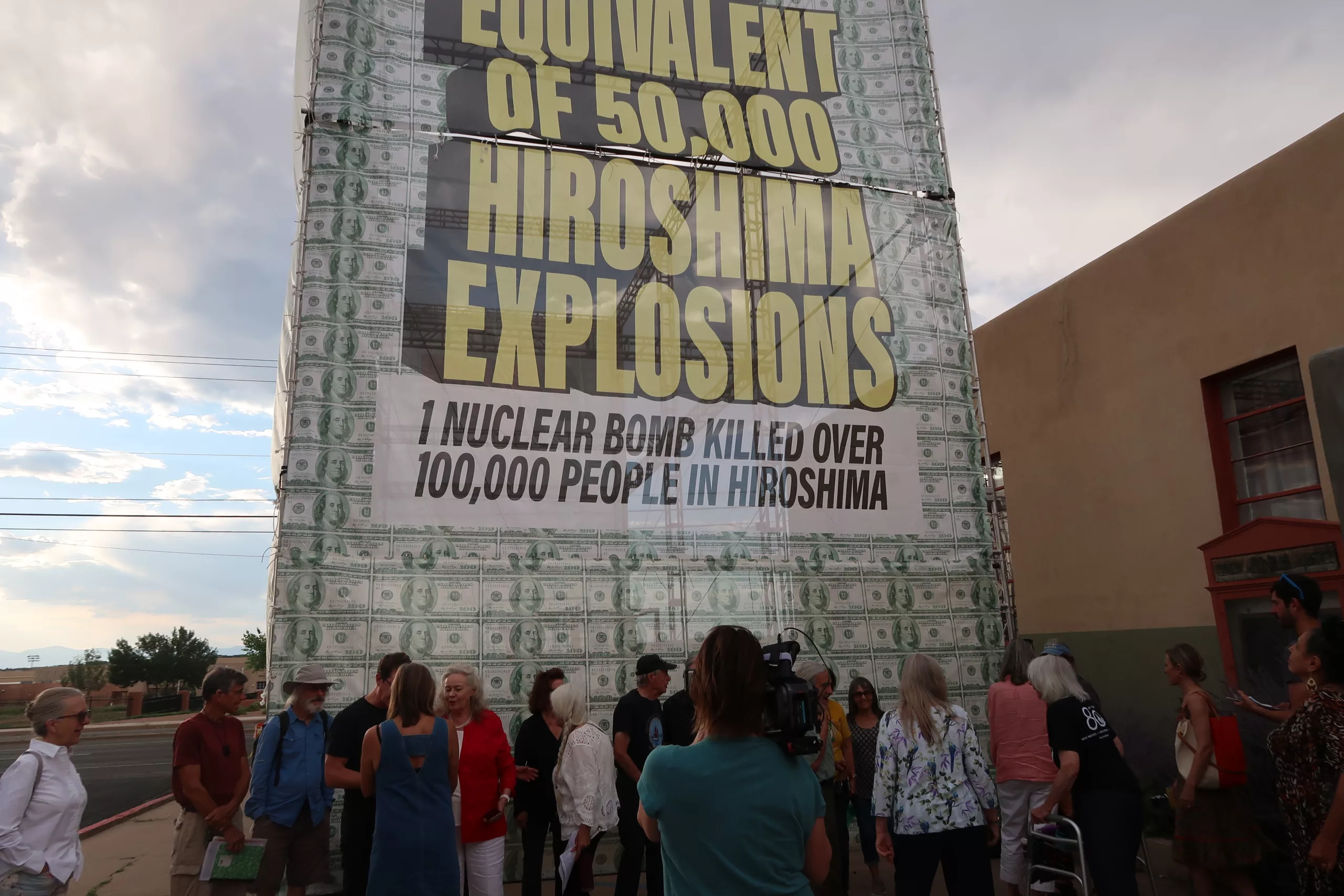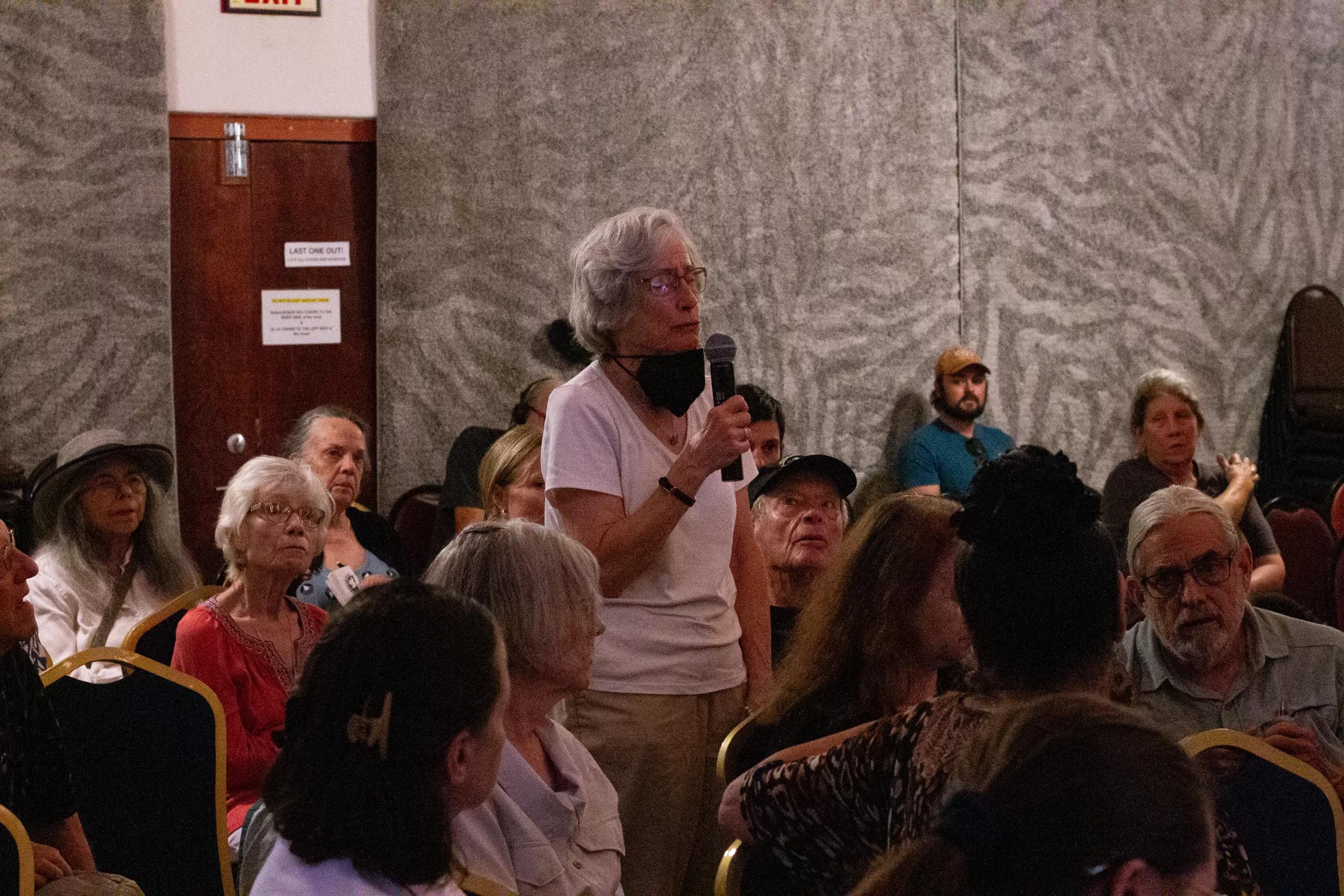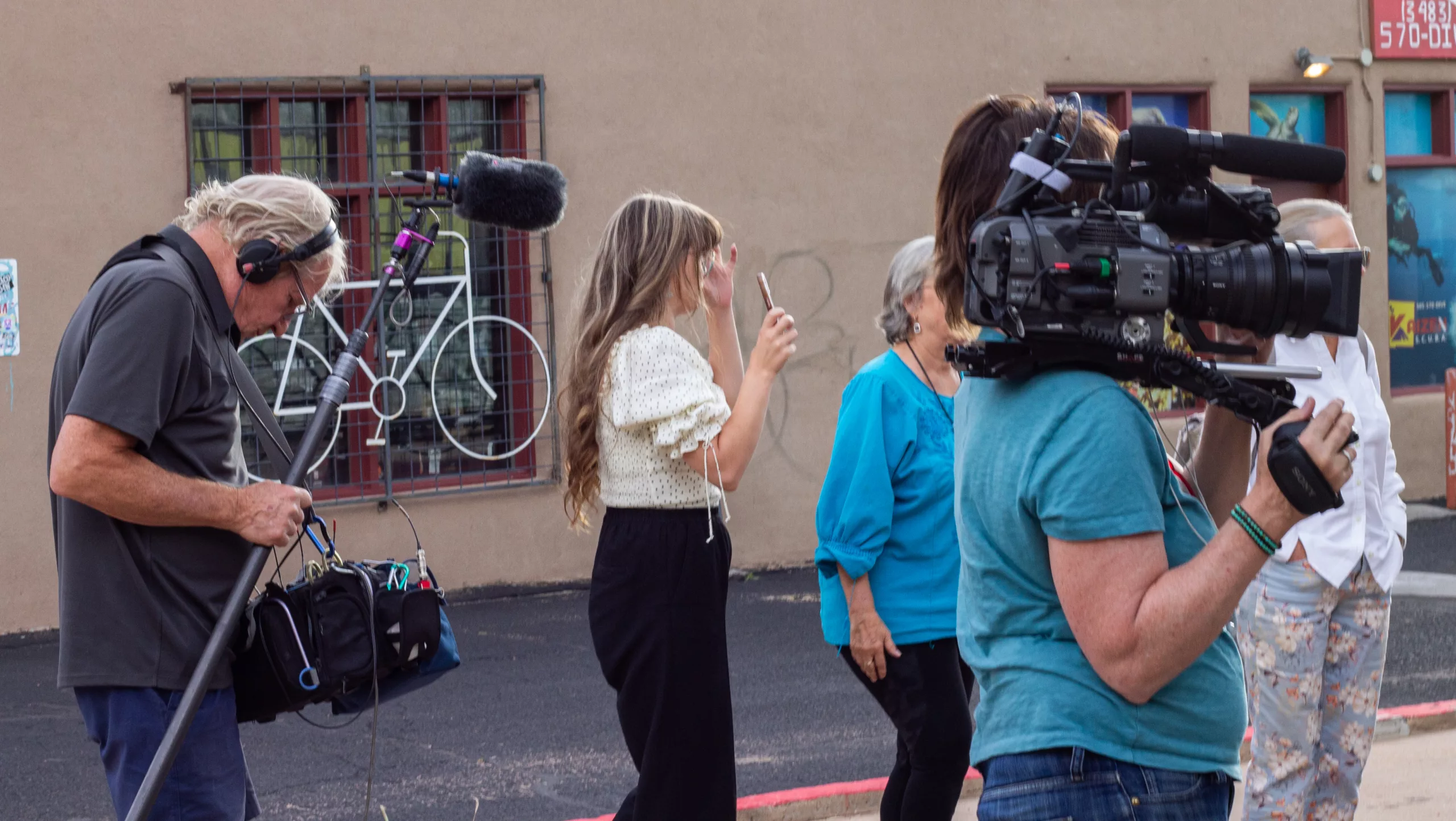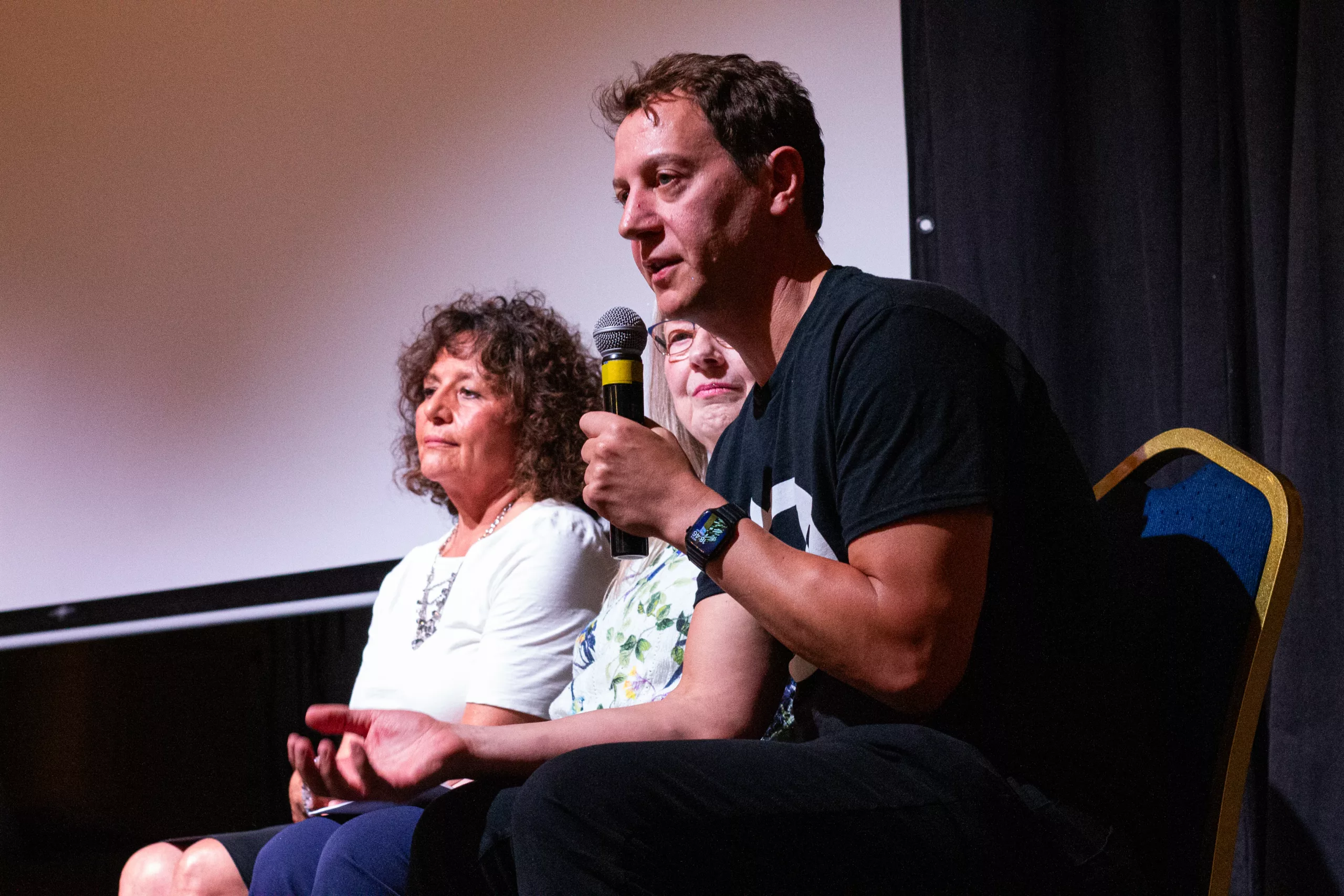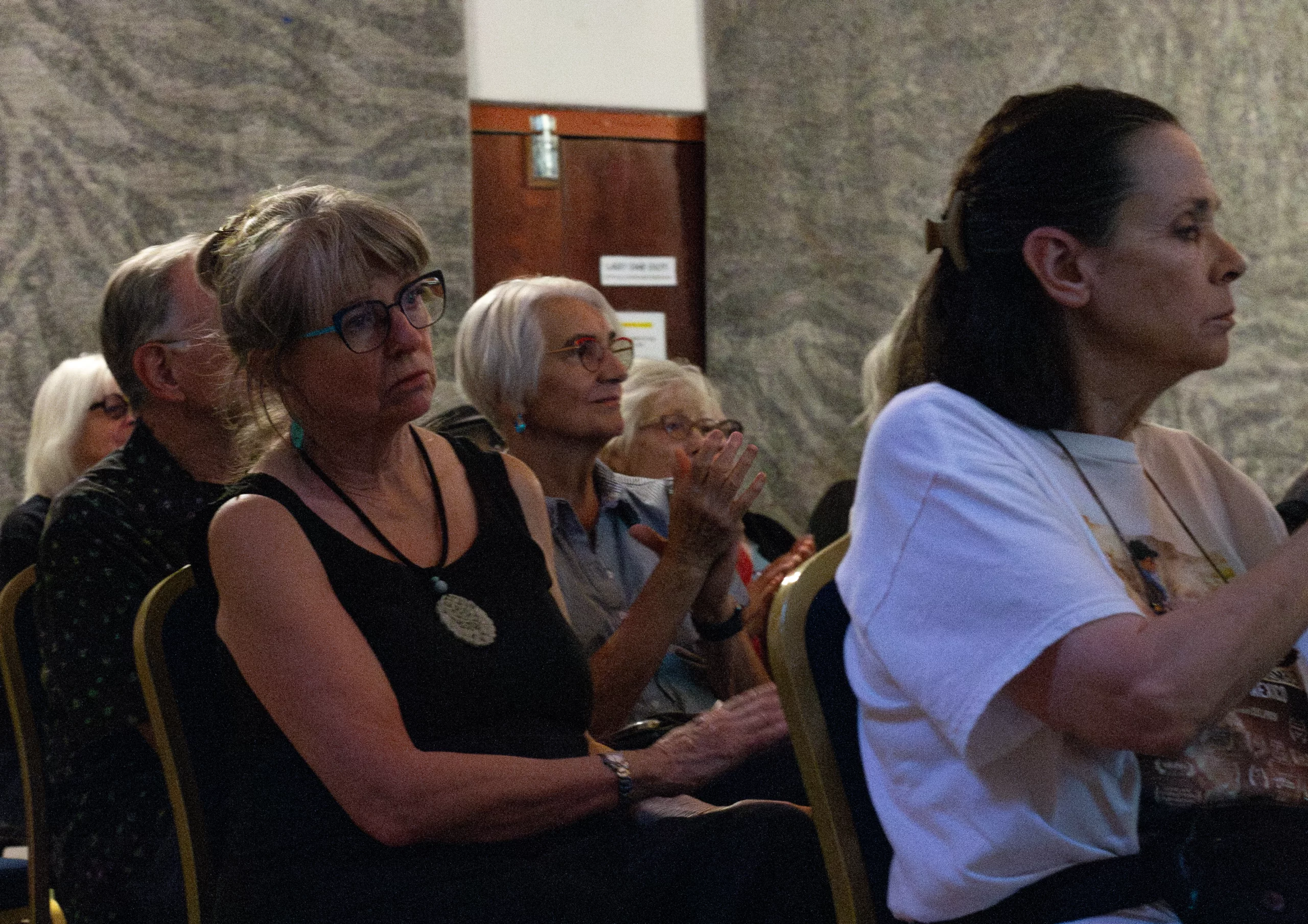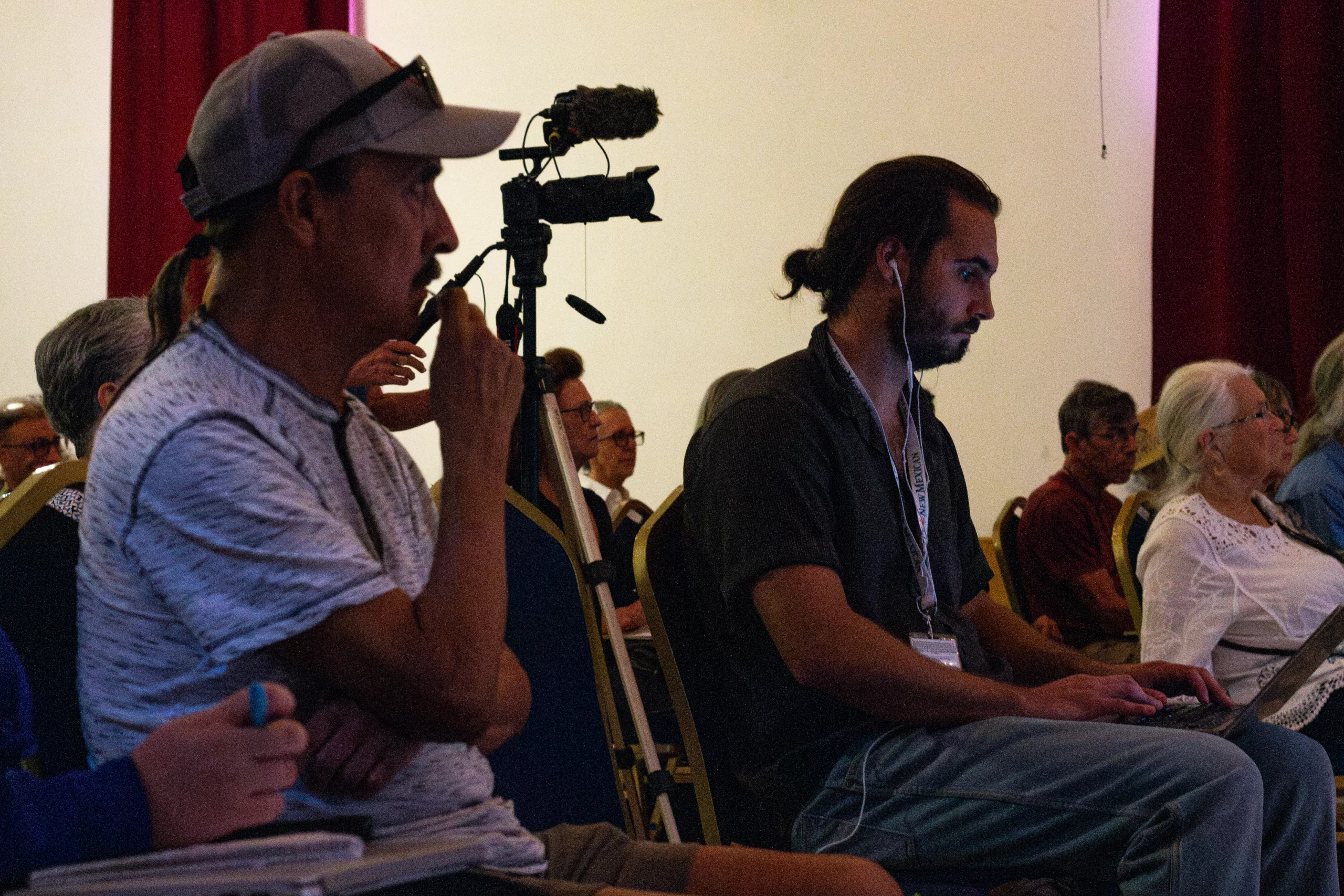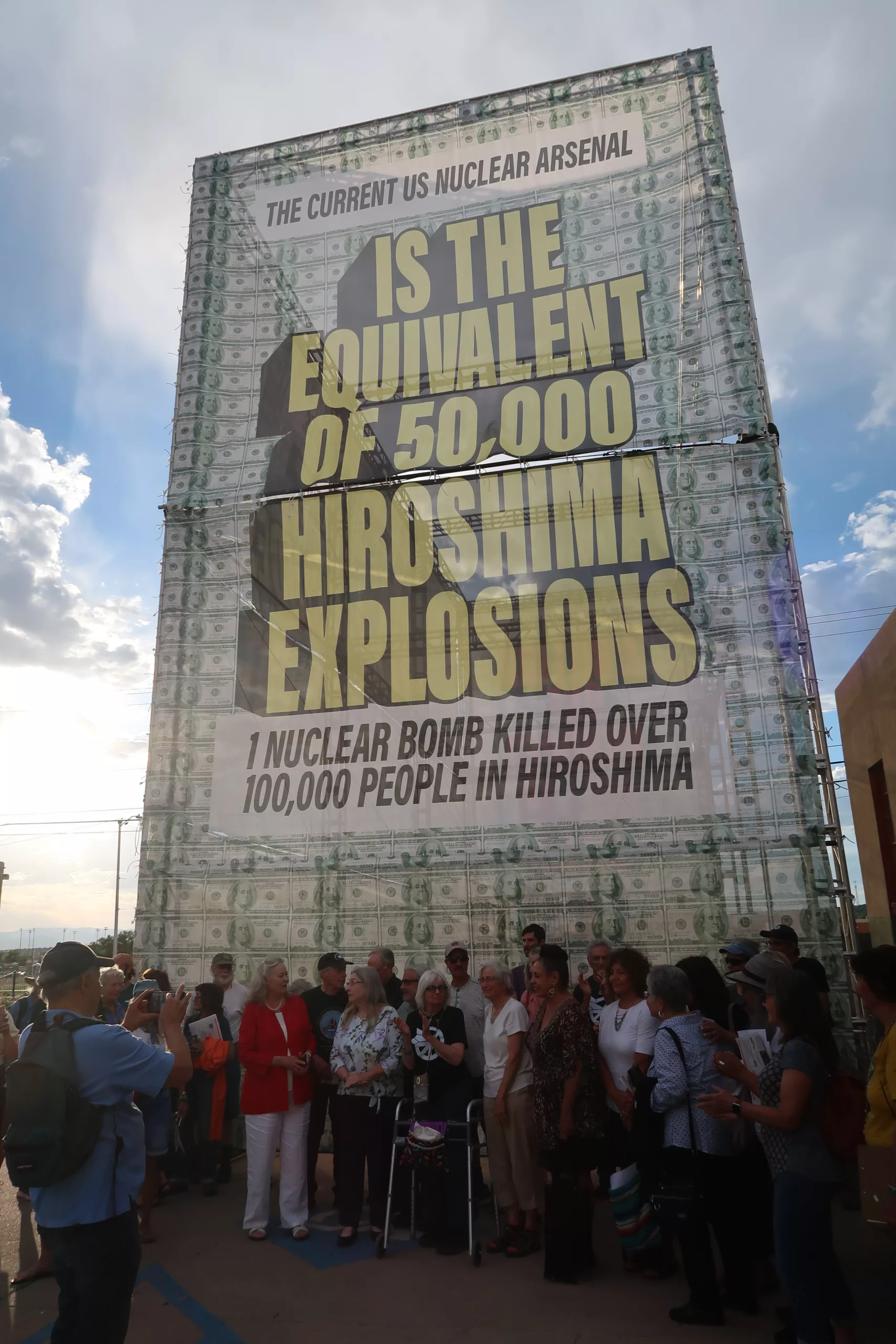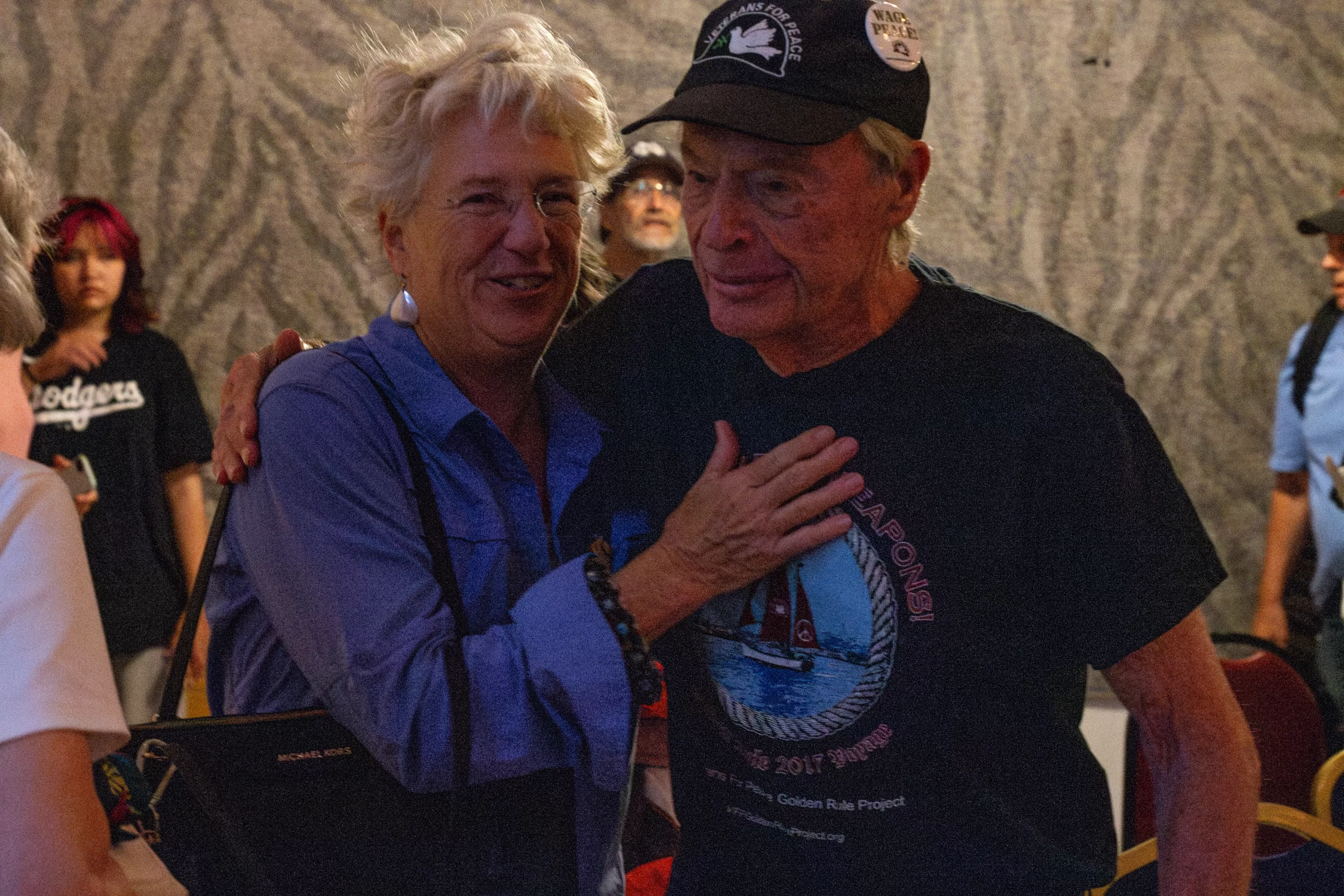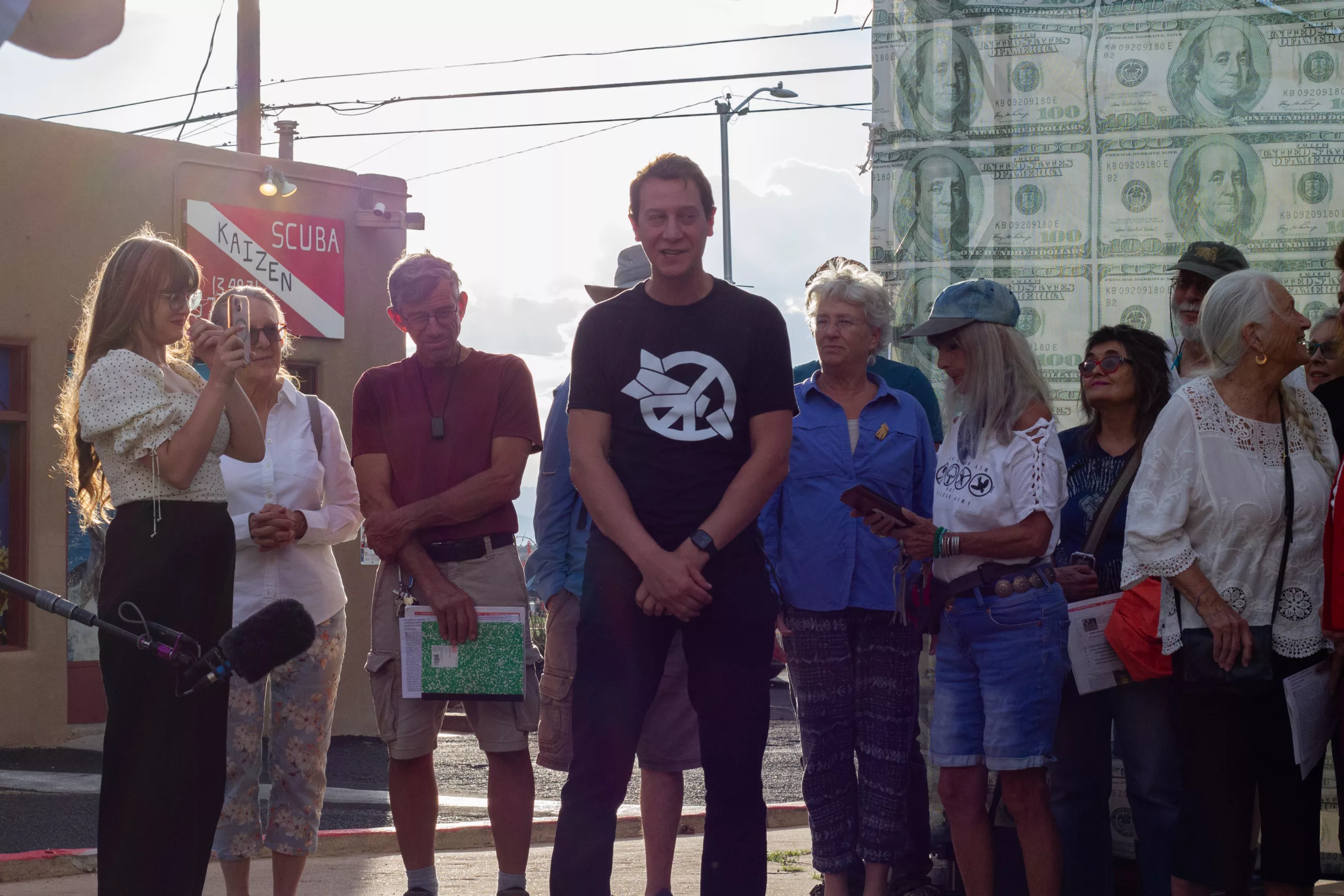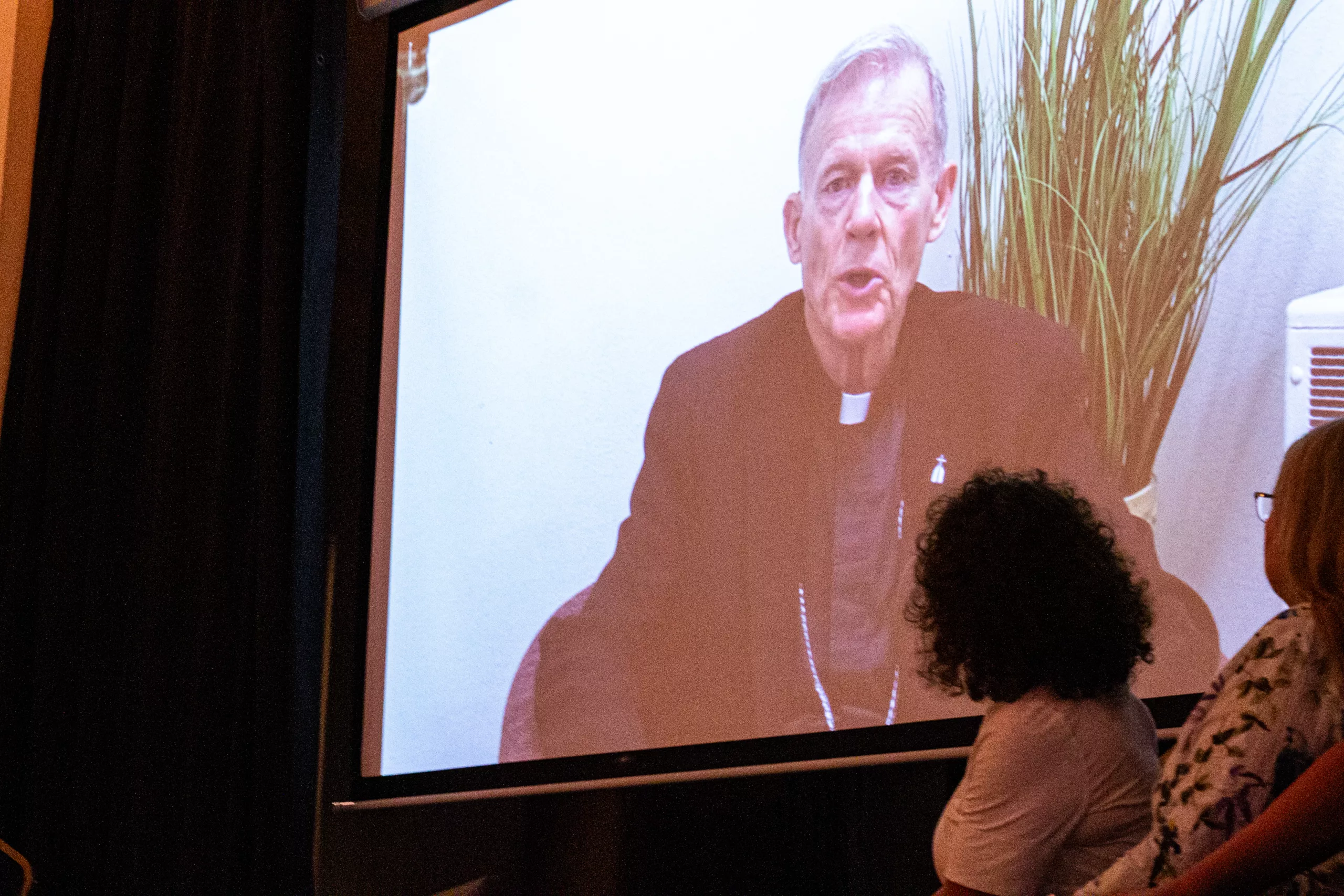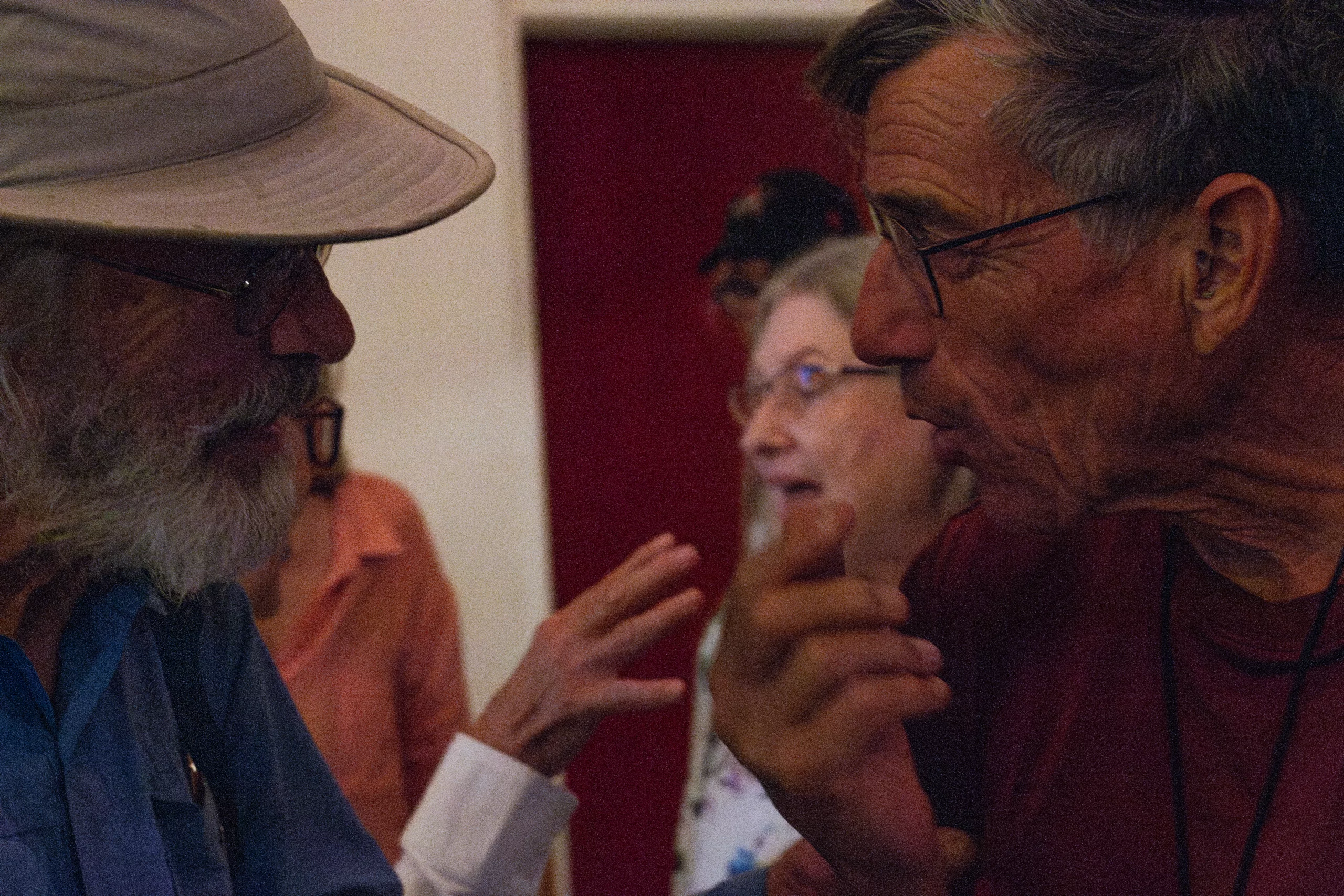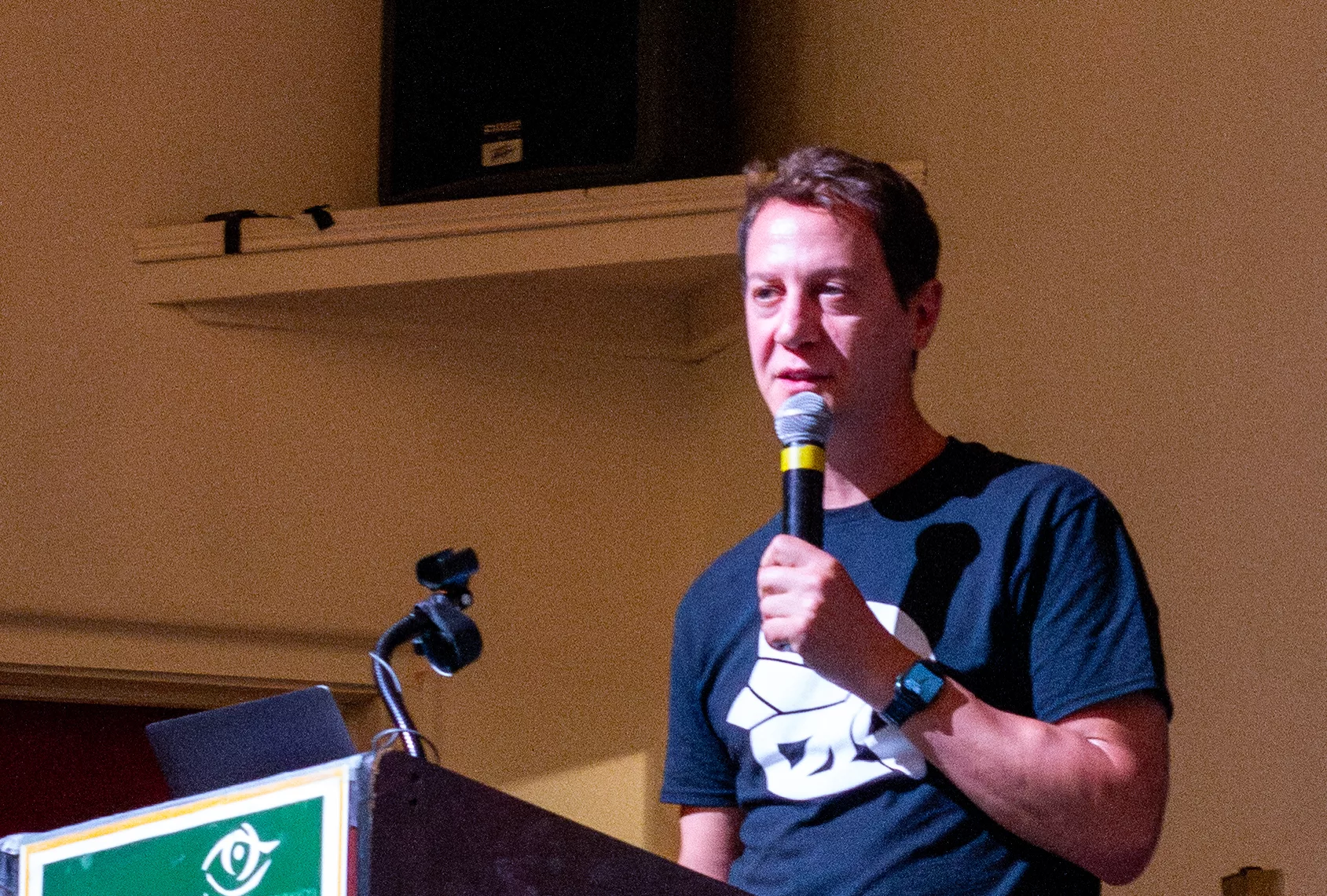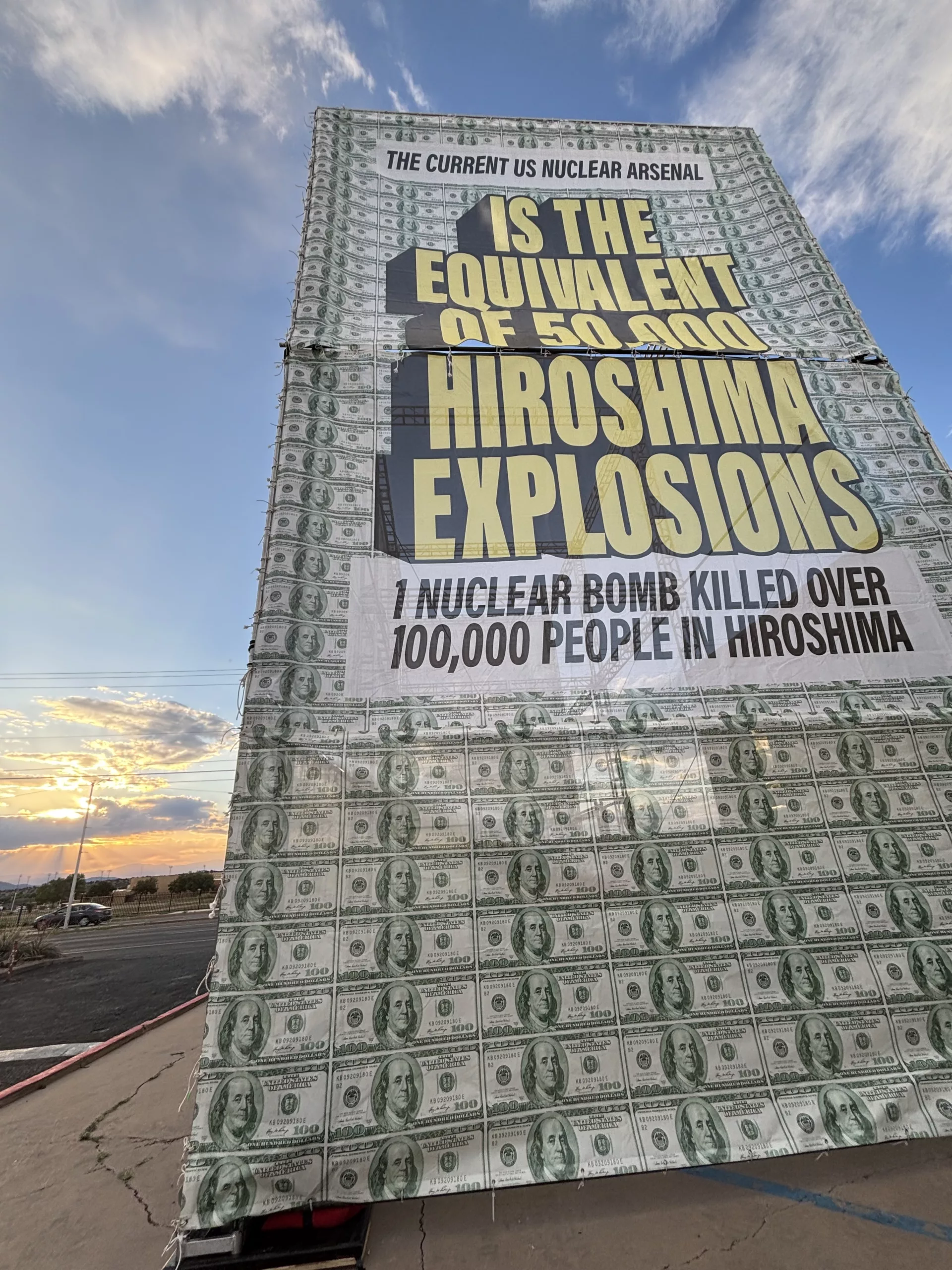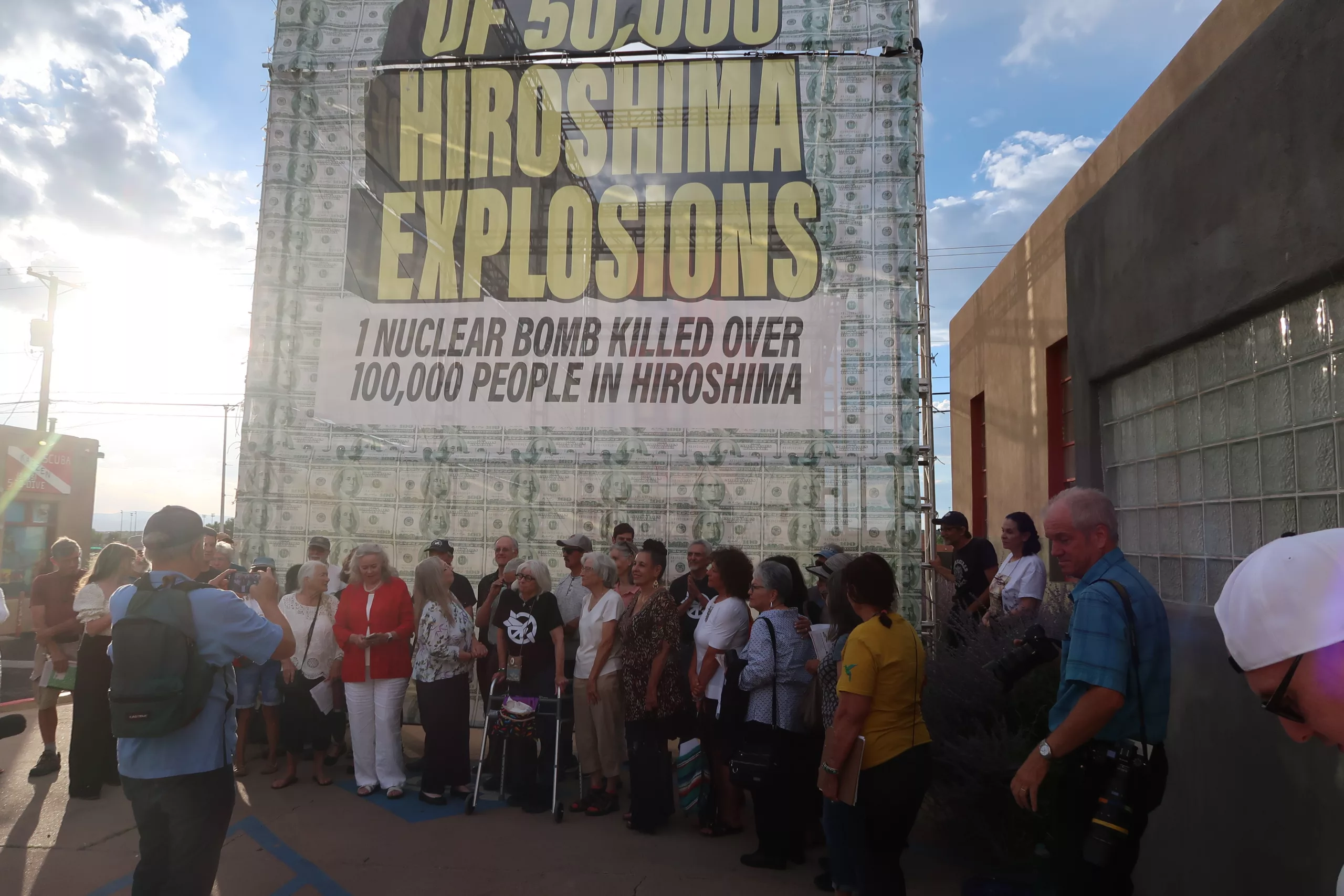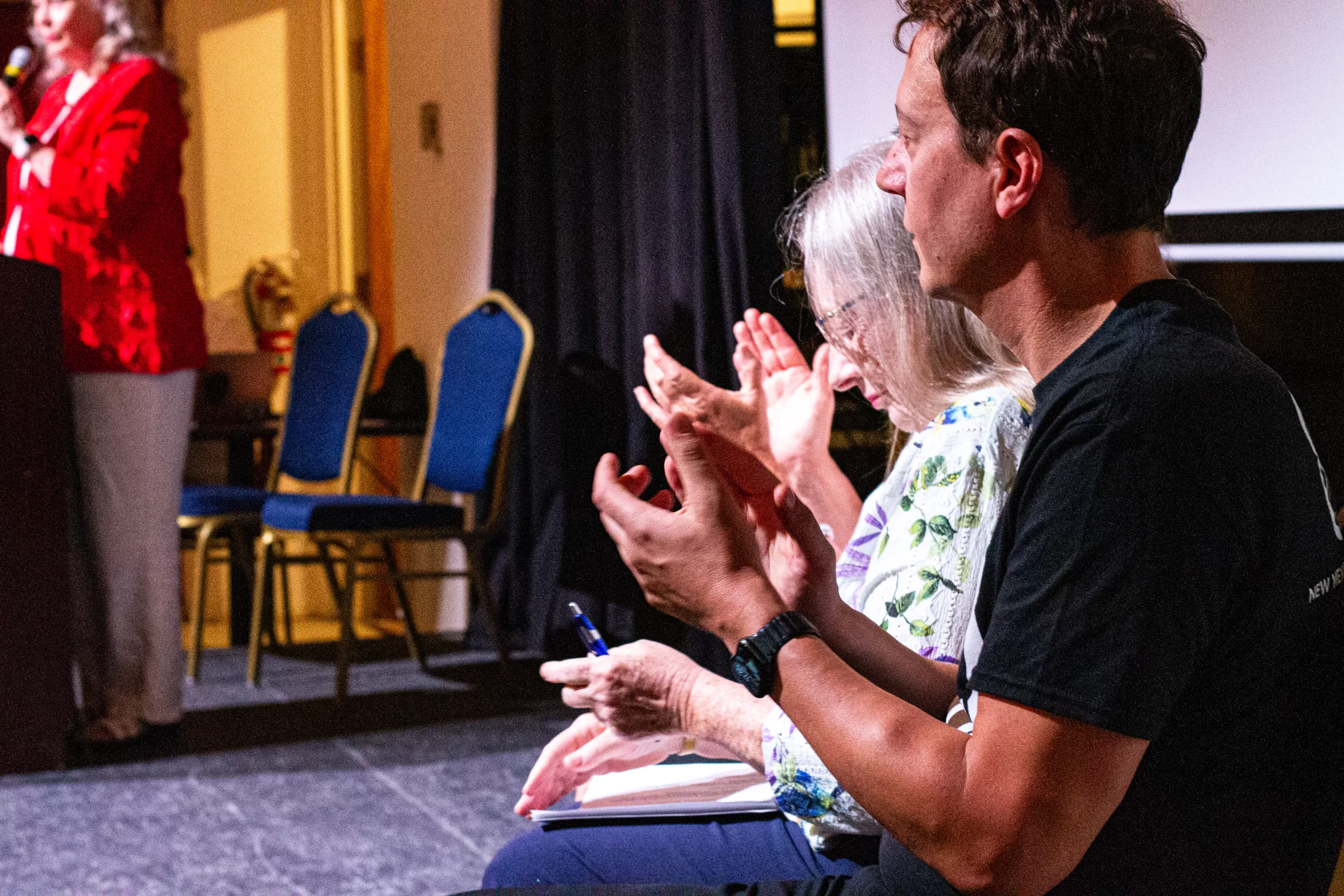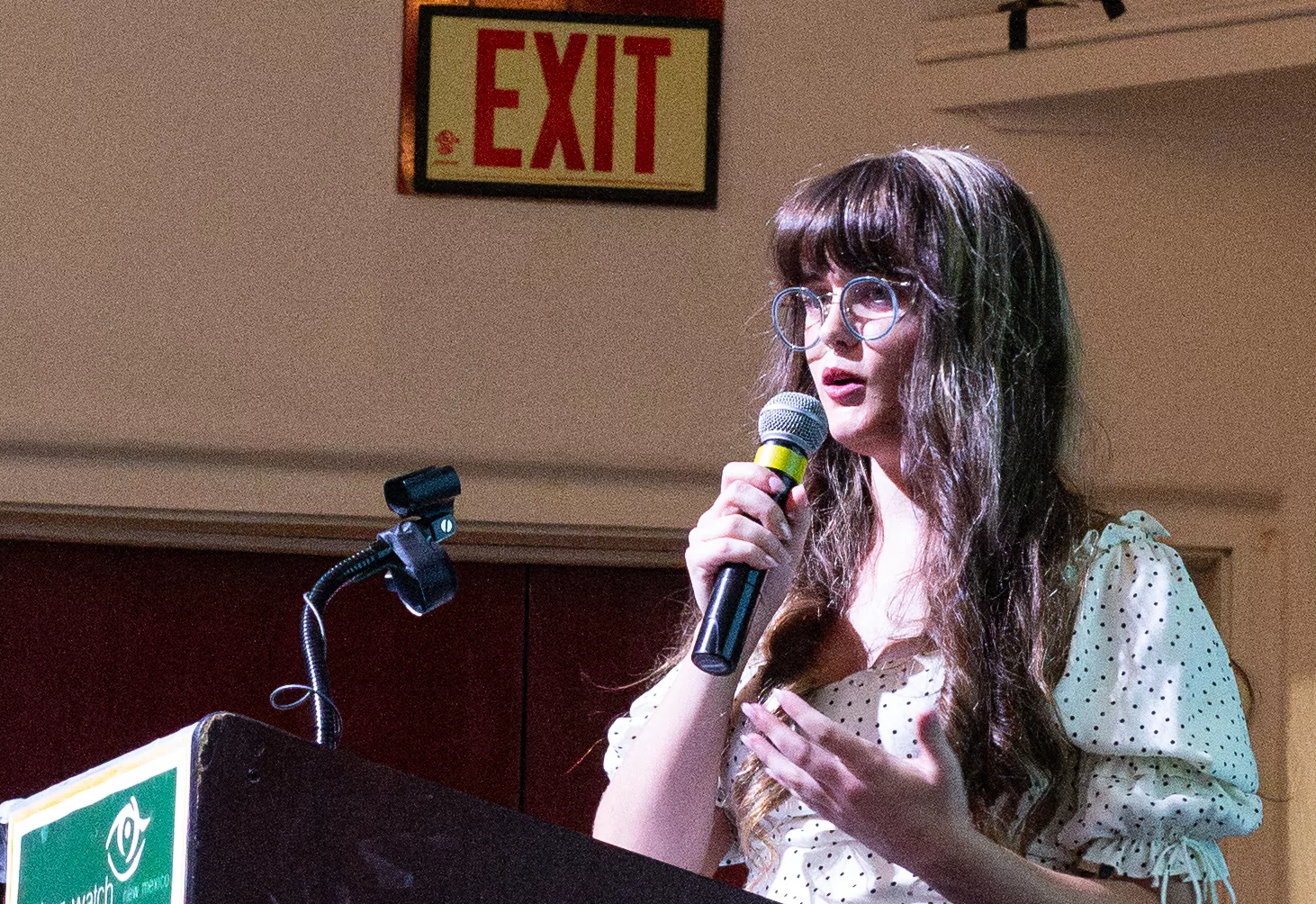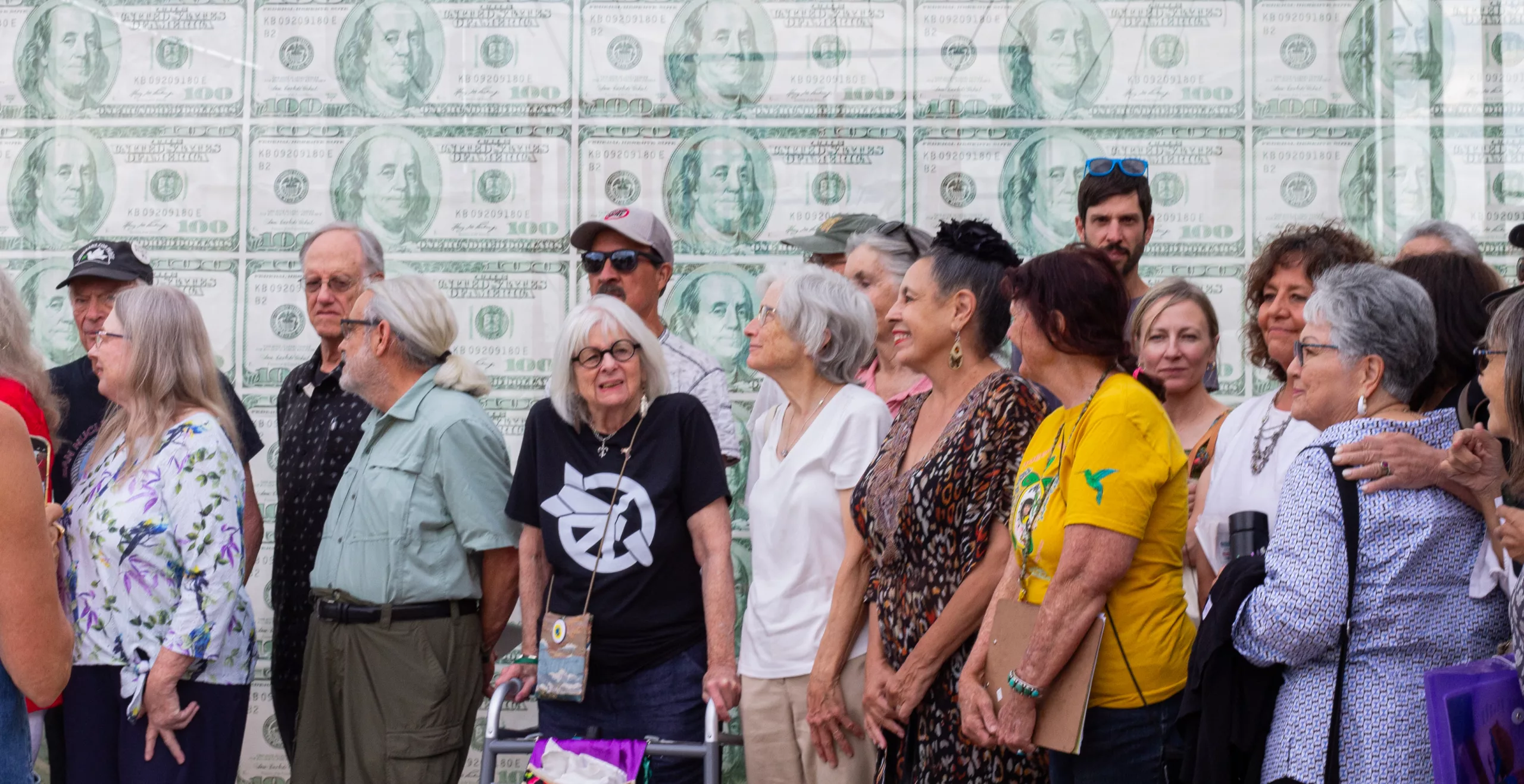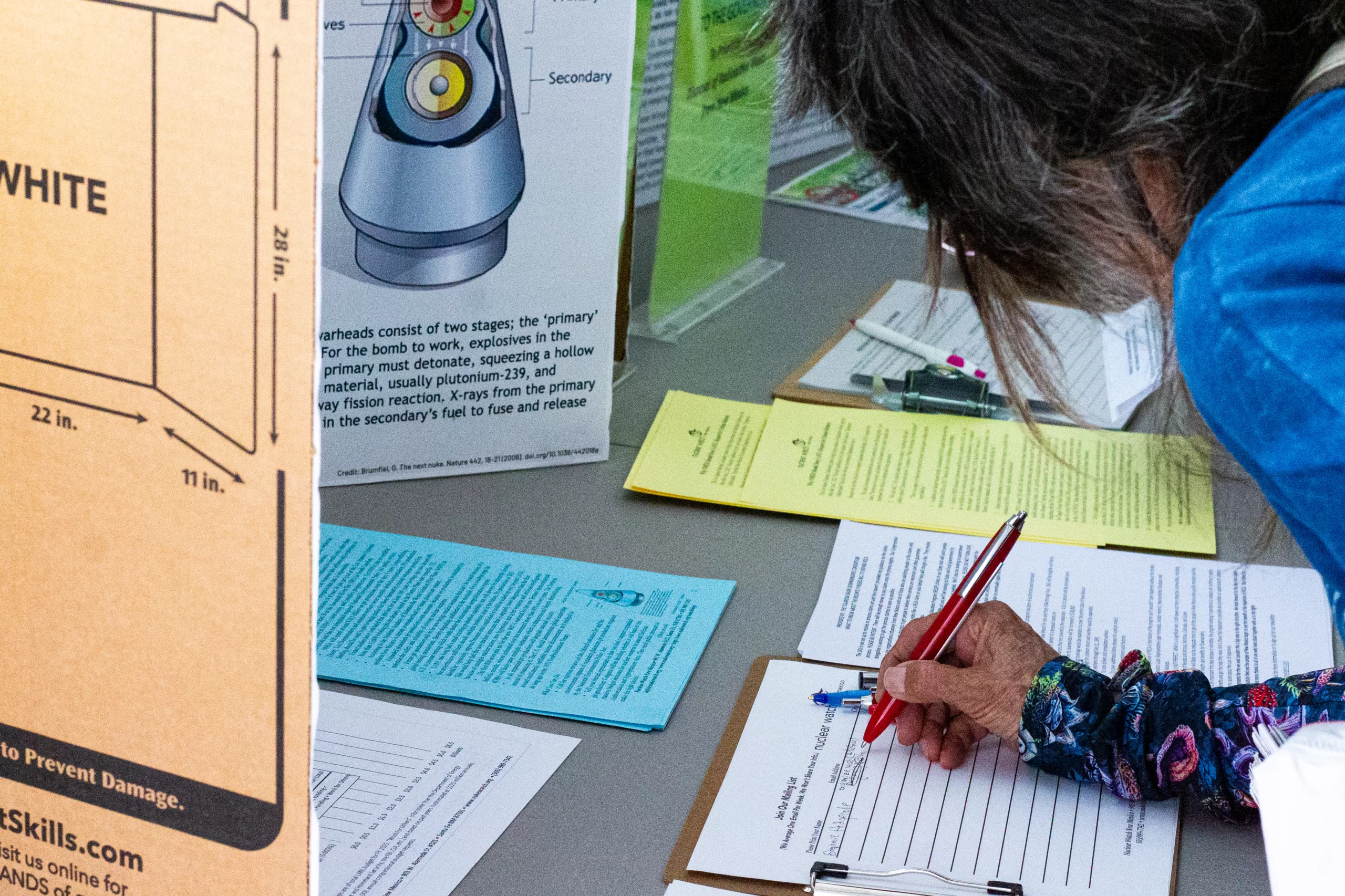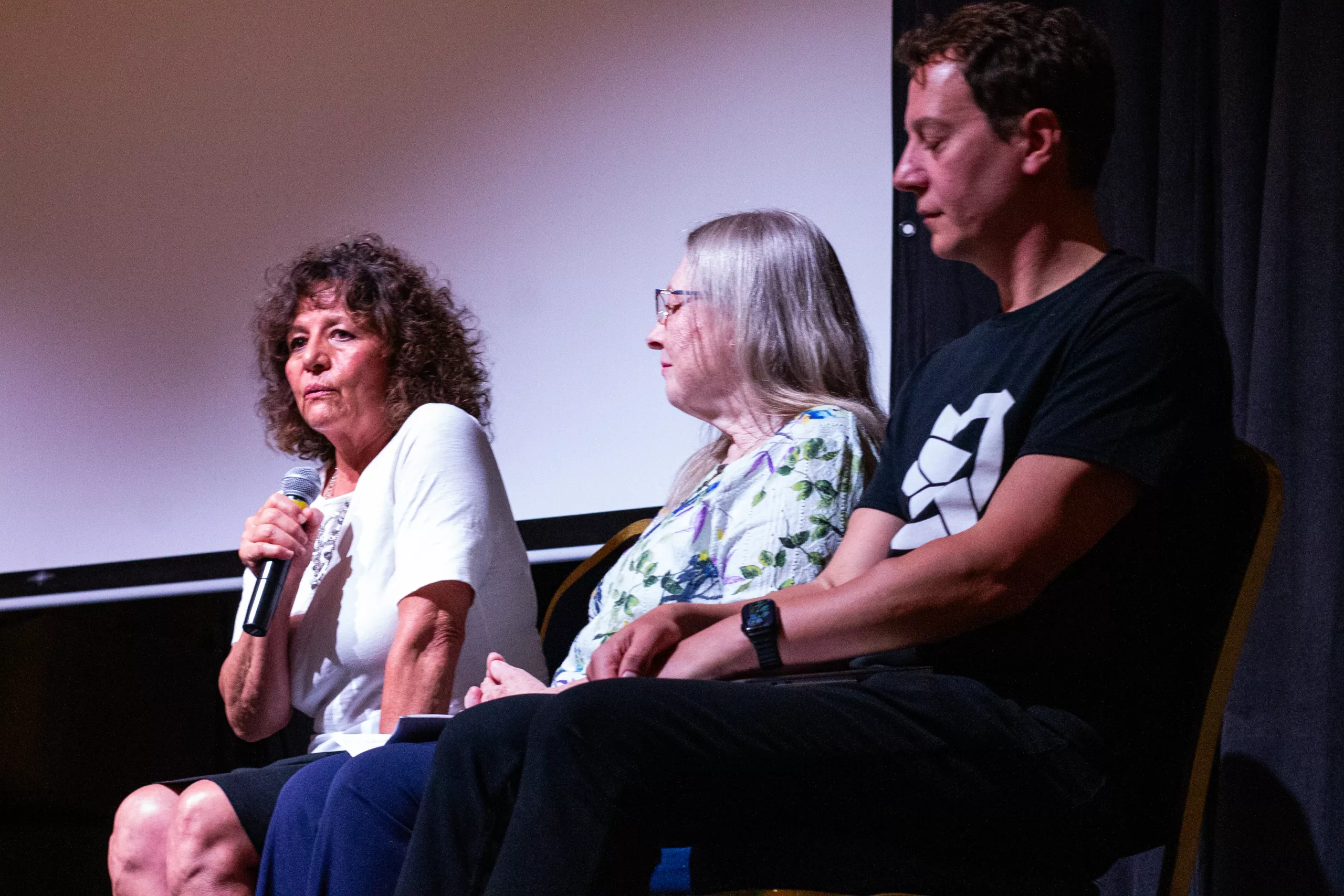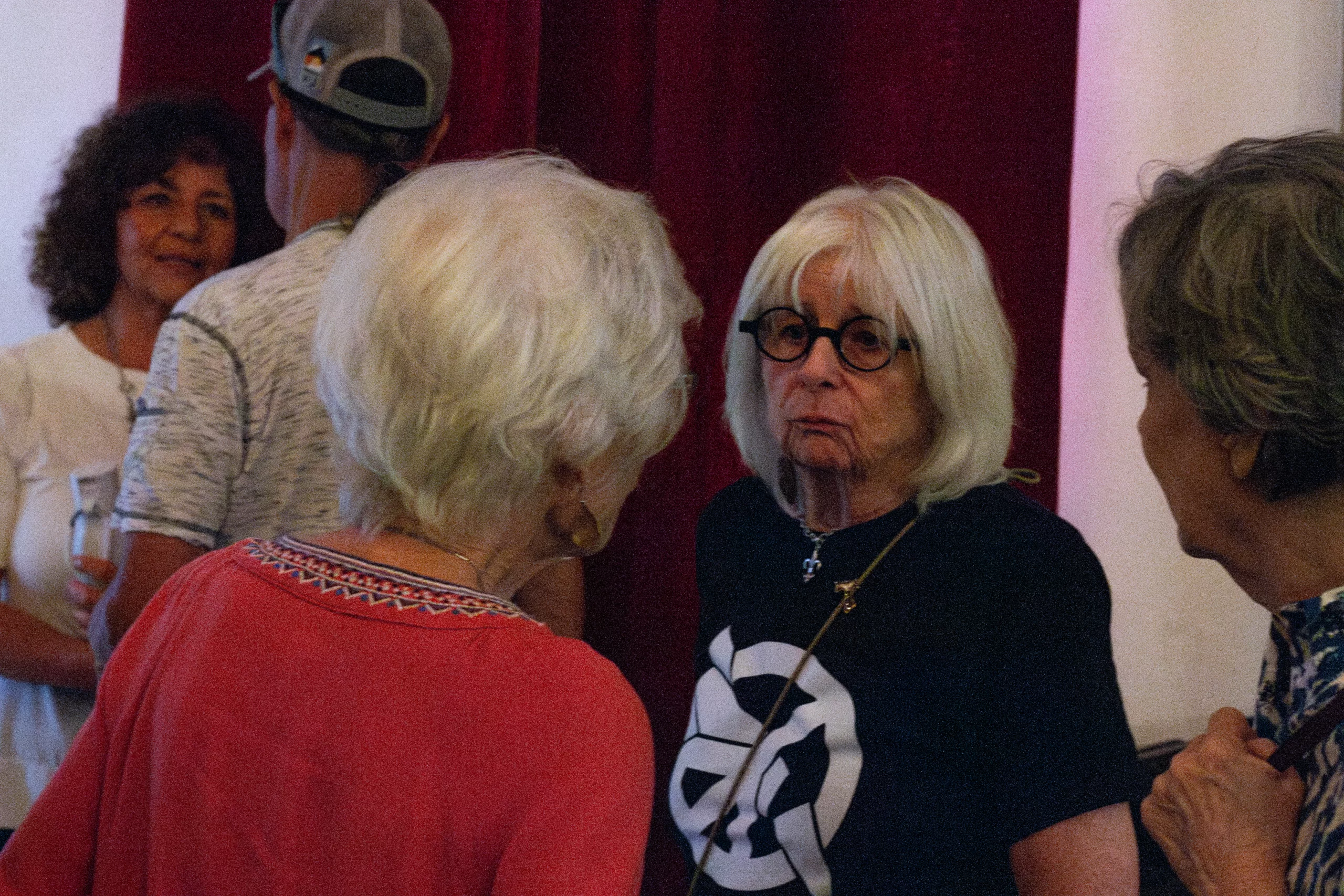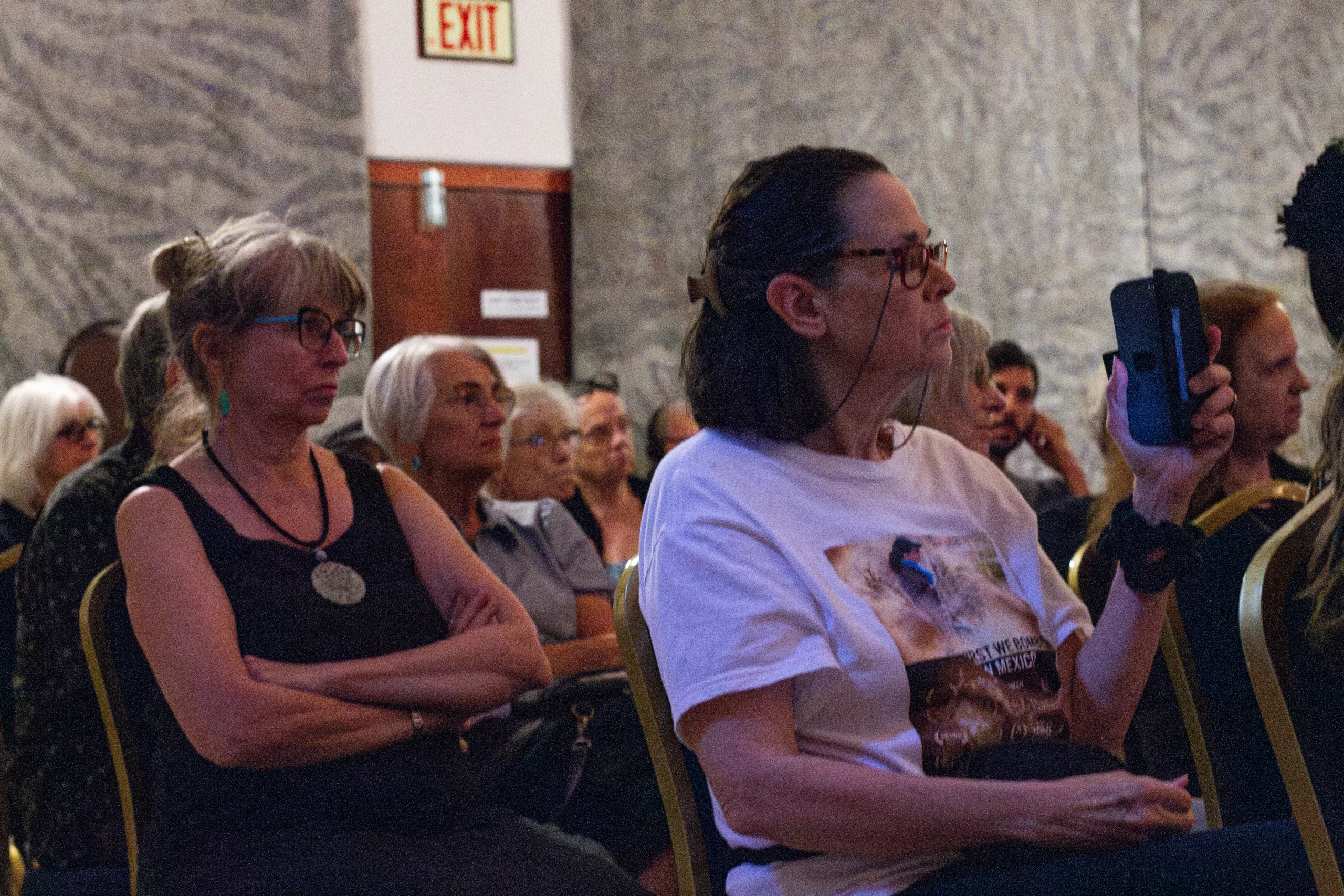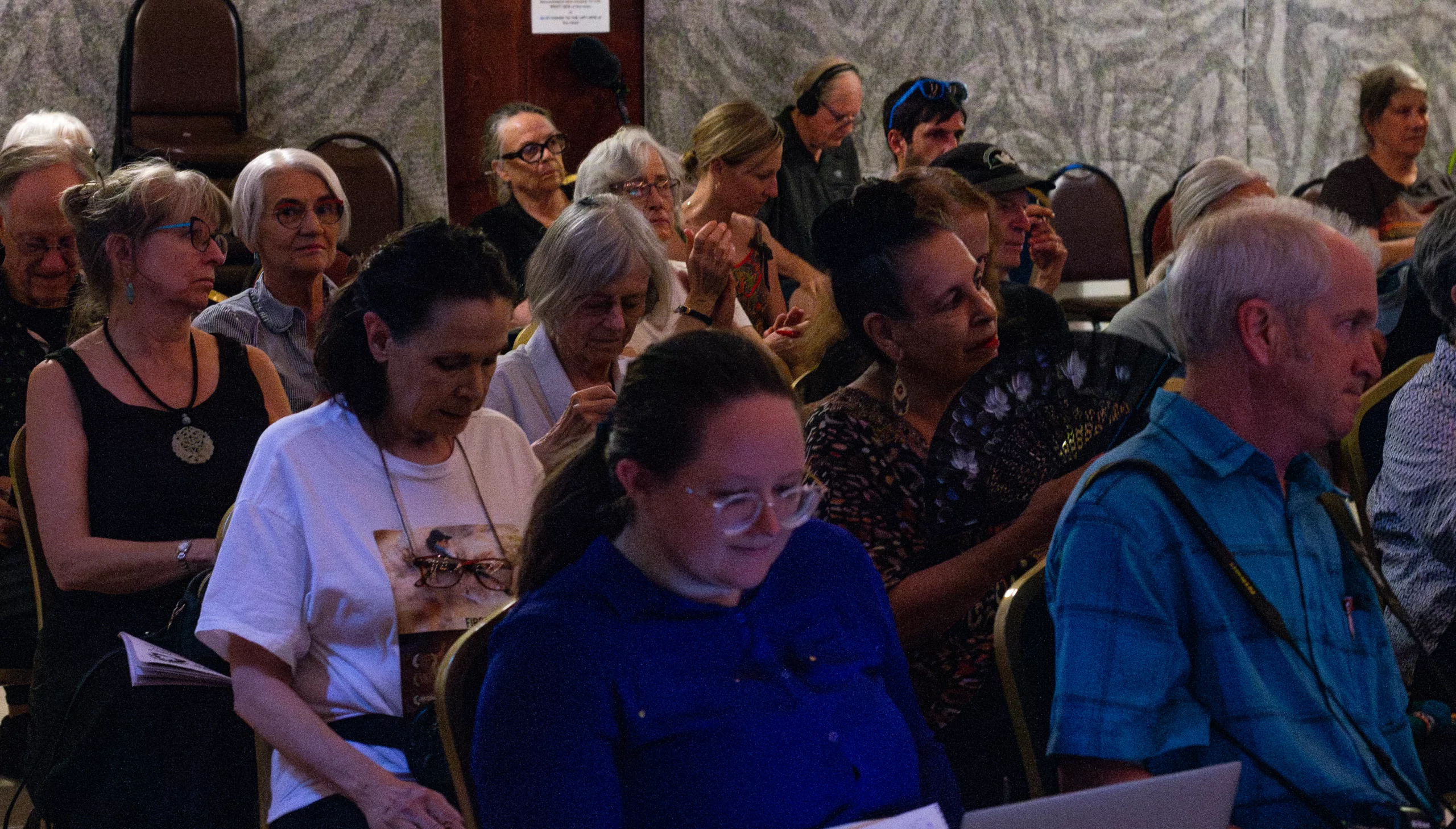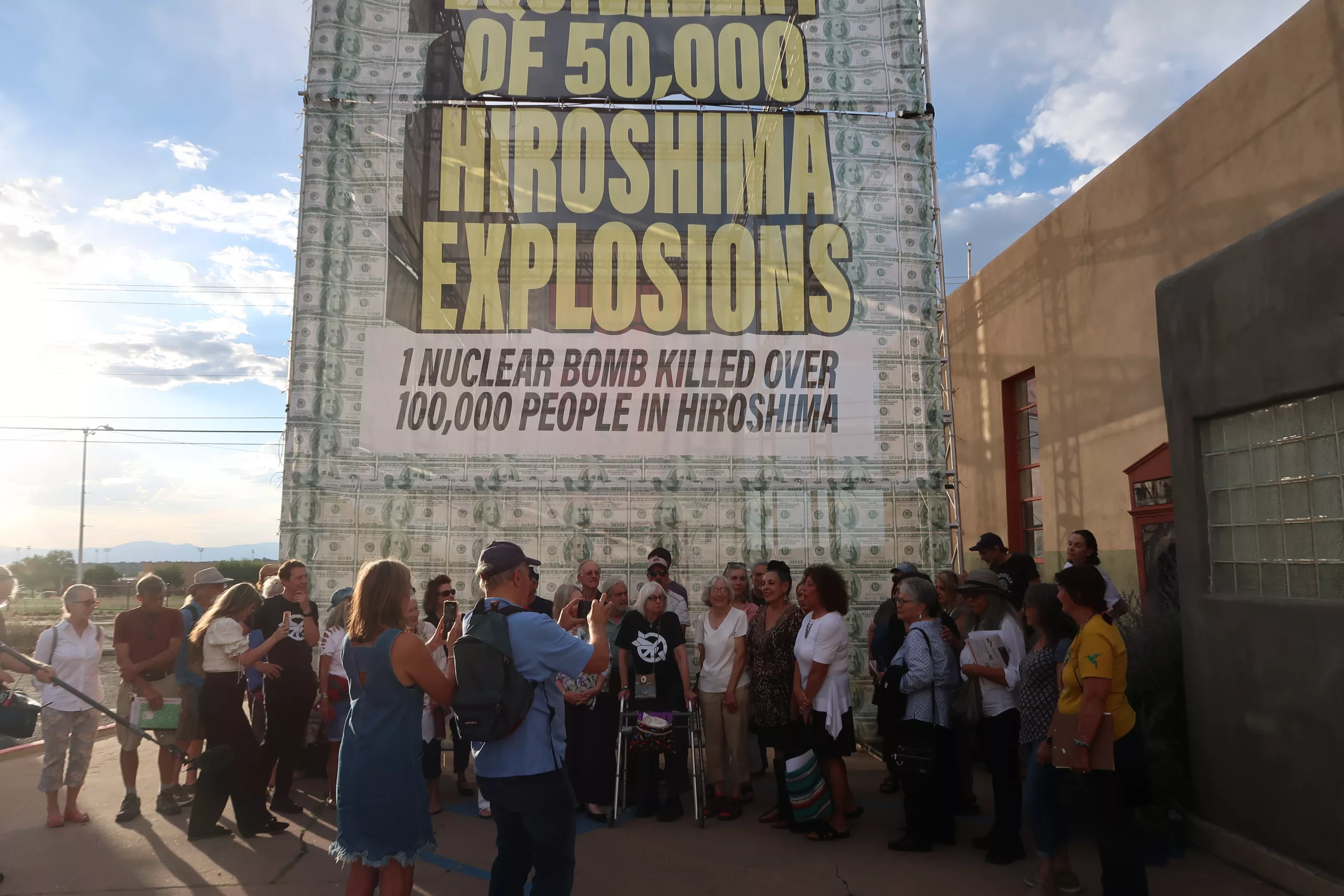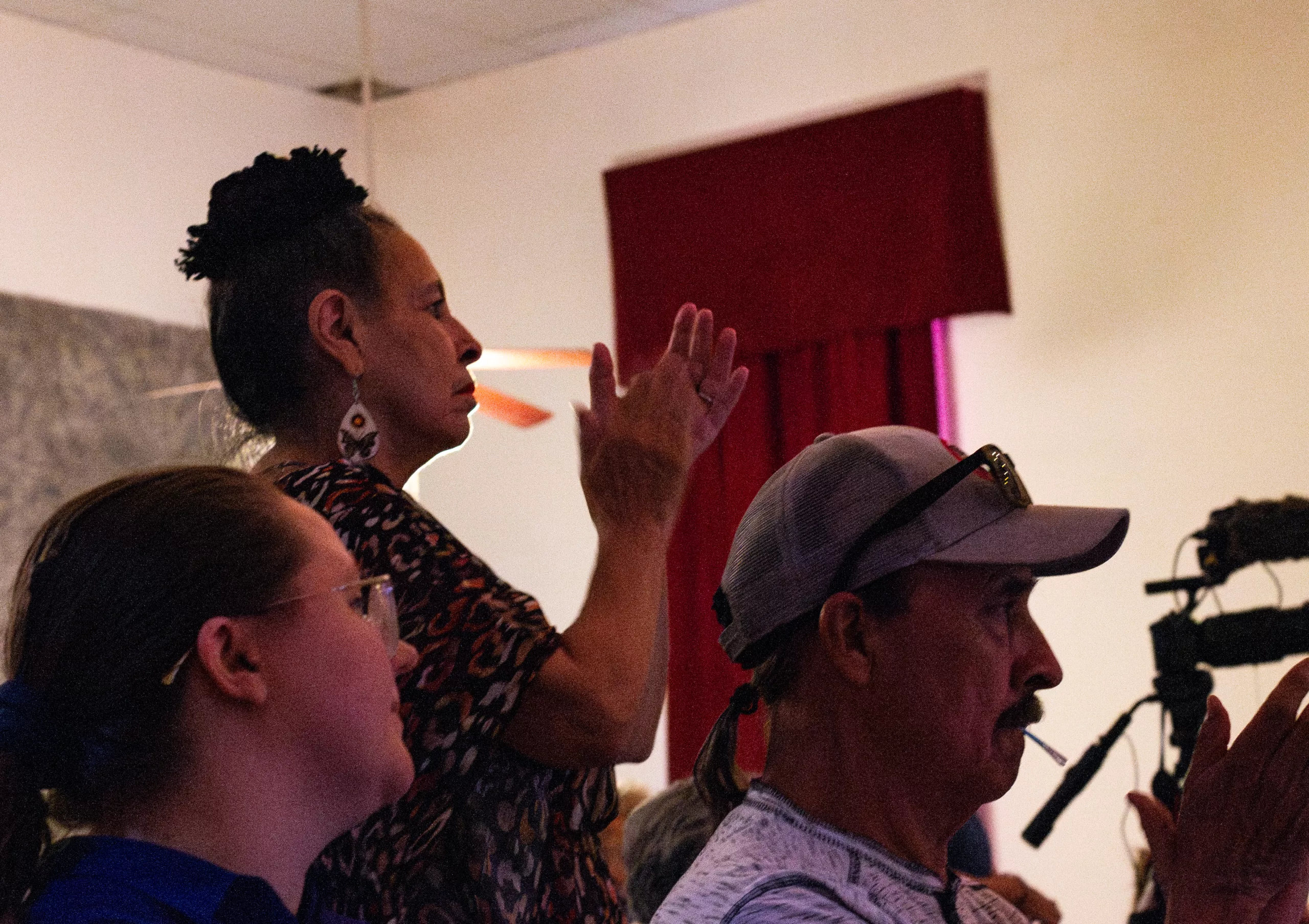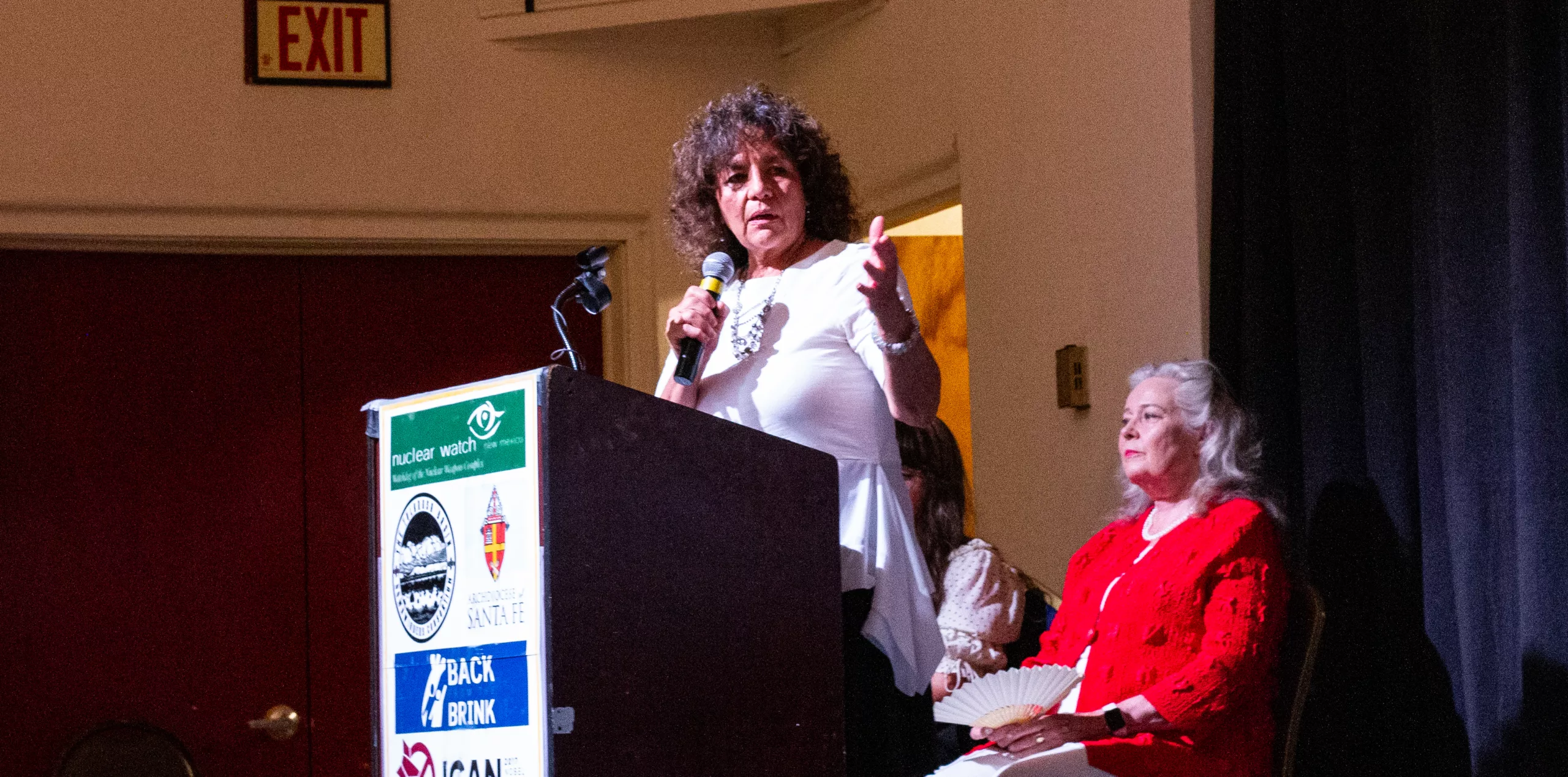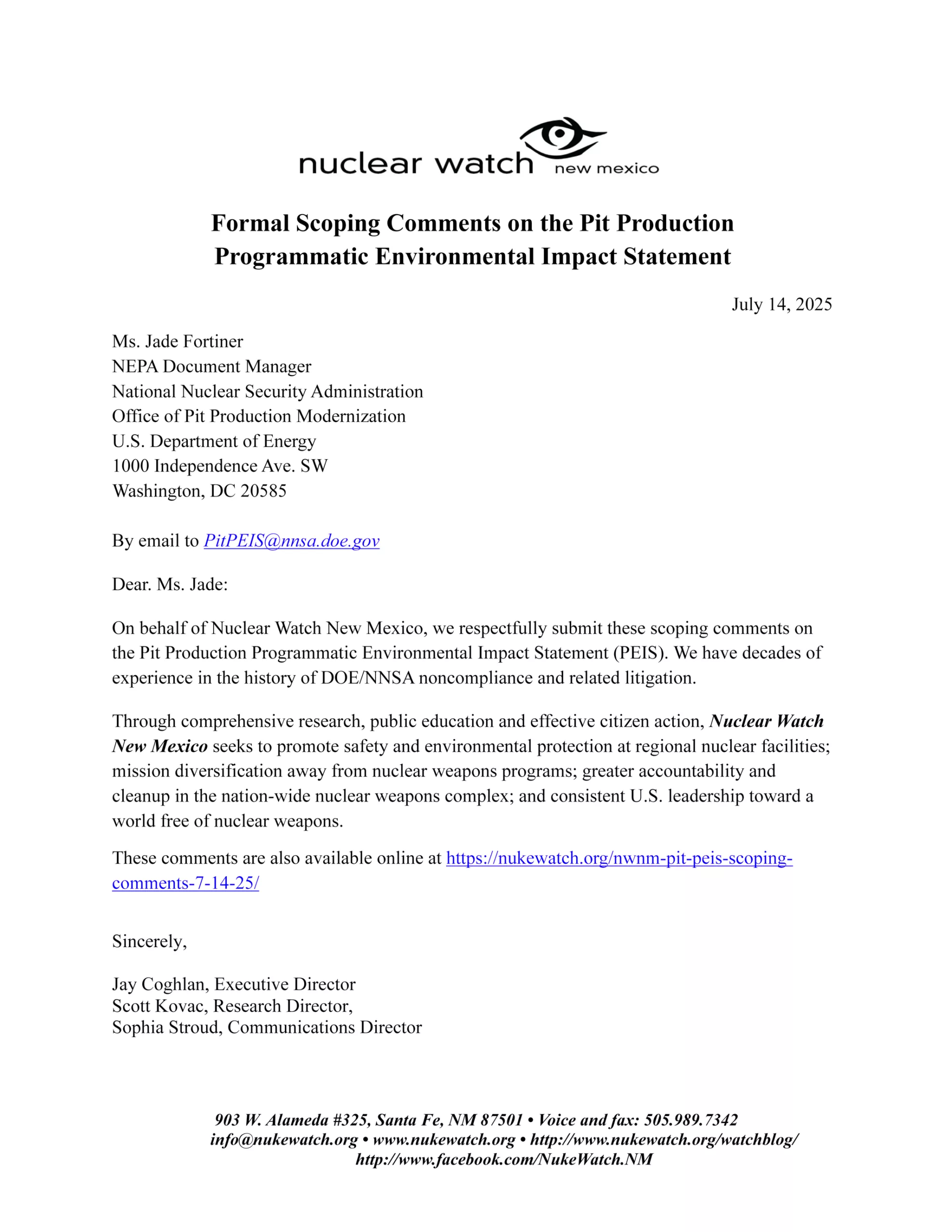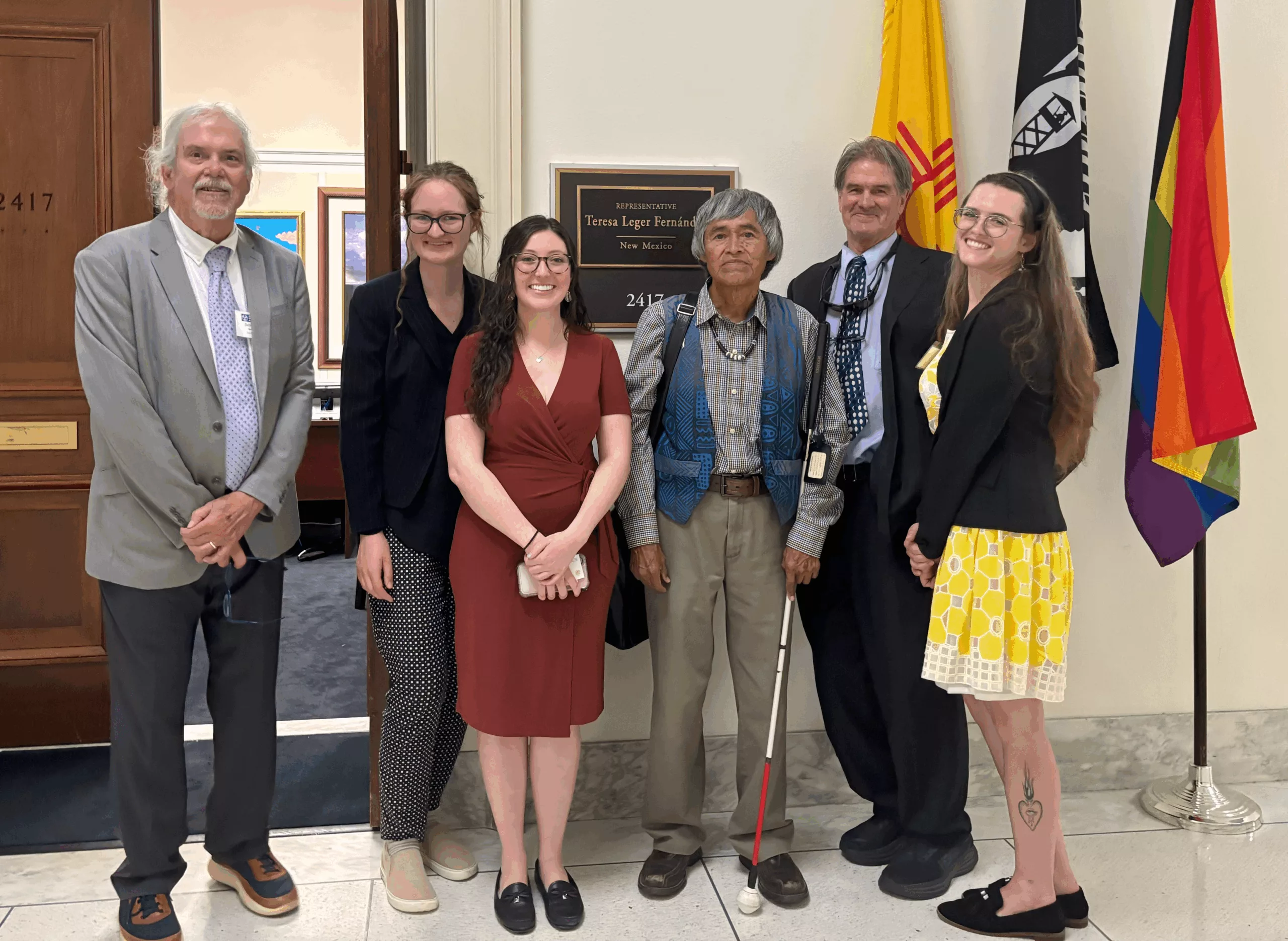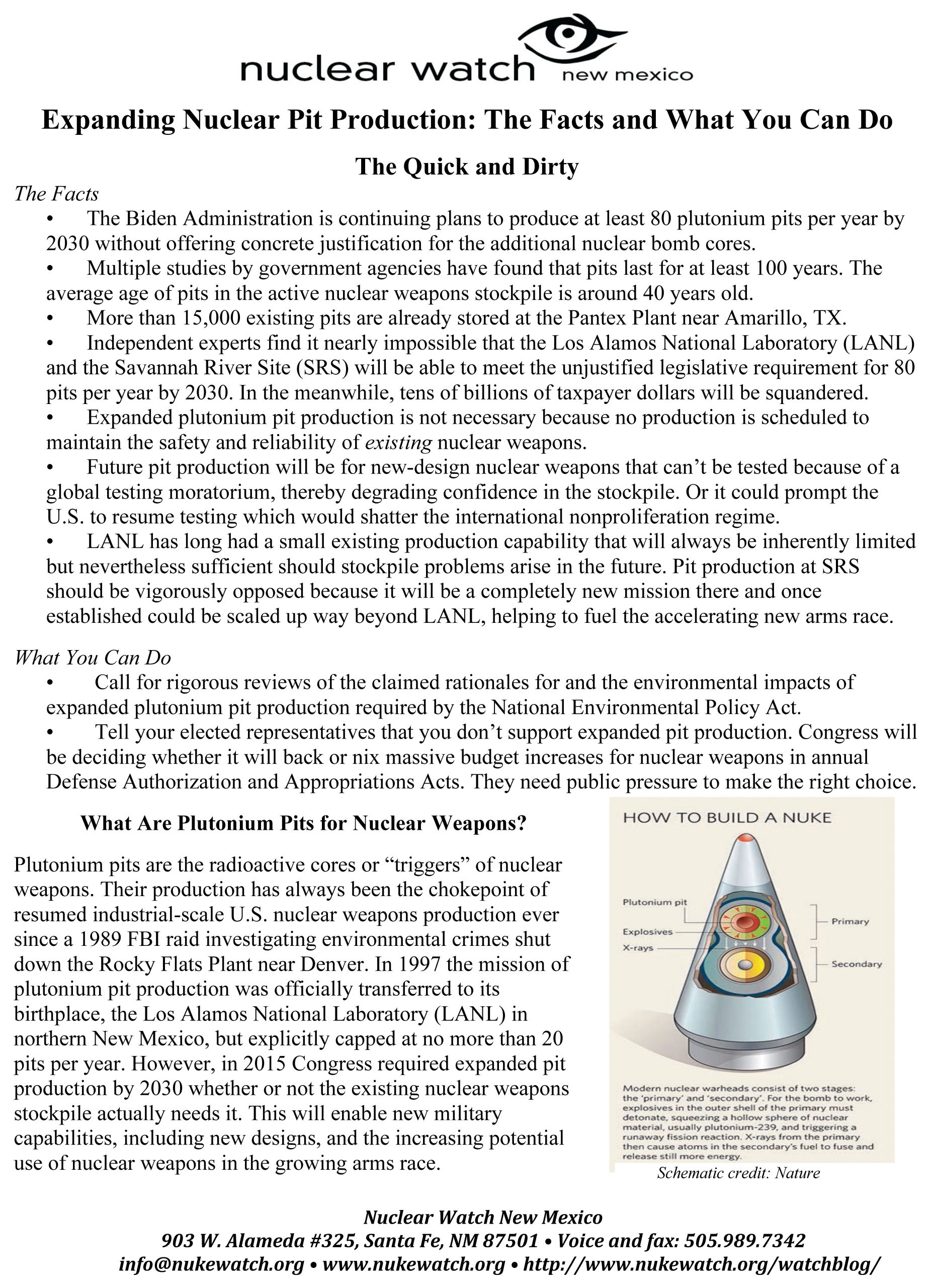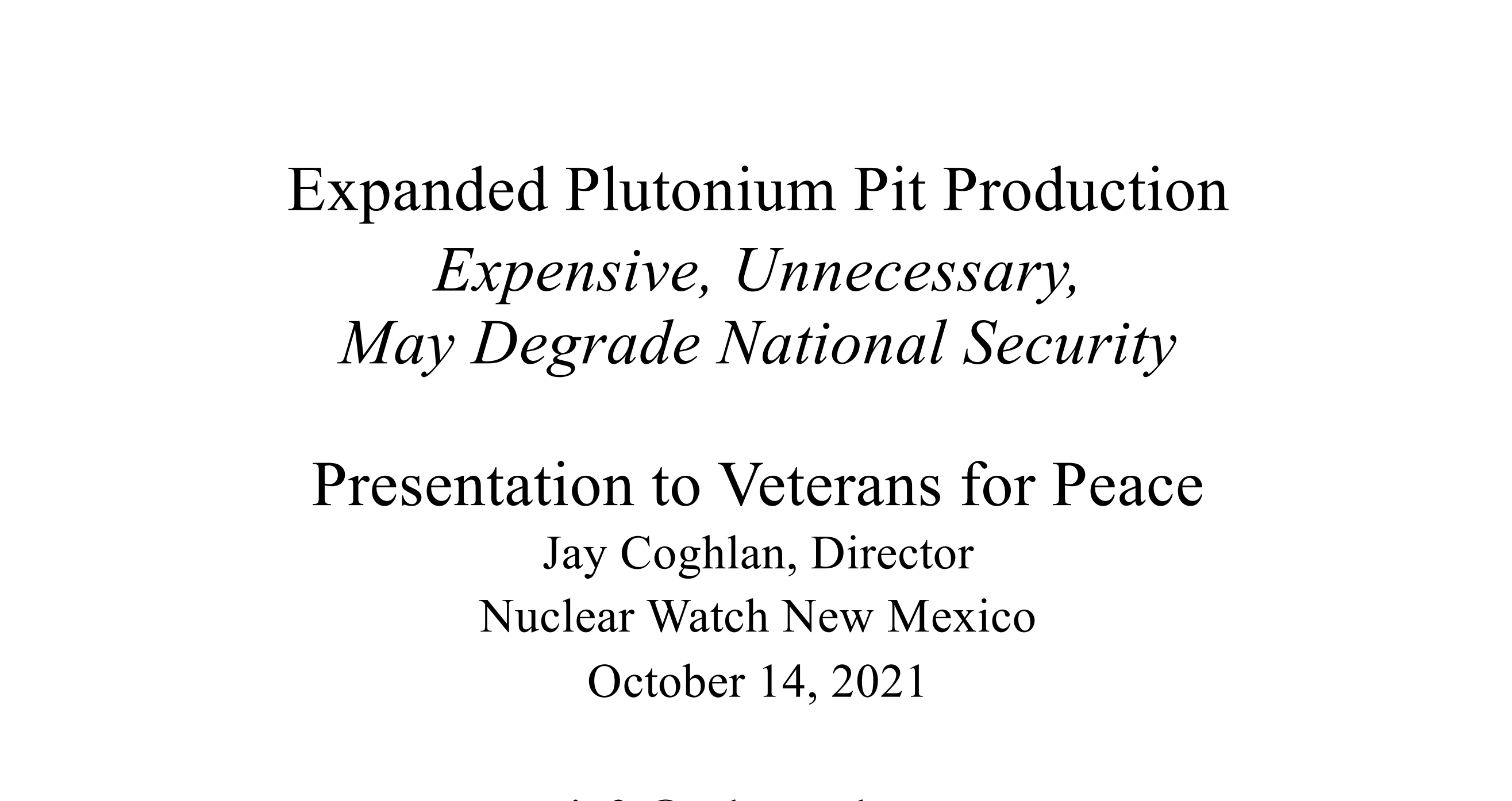Updates
Los Alamos National Lab (LANL) Town Hall December 3rd, 2025 – Thoughts from Nuclear Watch New Mexico:
The LANL Director mentioned Non-proliferation is a big part of their work. However, the Nuclear Nonproliferation program budget is a mere 6.5% of the total Lab budget (Nuclear Weapons is 84%, with a Billion dollar increase for FY26). https://nukewatch.org/wp-content/uploads/2025/09/FY26-Lab-Table-spreadsheets-Chart-1.pdf Nuclear Nonproliferation is a valuable program that LANL does well, and its funding should not be cut to provide more money for nuclear weapons production (literally the opposite of nonproliferation). The Nuclear Nonproliferation budget should be increased, especially if the Lab director agrees on its importance. NukeWatch NM is entirely supportive of LANL’s Sealed Sources program, which serves as the nation’s lead for collecting potentially dangerous radioactive materials that are no longer needed, securing them, and ensuring they don’t fall into the wrong hands, protecting communities and enhancing security.
On the discussion of AI missions at the lab:
The lab is partnering with NVIDIA for their hardware and ChatGPT/Open AI for their models. “The goal is to harness the power of the next evolution of high performance computing and apply it to our national security science and technology. Big development on this front is the “genesis” mission…” and in an answer to a question, want to “use artificial intelligence to [for example] help us develop the molecules that could deliver a therapeutic isotope to a cancer cell with high specificity so that when that undergoes radioactive decay the decay products basically kill the cancer cell but no surrounding tissue”
Again, the lab’s nuclear weapons budget ate up almost all else this year – how does the lab propose to work on this kind of work when its’ science budget is less than 1%? How will this advancement of AI be applied to our national security science and technology in terms of nuclear weapons? NukeWatch has serious concerns and questions regarding the tangible risks associated with integrating commercial AI infrastructure to be with active national security and nuclear defense programs. Beyond this, a $1.25 billion advanced computing campus is planned in Michigan to support far-away Los Alamos Lab in high-performance computing and AI research.
Continue reading
Nuclear Watch New Mexico Attends the Alliance for Nuclear Accountability Fall Meeting Nov. 21-23 in Las Vegas, Protesting Nuclear Testing in Nevada & Much More!
Sophie Stroud, Communications and Associate Director, represented NukeWatch at the Alliance for Nuclear Accountability's (ANA) fall meeting Nov. 21-23 in Las Vegas, hosted locally by Ian Zabarte, Principal Man of the Western Shoshone, Secretary of State of the Western Shoshone National Council, and Secretary of the Native Community Action Council (NCAC). The Nevada Test Site, now called the "Nevada National Security Site" and Yucca Mountain are both nuclear sites on Shoshone Land, and nuclear issues continue to threaten the Western Shoshone People. Yucca Mountain is Western Shoshone property with Constitutional protection, and the Department of Energy cannot prove ownership. ANA is a national network made up of 30 organizations whose members live near US nuclear bomb plants and their waste sites. The meeting was scheduled in coordination with the renowned International Uranium Film Festival — uraniumfilmfestival.org. As an organizer of the ANA Meeting as well as the International Uranium Film Festival, NCAC, composed of Shoshone and Paiute peoples, believe these films are a necessary part of the ongoing awareness, witness and resistance to nuclear war, human health and a livable Mother Earth. As 2025 marks the 80th anniversary of the first atomic bombings at the Trinity Site, Hiroshima, and Nagasaki, the world faces a new nuclear arms race that includes nuclear "modernization" of weapons, as well as the fast-tracking of uranium mining for nuclear-powered artificial intelligence data centers.
Friday morning, Nov. 21, the group traveled to the Mercury Exit gate of the Nevada Test Site with banners opposing nuclear weapons and nuclear testing. On October 29, before a meeting in South Korea with Chinese President Xi, President Donald Trump announced on social media that he “instructed the Department of War to start testing [U.S.] Nuclear Weapons on an equal basis” with Russia and China. The post contains various inaccuracies and ambiguity over whether he wants to resume underground nuclear explosive testing — an act the United States, Russia, and China have not undertaken in over 30 years — or continue testing of delivery systems.
Trump Orders Nuclear Weapons Testing for New Nuclear Arms Race
Department of Energy Seeks to Eliminate Radiation Protections Requiring Controls “As Low As Reasonably Achievable”
An internal Department of Energy (DOE) memorandum eliminates worker and public radiation protection rules known “As Low As Reasonably Achievable” (ALARA). This fundamental departure from decades of accepted health physics practices is being promoted by senior DOE political appointees with little background in health or radiation control. It is marked as “URGENCY: High” under the auspices of the DOE Deputy Secretary, the Under Secretary for Science, and the Administrator of the National Nuclear Security Administration. The memorandum awaits the final signature of DOE Secretary Chris Wright.
The memo’s stated goal is to:
“…remove the ALARA principle from all DOE directives and regulations, including DOE Order 458.1, Radiation Protection of the Public and the Environment, NE [Office of Nuclear Energy] Order 458.1, Radiation Protection of the Public, and, upon completion of the rulemaking process, 10 CFR [Code of Federal Regulations] 835, Occupational Radiation Protection.” [1]
It follows the playbook of the Heritage Foundation’s Project 2025, which called for:
“Set[ting] clear radiation exposure and protection standards by eliminating ALARA (“as low as reasonably achievable”) as a regulatory principle and setting clear standards according to radiological risk and dose rather than arbitrary objectives.” [2]
Los Alamos’ plutonium facility safety systems need improvement, oversight board says
Nuclear Watch New Mexico executive direcor Jay Coghlan sees PF-4 as being a bigger scale — and having bigger risks — than the other aging buildings.
“PF-4 is not unique in being old,” Coghlan said. “However, PF-4 is totally unique in currently being the only facility that can process large amounts of plutonium … particularly including plutonium pit production. I think, in part, that’s why the Safety Board focuses more on PF-4 than, to my knowledge, than any other single individual facility.”
By Alaina Mencinger amencinger@sfnewmexican.com | November 7, 2025 santafenewmexican.com
An independent oversight agency wants to see improved safety systems at the facility at the heart of Los Alamos National Laboratory’s plutonium pit mission: PF-4.
The Defense Nuclear Facilities Safety Board reported what it believes to be gaps in a safety analysis drafted for PF-4 and delays in upgrades to safety systems in a letter last month to Energy Secretary Chris Wright.
“Maintaining momentum for these safety infrastructure projects is more important in light of the issues with the safety analysis,” the board wrote in the letter dated Oct. 10. It was signed by former acting chairman Thomas Summers.
“A House of Dynamite” New Netflix Nuclear Catastrophe Film: Fiction, for Now
The reviews are rolling in for “A House of Dynamite,” which premiered in Europe earlier this month before coming to the U.S. on October 10th, with a full Netflix release scheduled for the 24th. Here’s the trailer, and see the schedule for Santa Fe theater showings here:
This Week! Santa Fe Theater Screenings for the Film “A House of Dynamite”
I attended one of these screenings last night, and I’ll let the professional critic reviews give the gist:
The Kathryn Bigelow thriller looks at what might happen if a ballistic missile were headed to the U.S. The director hopes the movie will start a conversation. New York Times: At Venice, ‘A House of Dynamite’ Is Scarier Than Most Horror Films
“The Netflix thriller captures from multiple perspectives the White House response to an unattributed missile launch headed for a major U.S. city in the harrowing 20 minutes until projected impact…”An unrelenting chokehold thriller so controlled, kinetic and unsettlingly immersive that you stagger out at the end of it wondering if the world will still be intact.” ‘A House of Dynamite’ Review: Idris Elba and Rebecca Ferguson in Kathryn Bigelow’s Precision-Tooled, Viscerally Unsettling Nail-Biter
“Told from the perspective of soldiers at a remote Alaskan missile base, staffers in the White House situation room, military officials at US Central Command (CENTCOM), and the president of the United States, the film weaves an overlapping timeline to show how the United States would respond to a missile attack…The film doesn’t want viewers to ask themselves how to thwart a nuclear attack on the United States. Rather, it wants the viewer to question the value of having nuclear weapons at all. ‘None of this makes sense,’ the President (Idris Elba) bemoans, ‘Making all these bombs and all these plans.'”
“A House of Dynamite is a terrifying examination of how terribly wrong things can go even with highly competent people in charge…But that’s also not necessarily the world we’re living in…The film shows why the worst can happen, even when competent, well-meaning people are trying to do the right thing.
But what if competence and decency are in short supply?” A House of Dynamite: Bigelow’s latest thriller shows why nuclear bombs are only part of the danger
This film left me reeling with tension and anxiety and exactly as the Times article titles it, is scarier than most horror films. Unlike ‘Oppenheimer,’ which largely glorified the invention of the atomic weapon, ‘A House of Dynamite’ makes it impossible to ignore the threat that nuclear weapons pose to our world. Working backwards from perspectives, and focused on how we can actually improve our odds of keeping this story a fictional one, here is what struck me most about this film:
-
-
Only one person decides what happens. But the real threat isn’t one reckless leader — it’s a reckless system. The final segment of the film features the “nuclear football” heavily, a briefcase containing launch procedures and options. In the United States, the president holds the sole and absolute authority to order the use of nuclear weapons. In the film, there are many voices in the President’s ear, but two primary perspectives quickly emerge after the defense fails and the ICBM remains inbound to its U.S. target: “One side advocates a retaliatory strike; the other, nothing. ‘It’s surrender or suicide,’ one adviser tells the President,” – thebulletin.org. The military aide carrying the nuclear football is tasked with providing the President the list of options if retaliation is chosen. An absolute must-read, Daniel Ellsberg’s book “The Doomsday Machine” breaks down many of the themes in the film with pure and terrifyingly honest account of Cold War-era nuclear strategy. In terms of launch authority, he describes how the inherent instability of the delegated command structure of the nuclear apparatus makes accidental or unwanted war an ever-present danger.
-
August 6th U.S. Atomic Bombing of Hiroshima Commemoration in Santa Fe
Eighty Years Later, it is Beyond Time to Get Rid of Nuclear Weapons.
Last week on August 6, 2025, the 80th anniversary of the U.S. atomic bombing of Hiroshima, community members gathered at the Center for Progress and Justice on Cerrillos Road in Santa Fe to honor the solemn occasion and demand an end to the ongoing nuclear weapons harm and destruction that first began here in New Mexico.
The event was organized by Nuclear Watch New Mexico in collaboration with the Up in Arms campaign by Ben Cohen, co-founder of Ben & Jerry's, to reduce military and nuclear weapons spending, the International Campaign to Abolish Nuclear Weapons (winners of the 2017 Nobel Peace Prize), the Santa Fe Archdiocese, the Back from the Brink New Mexico Hub, and the Tularosa Basin Downwinders Consortium. It centered around a massive public art installation from Up in Arms of a towering cubic structure framed by messages on top of images of $100 bills. The structure is sized to literally hold $100 billion of those bills, respresenting what the U.S. spends every year on nuclear weapons (the total cost of nuclear weapons "modernization" is up to $2 trillion). Visible to thousands of drivers each day, the large installation pressures viewers to reckon with the scale of this cost and to imagine what else those resources could make possible. A prominent message on one of the four sides quotes the president in saying, "'We don't need to build brand new ones. We already have so many,' — Donald Trump" and below it, "His budget includes a down payment of $2 trillion of nuclear weapons." Another side reads, "The current U.S. nuclear arsenal is the equivalent of 50,00 Hiroshima explosions. One nuclear bomb killed over 100,000 people in Hiroshima."
The installation will remain on display for the foreseeable future, GO SEE IT NOW! 1420 Cerrillos Road, Santa Fe, NM 87505.
During the event, speakers Archbishop John C. Wester (by video from Japan), Tina Cordova of the Tularosa Basin Downwinders, Sophie Stroud from Nuclear Watch New Mexico, Anne Pierce-Jones from Back from the Brink, Ben Cohen representing Up in Arms, and Seth Shelden from ICAN all gave concrete steps and actions that concerned citizens can take to help promote a safer world. The speakers were presented by former Santa Fe County Commissioner Anna Hansen, who stated, “Disarmament is the only answer. I have spent my life working to end the nuclear cycle, as many have, and most of us in this room have never known a world without nuclear weapons.”
Speakers drew connections between the devastation in Hiroshima and the continued production of plutonium pits at LANL. At Los Alamos National Lab alone, five billion dollars will be poured into nuclear weapons programs in Fiscal Year 2026, starting this October. One billion dollars was added to last year’s budget, which includes a 42% increase for nuclear warheads. At the same time, nonproliferation programs are being cut, the science budget sliced in half, and funds for renewable energy zeroed out and gone completely. The push for "modernization" of the US’s nuclear arsenal is directly linked to plutonium pit production at Los Alamos, specifically expanding plutonium pit production. LANL will receive $1.7 billion in direct costs for pit production in 2026. Add in the indirect costs, and it’s roughly double that. All of this future pit production is exorbitantly expensive, yet the National Nuclear Security Administration still has no credible cost estimate for these plans.
WHAT YOU NEED TO KNOW: New plutonium pits are not needed to maintain the existing stockpile - it is all for future, new designs. And these new weapons cannot be tested because of the testing moratorium - or conversely could pressure the US to resume testing. In 2006, independent experts concluded that existing plutonium pits last at least a century. Their average age now is about 43 years. A new pit aging study is expected this year. Expansion plans should stop until then.
The U.S.’s $2 trillion “modernization” program is a plan to keep nuclear weapons forever. It is claimed to be essential for “deterrence.” But deterrence relies upon the flawed assumption that all actors will behave rationally, and that accidents or miscalculations will never occur. History says otherwise. Moreover, the U.S. and Russia have always rejected minimal deterrence in favor of nuclear warfighting capabilities that could end civilization overnight. That is why we have 1,000s of nuclear weapons and are funneling billions of dollars into mass death machines, even though everybody knows that a nuclear war must never be fought and can never be won.
See more on the myth of deterrance here:
Deterrence is the Threat: NukeWatch Presentation for Western New Mexico University – April 1, 2025
Media coverage of the event includes the Santa Fe New Mexican articles below:
New Mexico reckons with its role in Japan’s atomic devastation on 80th anniversary of Hiroshima
‘End the nuclear cycle’: Antinuclear New Mexicans speak out 80 years after Hiroshima bombing
View the full event recording - Click HERE or below:
NukeWatch in DC Lobbying for Nuclear Disarmament and Non-Proliferation
Your Nuclear Watch New Mexico team has just returned from a weeklong trip to Washington D.C. (we went so you don’t have to!). The Alliance for Nuclear Accountability (ANA) hosts an annual “DC Days” conference and following Spring Meeting, and we proudly joined as part of a record number of groups this year. Over 60 individuals from 30+ organizations journeyed to DC to lobby congress on nuclear weapons, energy, and waste policy on behalf of the frontline nuclear communities we represent. Members were present from groups representing the entire U.S. nuclear complex, including sites in Georgia, New Mexico, Tennessee, California, Missouri, Colorado, Idaho, Nevada and beyond. NukeWatch NM brought all three staff members—Jay Coghlan, Scott Kovac, and Sophia Stroud (whose participation was made possible by a youth scholarship from ANA)—to participate in DC Days and the subsequent two-day spring meeting. The ANA DC Days schedule included over 70 meetings with senators, representatives, and other relevant agencies, such as the Department of Energy, the Government Accountability Office, and the Defense Nuclear Facilities Safety Board. Our NukeWatch team attended nearly 30 of these meetings. The Alliance for Nuclear Accountability put together a new report to present our “asks” to congress as a coalition, including analysis and recommendations for nuclear weapons, nuclear waste, and nuclear energy policy and funding. Please click HERE for the full report, and HERE for a short summary.
I was glad to see increased representation from Nevada this year, and especially Indigenous representation. In light of the current administration’s attacks on Environmental Justice, it is more important than ever that ANA as a whole, as well as individual member groups, continue to prioritize uplifting Native American voices, not only because of their deep cultural, spiritual, and social connections to the land, including sacred sites and traditional knowledge essential to religious freedom and access, but also because of the violent legacy and ongoing reality of nuclear colonialism, in which Indigenous lands and peoples have been deliberately and disproportionately targeted in the nuclear industry with uranium mining, nuclear weapons testing and production, and the disposal of radioactive waste. To learn more about Nuclear Colonialism, see: www.networkadvocates.org/downwinders and read Nuclear Nuevo México: Colonialism and the Effects of the Nuclear Industrial Complex on Nuevomexicanos by Myrriah Gómez.
The Workers, the Waste, and the Warnings from Bomb Country
“From South Carolina to California, locals in nuclear weapons towns raise health, safety, and environmental concerns over renewed plutonium pit manufacturing.”
By: Taylor Barnes | June 12, 2025 inkstickmedia.com
The United States’ plans to restock its entire nuclear weapons arsenal, known in military parlance as nuclear “modernization,” hit a bump in the road in January. A scrappy coalition of grassroots watchdog groups and impacted communities from places like the Gullah/Geechee sea islands off the Georgia and South Carolina coasts and San Francisco Bay Area neighborhoods near a weapons laboratory sued the government agency that oversees the security of the US nuclear weapons complex.
The plaintiffs argued that the government was moving ahead with plans to produce new plutonium pits for warheads at plants in rural South Carolina and the Los Alamos laboratory in New Mexico without properly evaluating alternatives under the National Environmental Policy Act. A federal judge agreed, and the National Nuclear Security Administration (NNSA) settled with the grassroots groups, agreeing to perform a multi-year environmental analysis.
The extensive environmental impact study is a rare speed bump that everyday Americans have been able to place in the way of the 21st century’s new nuclear arms race — and one that forces the government to hear from locals in the specific communities across the country that produce parts for the weapons.
“A nuclear arms race can feel abstract and distant, but it very much isn’t,” Ravi Garla, a consultant for the Nuclear Threat Initiative, told Inkstick. Garla recently worked on a campaign that led to a unanimous vote in the Nevada state legislature to oppose any resumption of explosive nuclear tests at a desert site outside Las Vegas where the government carried out more than 900 tests during and after the Cold War.
Top photo: A billboard by an advocacy group opposed to nuclear weapons testing in Nevada (Courtesy of Nevadans Against Nuclear Weapons Testing)
Plutonium Pit PEIS Scoping Hearing Presentation: Slides and Recording
Get Prepared: A coalition of advocacy groups, including Union of Concerned Scientists, Tri-Valley CAREs, and NukeWatch New Mexico recently held a training to help participants prepare effective comments.
Watch the recording here
Password: gP=&0LYZ
NukeWatch Recent Related Work
Historic Settlement Reached in NEPA Lawsuit Over Plutonium “Pit” Bomb Core Production
FOR IMMEDIATE RELEASE, January 17, 2025
Media Contacts:
Ben Cunningham, Esquire, SCELP, 843-527-0078, ben@scelp.org
Tom Clements, Savannah River Site Watch, 803-834-3084, tomclements329@cs.com
Jay Coghlan, Nuclear Watch New Mexico, 505-989-7342, jay@nukewatch.org
Scott Yundt, Tri-Valley CAREs, 925-443-7148, scott@trivalleycares.org
Queen Quet, Gullah/Geechee Sea Island Coalition, 843-838-1171, GullGeeCo@aol.com
AIKEN, S.C. — Nonprofit public interest groups have reached an historic settlement agreement with the Department of Energy’s semi-autonomous nuclear weapons agency, the National Nuclear Security Administration (NNSA). This is the successful result of a lawsuit against NNSA over its failure to complete a programmatic environmental impact statement on the expanded production of plutonium “pit” bomb cores, as required by the National Environmental Policy Act (NEPA). This agreement and a joint motion to dismiss have been submitted to Judge Mary Lewis Geiger of the Federal District of South Carolina. Should the Court enter the dismissal and retain jurisdiction to enforce the settlement, the agreement will go into effect.
This lawsuit was first filed in June 2021 by co-plaintiffs Savannah River Site Watch of Columbia, SC; Nuclear Watch New Mexico of Santa Fe, NM; Tri-Valley Communities Against a Radioactive Environment (CAREs), based in Livermore, CA; and the Gullah/Geechee Sea Island Coalition of coastal Georgia. NNSA promptly moved to have the case dismissed which in February 2023 Judge Lewis rejected, calling her decision “not a close call.”
Court Rules U.S. Nuclear Weapons Production Plan Violates Federal Law
FOR IMMEDIATE RELEASE, October 3, 2024
Media Contacts:
Ben Cunningham, Esquire, SCELP, 843-527-0078, ben@scelp.org
Tom Clements, Savannah River Site Watch, 803-834-3084, tomclements329@cs.com
Jay Coghlan, Nuclear Watch New Mexico, 505-989-7342, jay@nukewatch.org
Scott Yundt, Tri-Valley CAREs, 925-443-7148, scott@trivalleycares.org
Queen Quet, Gullah/Geechee Sea Island Coalition, 843-838-1171, GullGeeCo@aol.com
AIKEN, S.C. — On September 30, United States District Court Judge Mary Geiger Lewis ruled that the United States Department of Energy (“DOE”) and its semi-autonomous nuclear weapons agency, the National Nuclear Security Administration (“NNSA”), violated the National Environmental Policy Act (“NEPA”) by failing to properly consider alternatives before proceeding with their plan to produce plutonium pits, a critical component of nuclear weapons, at the Los Alamos National Laboratory (“LANL”) in New Mexico and, for the first time ever, at the Savannah River Site (“SRS”) in South Carolina.
The Court found that the plan’s purpose had fundamentally changed from NNSA’s earlier analyses which had not considered simultaneous pit production at two sites. These changes necessitated a reevaluation of alternatives, including site alternatives, which Defendants failed to undertake prior to moving forward while spending tens of billions of taxpayers’ dollars. Therefore, the Court entered judgment in favor of Plaintiffs, the nonprofit public interest groups Savannah River Site Watch, Nuclear Water New Mexico and Tri-Valley Communities Against a Radioactive Environment (CAREs); the Gullah/Geechee Sea Island Coalition; and Tom Clements as an individual plaintiff.
As a result of this ruling, the Defendants are required to newly assess pit production at a nation-wide programmatic level which will mean undertaking a thorough analysis of the impacts of pit production at DOE sites throughout the United States, including radioactive waste generation and disposal. Under the National Environmental Policy Act (NEPA), this will provide the opportunity for public scrutiny of and formal comment on their assessments.
High Detections of Plutonium in Los Alamos Neighborhood – As We Enter a New Nuclear Arms Race the Last One is Still Not Cleaned Up
FOR IMMEDIATE RELEASE, August 15, 2024
Dr. Michael Ketterer – 928.853.7188 | Email
Jay Coghlan – 505.989.7342 | Email
Santa Fe, NM – In April Nuclear Watch New Mexico released a map of plutonium contamination based on Lab data. Today, Dr. Michael Ketterer, Professor Emeritus of Chemistry and Biochemistry, Northern Arizona University, is releasing alarmingly high results from samples taken from a popular walking trail in the Los Alamos Town Site, including detections of some of the earliest plutonium produced by humankind.
On July 2 and 17 Dr. Ketterer, with the assistance of Nuclear Watch New Mexico, collected water, soil and plant samples from Acid Canyon in the Los Alamos Town Site and soil and plant samples in Los Alamos Canyon at the Totavi gas station downstream from the Lab. The samples were prepared and analyzed by mass spectrometry at Northern Arizona University to measure concentrations of plutonium, and to ascertain its sources in the environment.
NNSA Delays Urgent Research on Plutonium “Pit” Aging While Spending Tens of Billions on Nuclear Weapons Bomb Core Production
FOR IMMEDIATE RELEASE, April 17, 2024
Tom Clements, SRS Watch – 803.240.7268 | Email
Scott Yundt, TVC – 415.990.2070 | Email
Jay Coghlan – 505.989.7342 | Email
Nearly three years after filing a Freedom of Information Act request, the public interest group Savannah River Site Watch has finally received the National Nuclear Security Administration’s (NNSA’s) congressionally-required “Research Program Plan for Plutonium and Pit Aging.” However, the document is 40% blacked out, including references and acronyms. Plutonium “pits” are the radioactive cores of all U.S. nuclear weapons. The NNSA claims that potential aging effects are justification for a ~$60 billion program to expand production. However, the Plan fails to show that aging is a current problem. To the contrary, it demonstrates that NNSA is delaying urgently needed updated plutonium pit aging research.
In 2006 independent scientific experts known as the JASONs concluded that plutonium pits last at least 85 years without specifying an end date [i] (the average pit age is now around 40 years). A 2012 follow-on study by the Lawrence Livermore nuclear weapons lab concluded:
“This continuing work shows that no unexpected aging issues are appearing in plutonium that has been accelerated to an equivalent of ~ 150 years of age. The results of this work are consistent with, and further reinforce, the Department of Energy Record of Decision to pursue a limited pit manufacturing capability in existing and planned facilities at Los Alamos instead of constructing a new, very large pit manufacturing facility…” [ii]
Since then NNSA has reversed itself. In 2018 the agency decided to pursue the simultaneous production of at least 30 pits per year at the Los Alamos National Laboratory (LANL) in northern New Mexico and at least 50 pits per year at the Savannah River Site (SRS) in South Carolina. Upgrades to plutonium facilities at LANL are slated to cost $8 billion over the next 5 years. The redundant Savannah River Plutonium Processing Facility in South Carolina will cost up to $25 billion, making it the second most expensive building in human history.
NNSA’s Nuclear Weapons Budget Takes Huge Jump
Arms Race Accelerates with MIRVed Warheads
Los Alamos Lab Cleanup Cut
FOR IMMEDIATE RELEASE, March 11, 2024
Jay Coghlan – 505.989.7342 | Email
Santa Fe, NM – Ironically the day after the film Oppenheimer was awarded multiple Oscars, the Department of Energy’s semi-autonomous National Nuclear Security Administration (NNSA) asked Congress for its biggest nuclear weapons budget ever. NNSA’s FY 2025 request for “Total Weapons Activities” is $19.8 billion, $700 million above what Congress recently enacted for FY 2024. It is also a full billion dollars above what President Biden asked for last year, which Congress then added to and will likely do so again.
The Biden Administration states that the $19.8 billion will be used to:
“[P]rioritize implementation of the 2022 National Defense Strategy and Nuclear Posture Review by modernizing the Nation’s nuclear deterrent to keep the American people safe. The Budget supports a safe, secure, reliable, and effective nuclear stockpile and a resilient, responsive nuclear security enterprise necessary to protect the U.S. homeland and allies from growing international threats.” whitehouse.gov/wp-content/uploads/2024/03/budget_fy2025.pdf, page 75.
The 2022 National Defense Strategy and Nuclear Posture Review for the first time posited two nuclear “near peers”, i.e. Russia and China, that need to be simultaneously “deterred.” This hinted at a potentially large nuclear buildup which this budget may now be implementing. That claimed need to deter two nuclear near peers was explicitly taken a step beyond just deterrence in an October 2023 report from the Strategic Posture Commission. It declared:
“Decisions need to be made now in order for the nation to be prepared to address the threats from these two nuclear-armed adversaries arising during the 2027-2035 timeframe. Moreover, these threats are such that the United States and its Allies and partners must be ready to deter and defeat both adversaries simultaneously.” ida.org/research-and-publications/publications/all/a/am/americas-strategic-posture, page vii (bolded emphasis added)
NNSA Suppresses How Taxpayers Money Is Spent
FOR IMMEDIATE RELEASE, January 19, 2024
Jay Coghlan – 505.989.7342 | Email
Santa Fe, NM – The National Nuclear Security Administration (NNSA) has just released cursory two or three page summaries of contractors’ performance paid for by the American taxpayer. For the just ended fiscal year 2023, NNSA gave nothing less than grades of “Excellent” or “Very Good” in six broad mission goals for its major contractors. This is despite the constant cost overruns and schedule delays that are the rule, not the exception, in the nation-wide nuclear weapons complex. NNSA and its parent Department of Energy have been on the Government Accountability Office’s “High Risk List” for project mismanagement ever since GAO started that List in 1991.
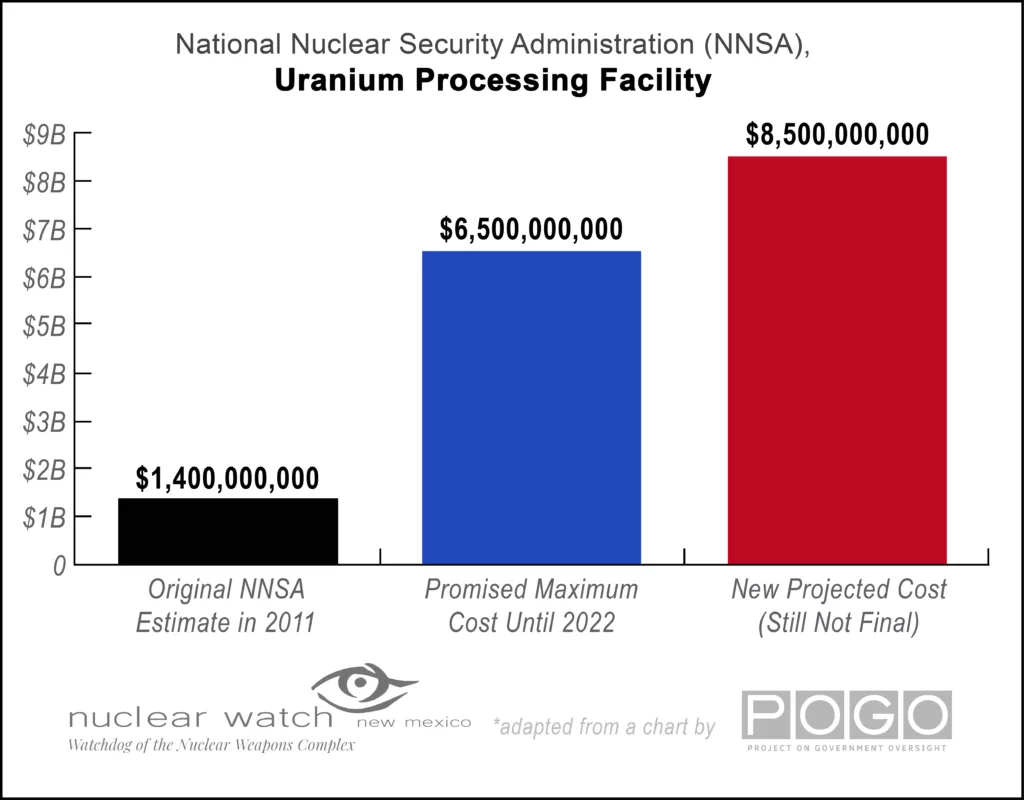 A current example is the Uranium Processing Facility (UPF) at the Y-12 Plant near Oak Ridge, Tennessee, originally estimated in 2011 to cost $1.4 to $3.5 billion. After costs started going through the roof, NNSA and Senator Lamar Alexander (R.-TN), then-chair of Senate Energy and Water Appropriations, swore that UPF would never go over $6.5 billion. But even after eliminating non-nuclear weapons production missions and a formal decision to continue operations at two old, unsafe buildings slated for replacement, the Uranium Processing Facility is now estimated to cost $8.5 billion. However, even that is not the final price, as NNSA is still to “rebaseline” UPF costs at some unspecified date.
A current example is the Uranium Processing Facility (UPF) at the Y-12 Plant near Oak Ridge, Tennessee, originally estimated in 2011 to cost $1.4 to $3.5 billion. After costs started going through the roof, NNSA and Senator Lamar Alexander (R.-TN), then-chair of Senate Energy and Water Appropriations, swore that UPF would never go over $6.5 billion. But even after eliminating non-nuclear weapons production missions and a formal decision to continue operations at two old, unsafe buildings slated for replacement, the Uranium Processing Facility is now estimated to cost $8.5 billion. However, even that is not the final price, as NNSA is still to “rebaseline” UPF costs at some unspecified date.
PLUTONIUM PIT PRODUCTION BRIEFING
Jay Coghlan, Nuclear Watch New Mexico January 17, 2023 | Email
GAO report: NNSA Does Not Have a Comprehensive Schedule or Cost Estimate for Pit Production Capability, January 12, 2023, gao.gov/products/gao-23-104661
- “NNSA’s Plutonium Pit Production Scope of Work Includes Dozens of Programs, Projects, and Other Activities Managed by Multiple NNSA Offices at Multiple Sites.” p. 19
- “NNSA Does Not Have a Comprehensive Schedule or Cost Estimate for Establishing its Pit Production Capability.” p. 40
- They [NNSA officials] said they did not want to introduce uncertainty about dates and wanted to avoid releasing preliminary or unpalatable information that was subject to change.” pp. 40-41
- “NNSA will have spent billions of dollars without having an overall idea of total program costs, or when program objectives, to include the capability to produce 80 pits per year, will be reached.” pp. 55-56
The Need for Independent Pit Aging Studies
June 16, 2022 | FACT SHEETS
Summary: The United States is aggressively expanding the production of plutonium “pit” bomb cores to at least 80 pits per year, which the Pentagon has called the number one issue in its $1.7 trillion plan to “modernize” nuclear forces. The average age of plutonium pits is around 40 years. Los Alamos Lab Director Thom Mason has said that “The best way to deal with this dilemma [of uncertainty about aging effects] is to take it off the table. We do that by making new pits, immediately.” Thus, he justifies spending tens of billions of dollars, creating additional occupational and public risks, generating more radioactive wastes with uncertain disposal pathways, fundamentally transforming the Lab into a nuclear weapons production site and fueling the increasingly dangerous new nuclear arms race.
But does independent review of pit aging data support this need to immediately produce new pits? The answer is no given that independent experts concluded in 2006 that pits last at least a century with no determined end date. Further, no future pit production is scheduled to maintain the safety and reliability of the existing nuclear weapons stockpile – it is all for speculative new designs which could raise reliability issues or even prompt the U.S. to resume testing.
Groups Fire Back at Feds’ Move to Dismiss Plutonium Pit Lawsuit
Federal agencies continue to reject a full review of the public safety and environmental risks of producing nuclear bomb cores at multiple DOE sites.
Jay Coghlan, director of Nuclear Watch New Mexico, commented, “The government has yet to explain to American taxpayers why it will spend more than $50 billion to build new plutonium pit bomb cores for new-design nuclear weapons when we already have thousands of existing pits proven to be reliable for a century or more. This has nothing to do with maintaining the safety and reliability of the existing stockpile and everything to do with building up a new nuclear arms race that will threaten the entire world.”
SRS WATCH / EIN PRESSWIRE October 26, 2021
AIKEN, SOUTH CAROLINA — Public interest groups shot back at the U.S. Department of Energy and the National Nuclear Security Administration’s attempt to suppress a lawsuit seeking a comprehensive environmental review of the agencies’ plans to produce large quantities of nuclear bomb cores, or plutonium pits, at DOE sites in New Mexico and South Carolina.
MEDIA ADVISORY – South Carolina Environmental Law Project and Nuclear Watchdogs Hold Virtual Press Conference
WHAT:
Public interest groups will hold a press conference for a major announcement of a forthcoming legal action as the U.S. Department of Energy and the National Nuclear Security Administration forge ahead with plans to drastically expand production of plutonium pits, the cores of nuclear weapons, at the Savannah River Site in South Carolina and the Los Alamos National Lab in New Mexico. The legal action follows previous unanswered requests from the groups to DOE and NNSA as seen in correspondence in February and April.
Biden Continues Trump’s Bloated Nuclear Weapons Budget
Will That Change in Future Years?
Santa Fe, NM – In a classic move that discouraged media coverage, the Department of Energy’s semi-autonomous National Nuclear Security Administration (NNSA) released its long delayed FY 2022 Congressional Budget Request around 7:30 pm EST Friday, May 28, at the very beginning of the long Memorial Day weekend.
Nuclear Watch New Mexico strongly opposed the 25% FY 2021 increase that the Trump Administration bequeathed to NNSA’s nuclear weapons programs. That massive increase was originally sold in testimony to Congress as essential to maintaining the nuclear deterrence but later revealed as necessary to cover NNSA cost overruns and blown schedules.[i]
NukeWatch Past Related Work
| 2020
March 10, 2020 Press Release Energy Dept. Nearly Triples Funding for Plutonium Pit Production Cuts Cleanup in Half But Refuses to Complete New Env. Impact Statement for Los Alamos Lab Santa Fe, NM – Today the Department of Energy’s semi-autonomous nuclear weapons agency, the National Nuclear Security Administration (NNSA), announced that it will not complete a new site-wide environmental impact statement for the Los Alamos National Laboratory (LANL). The last site-wide environmental impact statement was in 2008. April 3, 2020 Press Release DOE Ignores COVID-19 Threat, Diverts Resources to Planning for Nuclear War by Releasing Draft Environmental Study on SRS Plutonium Bomb Plant Today, in the middle of the growing coronavirus pandemic, the U.S. Department of Energy ignored the real national crisis and irresponsibly shifted its focus to planning for nuclear war, revealing plans to construct a Plutonium Bomb Plant (PBP) at the Savannah River Site (SRS) in South Carolina. April 21, 2020 Press Release >120 Groups and Individuals Ask Udall and Heinrich to Extend Public Comment Period on Los Alamos Lab Plutonium Bomb Core Production Santa Fe, NM – Today, on behalf of more than 120 groups and individuals, Nuclear Watch New Mexico sent a letter to New Mexico Senators Tom Udall and Martin Heinrich. It asks them to act upon their own words and demand that the public comment period be extended for plutonium “pit” bomb core production that the National Nuclear Security Administration (NNSA) is fast tracking during the coronavirus epidemic. As sitting members of the Senate Appropriations and Armed Services Committees, Udall and Heinrich are in strong positions to make that demand of NNSA. May 6, 2020 Press Release DOE Repeatedly Asks Safety Board for Time Extensions, Los Alamos Lab Asked for >150 Cleanup Milestone Extensions, But During Pandemic NNSA Rejects NM Senators’ Request for Extension of Public Comment on Plutonium Bomb Core Production Santa Fe, NM – Lisa Gordon-Hagerty, head of the National Nuclear Security Administration (NNSA), has rejected a request by New Mexico Senators Tom Udall and Martin Heinrich to extend the public comment period on expanded plutonium “pit” bomb core production because of the COVID-19 pandemic. In contrast, even in normal times NNSA and its parent Department of Energy routinely ask other government agencies for major time extensions when it comes to cleanup and independent oversight. Read/Download the Full Press Release HERE June 24, 2020 Press Release WATCHDOG GROUPS FILE LEGAL PETITION WITH ENERGY DEPT: Allege Agency is Slow Walking “Record of Decision” Re: Plutonium Bomb Core Production to Prevent Judicial Review; Stage Set for Litigation on Expanded Production Today, legal counsel for the public interest groups Nuclear Watch New Mexico, Tri-Valley Communities Against a Radioactive Environment, Savannah River Site Watch and the Natural Resources Defense Council took a significant step toward a potential legal challenge to the U.S. Department of Energy’s plans for expanded production of plutonium cores, or “pits,” for new-design nuclear weapons. Read/Download the Full Press Release HERE September 1, 2020 Press Release NNSA Slams Door Shut on Public Accountability While Ramming Through Expanded Plutonium “Pit” Bomb Core Production Santa Fe, NM – The National Nuclear Security Administration (NNSA) announced today that it will not prepare a new site-wide environmental impact statement for the Los Alamos National Laboratory (LANL). With this decision NNSA is slamming the door shut on public accountability while it rams through expanded plutonium “pit” bomb core production at the Lab. NNSA is relying upon outdated studies from 2008 to justify pit production. Since that time the agency has wasted billions of taxpayers’ dollars, another catastrophic wildfire threatened the Lab, serious deep groundwater contamination was discovered and LANL has had chronic nuclear safety incidences with plutonium that it can’t seem to fix. November 5, 2020 Press Release DOE Issues Controversial Decision to Pursue a Plutonium Bomb Plant (PBP) at Savannah River Site (SRS); Inadequate Environmental Review and Lack of Justification for Production of 50 or More “Pits” per Year to Modernize Entire Nuclear Weapons Stockpile Open to Legal Challenge The U.S. Department of Energy (DOE) today issued a formal decision that it will pursue a massive Plutonium Bomb Plant (PBP) at the DOE’s Savannah River Site (SRS) in South Carolina, in order to produce plutonium “pits,” or cores, for nuclear warheads. The provocative decision, which adds fuel to concerns about a new nuclear arms race with Russia and China, drew immediate opposition from public interest groups near DOE sites in South Carolina, New Mexico and California. 2019 June 10, 2019 Press Release Federal Government Meets Watchdogs’ Demand for Environmental Review of Expanded Plutonium Pit Production In a victory for transparency and legal compliance by the government, the U.S. Department of Energy’s National Nuclear Security Administration (NNSA) today published a “Notice of Intent” in the Federal Register to complete environmental reviews on its controversial proposal to expand plutonium “pit” production for new and refurbished nuclear weapons. Read/Download the Full Press Release HERE June 4, 2019 Press Release Noted Environmental Lawyers Warn Government Not to Expand Production of Plutonium Bomb Cores in Violation of National Environmental Policy Act and Public Review On behalf of three public interest organizations - Nuclear Watch New Mexico, Tri-Valley Communities Against a Radioactive Environment and Savannah River Site Watch – attorneys for the law firm of Meyer Glitzenstein & Eubanks and the Natural Resources Defense Council recently sent a 16-page letter to Lisa Gordon-Hagerty, head of the National Nuclear Security Administration (NNSA). The detailed letter warns the nuclear agency to not proceed with aggressive plans to expand plutonium pit production without first meeting its legal requirements for timely public review and comment under the National Environmental Policy Act. Read/Download the Full Press Release HERE May 31, 2019 Press Release Faulty Radioactive Liquid Waste Valves Raise Crucial Plutonium Pit Production and Safety Board Issues Last Wednesday, facility operations personnel entered a service room and noticed a leak emanating from a valve on the radioactive liquid waste (RLW) system. Upon subsequent visual inspection by a radiological control technician, RLUOB engineers believe that this valve, and 6 similar valves, may be constructed of carbon steel. The RLW system handles radioactive liquid waste streams from chemistry operations that include nitric and hydrochloric acids—carbon steel valves would be incompatible with these solutions. The suspect valves are also in contact with stainless steel piping, which would create another corrosion mechanism. RLUOB management plans to drain the affected piping sections and develop a work package to replace all of the suspect valves. They will also confirm the valve materials and if shown to be incorrect, investigate the cause of this failure in the design, procurement, and installation processes. The valves were installed in 2013 as part of a modification to add straining and sampling capabilities that were not in the included in the original design. [Please note that DNFSB reports are posted a few weeks later than dated.] This immediately raises two crucial issues: 1) the National Nuclear Security Administration’s (NNSA’s) plans for expanded plutonium pit production; and 2) the current attempt by the Department of Energy to restrict Safety Board access to its nuclear weapons facilities. Read/Download the Full Press Release HERE |
| 2018
November 16, 2018 Fact Sheet Expanded Plutonium Pit Production for U.S. Nuclear Weapons Plutonium pits are the radioactive cores or “triggers” of nuclear weapons. Their production has always been a chokepoint of resumed industrial-scale U.S. nuclear weapons production ever since a 1989 FBI raid investigating environmental crimes shut down the Rocky Flats Plant near Denver. In 1997 the mission of plutonium pit production was officially transferred to its birthplace, the Los Alamos National Laboratory (LANL) in northern New Mexico, but officially capped at not more than 20 pits per year. However, in 2015 Congress required expanded pit production by 2030 whether or not the existing nuclear weapons stockpile actually needs it. This will support new military capabilities for nuclear weapons and their potential use. Read/Download the full fact sheet pdf HERE
Watchdog Groups Claim Nuclear Agency is Moving Forward to Manufacture New Plutonium Bomb Cores in Violation of National Environmental Law and Public Review Nuclear Watch New Mexico, Savannah River Site Watch, and Tri-Valley CAREs sent a letter of demand to the U.S. Department of Energy’s National Nuclear Security Administration (NNSA) to inform the government that its plan to quadruple the production rate of plutonium bomb cores is out of compliance with the National Environmental Policy Act (NEPA). NNSA’s premature plan to quadruple the production rate of plutonium bomb cores (“pits”), the heart of all US nuclear weapons, is out of compliance with requisite environmental law, the groups argue, as NNSA has failed to undertake a legally-mandated programmatic review and hold required public hearings. View/Download the entire press release HERE |



